#anyway anyone who wants to add me as a friend on duolingo is more than welcome to
Explore tagged Tumblr posts
Note
in 2016 i picked up duolingo for the first time to learn french because i wanted to read asterix comics in their original language. it is now 2023 and all i learned was that asterix and obelix are even gayer in french. also nice to see a cacofonix enjoyer i love the goofy lil guy
Is that so? It's the "bonne nuit beau gosse" and all the "mon Obélix" isn't it? Oh I'm dying to see the original gayness 👀🏳️🌈🇲🇫 I studied french in high school, also in 2016 (lol! the year of french apparently), I don't rememeber much now. But I recently decided to pick it up again on duolingo... take a wild guess why.
I love Cacofonix! Such a pleasure seeing fellow Cacofonix enjoyers around. I started this blog with gaylois shenanigans in mind and while it still is that it's also slowly but gradually starting to become a Cacofonix daily page. I mean, not that anyone's complaining. You know what... I feel pretty beaten down today but your ask made me smile. I decided to draw a little Cacofonix for you as a treat (and for myself, I'm not even gonna lie, drawing him is extremely self indulgent) <3
POV: you give him a much needed compliment that he didn't expect

It was about time I drew him with this lovely pink scarf he was wearing in La Zizanie! Goofy lil guy in his goofy lil scarf for a goofy lil serotonin boost




#asterix#cacofonix#assurancetourix#ask me#alisterix#my art#if you mention Cacofonix in my asks you get a drawing I don't make the rules#actually I totally do and I love it#la zizanie#astérix#asterix and the roman agent#how does Cacofonix look so good in everything no matter what???#gay people are built like that ain't they#anyway anyone who wants to add me as a friend on duolingo is more than welcome to#I need friends#my name is alisterix like the name of my account#why does this drawing lowkey look like it's a dating sim where you get to romance Cacofonix lmfao#I want him to have a boyfriend so bad
48 notes
·
View notes
Text
Types of flowers langblrs have in their garden...
chamomile early morning study sessions, drinks tea instead of coffee, tells their friend what something is in x language because they! know! it! even when no one asked, gets nervous when they need to speak, posts vocabulary lists
lavenders has a fully planned out schedule, very organized, utilizes their time efficiently, has their goals written down, probably achieves them in time or even before they planned, posts infographics about studying
daisies language challenges, studying their target language when they have the time, can speak and listen better than they write and read, gives compliments in their target language to see people blush, has a playlist of songs in their target language
roses learning a romance language, dark academia, reads in their target language in public on purpose, orders coffee for the aesthetic but actually likes it, planning a trip to where their target language is spoken
lilies spends more time learning about culture than actually learning it, was actually pulled into studying their target language, but makes an effort for how excited their friend is once they say something, probably tried showed off in front of said friend by ordering food in that language
dandelions tries to cover all their languages everyday, can’t help but add another course on your duolingo to ‘try it out’, sprouts random words when someone asks them to say something in x because they won’t know if it’s grammatically correct anyways, actually likes grammar
hydrangeas reblogs vocabulary lists for ‘later’, probably lurked around the community before joining, hoards resources, learning through tv shows, dramas, anime, etc., trying their best, always going back to a language app when you don’t have the time to study *cough* duolingo *cough*
What flowers do you have in your garden?? It doesn’t have to only be one!
I have a chamomile dominant garden, with 2 daisies, a few hydrangeas and one lily, rose, and dandelion. (this makes me want a cup of chamomile tea so bad (´。_。`) )
Taglist: @oreos-and-pepitos @lagom-languages @breadlanguages @ddalgiskoreanblog @thefakepolyglot @yukikoekahara and anyone who wants to do it!! (you don’t have to tho uwu)
~feel free to add more flowers~
#langblr#studyblr#languages#language#study#polyglot#academia#dark academia#studying#bilingual#multilingual#language learning
305 notes
·
View notes
Text
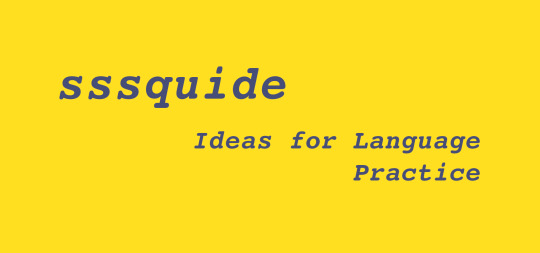
Hey there friends! I’m currently working on creating a language routine for myself to study Spanish, and I know how crucial it is to have a variety of activities that help in different areas when you’re learning. I am currently enrolled in a Spanish 1 class, and I am very active on my Duolingo, but I’m also a big advocate for immersion learning. I want to be using the language while I’m learning it, rather than reading over notes and whatever. I’m also a fan of mixing active and passive forms of language use. Here are some of the ideas that I’ve compiled so far that I’m going to start trying to implement:
Talk to yourself. I don’t know about you, but I talk to myself a lot anyways, so why not do it in your target language? Narrate what you’re doing. Bonus points for trying it in different tenses!
Keep an audio journal. Then transcribe it. Speaking is where I’ve always struggled the most when it comes to learning a language, and that is the primary reason I decided to take 3 years of Latin in high school instead of continuing the French I learned in middle school or the Spanish I learned in elementary school. I hate feeling dumb, and trying to speak when I know I’m going to mess up makes me feel dumb. But if I ever want to reach fluency, I just have to suck it up. The good thing about recording yourself is that you don’t need to share it with anyone. But I firmly believe it’s super important to listen back to it and transcribe it, because you will totally notice the mistakes you made when you do so. Then maybe try rerecording it?
Teach the people around you, even if they aren’t particularly interested. When I learn new words/grammar structures, they are staying in my active memory. So, when I’m talking to my partner, sometimes I’ll use the Spanish I’m learning instead. He is not learning Spanish, but he is a very good sport, so he lets me explain to him, in great detail, what I was saying to him and the grammar structures involved. I’m not saying to do this with everyone (some people will find it annoying), but if you can find someone who doesn’t mind it, take advantage of it.
Search for listening practice on Youtube. Try to find different accents in your target language too. At least for Spanish, there are tons of people who create listening practice for all levels. Find them! Make a habit of actively engaging with this material. Repeat what they’re saying, look up words you don’t know, rewind if you didn’t get something. I try to find native speakers from both Spain and all around Latin America, because there are many different accents in Spanish, and I don’t want to limit myself.
Find music you actually like to listen to. Even if you don’t understand what they are saying. This is made 1 billion times easier if you know what kind of music you like. You will not get far if you just look up “music in Spanish” because you “just listen to everything”. That’s a lot of music to sift through to find something you actually enjoy and will want to listen to again. If you have a genre you like though, you can easily find playlists on Spotify or Youtube that Spanish speakers who like the same genre as you put together. I, for one, listen to a bunch of Spanish punk bands, because that’s the music I like. I also like indie rock, and I have some bands in those genres that I will put on even when I’m not actively studying Spanish, because I actually like to listen to them.
Watch children’s cartoons. Bonus points for animation that you dig. As a beginner, there is a shit ton of stuff you’re not going to understand, even in cartoons made for 5 year olds. Don’t worry about it. Actively hearing the words and trying to follow the story WILL help, and you might pick some stuff up along the way too. The reason I say find stuff with animation you like is the same reason I said to find music you like: it will make you actually want to come back for more, rather than feeling like a chore.
These are the ones that I plan on trying to implement into my life. What do you do for practice? What else should I add to the list? Let me know!!
102 notes
·
View notes
Text
french in 1.5 years anon
Kinda random but I just found out that I’ll be required to be intermediate/advanced in French by the next 1.5 years; ALL I KNOW IS THAT MEIRDE IS A BAD BAD WORD! Idk if you’re a native speaker but I was wondering if you could provide me of any good French language resources (or language in general since I’ll be needing to learn Arabic soon as well), and like tips for language learning and how to go about it? Sorry to bother you haha this is MY stress but I appreciate any help! Have a great day!
HEY. so i really fucking dropped the ball on this one, i’m sorry. 2019 has been one health fiasco after another (or more like the same fiasco again and again) and i kept telling myself i want to sit down and make a proper post for this, until i realised that that’s just never going to happen given the way things are rn. and i’d rather give you a quickly-written post which is actually helpful than never write that perfect bullet-pointed one.
first of all, i’ve been in your EXACT position (so no, i’m not a native speaker) except i had about...six months to go from je m’appelle teesta to voyez-vous, le problème qui se cache derrière tout ça n’est pas le manque de respect mais la personne dont il s’agit or whatever. i was like, i can so do this. (spoiler: i didn’t, because i was 18 and overconfident and stupid and didn’t actually know how to learn a language.) GOOD NEWS: having learned 3 more foreign languages since then, i am now REALLY GOOD at learning languages REALLY FAST. 1.5 years is a good amount of time, so don’t stress.
i’m going to go generic on this, with some extra tips about french since i speak it, unlike arabic.
first thing, that typical thing everyone hates to hear but knows is coming from the mouth of an accomplished person (pat on my back) in any field whatsoever: you’re going to have to work really hard and practice like fuck.
there’s just nothing else that can replace it. i’ve filled up notebooks and notebooks with japanese verb conjugations, once i did like 1800 of them in one sitting. but you better believe that a bitch will never forget those now. resign yourself to putting in at least three hours of your day to this until you get to the level you need. (and three hours is...kind. at my peak i was literally reading through french dictionaries at the library, 10 AM - 8 PM. i treated it like a workday.)
now, what you need to establish is: are you a hands-on learner or a digital one.
i don’t really care for all the auditory learner and visual learner stuff, i don’t know about anyone else but i personally used those as excuses to avoid certain exercises. unless you have actual disabilities preventing you from accessing certain methods of learning, you can train yourself into anything. it’s a matter of practice. i could barely understand a new song without reading its lyrics first, now i eat up podcasts.
SO. the question here is different. a hands-on learner, like i used to be more or less throughout my bachelor’s, is someone who absolutely cannot retain information unless they’ve written it down BY HAND at least once. pen and paper. (i’m still like this but i’ve learned to combine it with digital methods to go faster.) if this isn’t a hurdle for you, congratulations. your process is going to go that much faster, at least for french. (you’ll have to spend hours practicing your written arabic however, if you’re not familiar with the script.)
now, if you’re a hands-on learner, you need to add an extra hour to your daily time. no matter how fast you write, you will take that time. and you cannot shorthand your way into languages. you need to understand how french is spelt, what accents it uses, that they put a space before exclamation points, question marks, and semicolons. (side tip: learn the IPA. it will be useful to you forever in language learning, at least for the romance languages.) i’m not gonna teach you how to make notes since i’ve never benefitted from copying someone else’s style, so if you don’t have a set method start establishing that. you need regularity and rhythm when you learn a language. my grammar notes look the same regardless of the language. i don’t have my french ones since it’s been years and i didn’t take good ones then anyway, but here’s my japanese and russian stuff.
JAPANESE NOTES // RUSSIAN NOTES
now, it bears mentioning that these notes are NOT the notes i take when i don’t know shit. these are final level notes. they’re brief, idiosyncratic, and only reminders. something to refer to when i’m revising and suddenly forget a rule. the first notes i make are much more elaborate, whether they’re pretty or not. i’ve gradually lost the fucks i had about really going ham on academics so my russian notes are very messy, but my japanese ones from back in the day are magnificent. here’s a look. during lesson one i realised that japanese and my mother tongue, gujarati, are syntaxically similar as shit, and i started taking notes with references in gujarati. it sped up my learning process 2x while my french classmates were still going “BUT WHY IS IT LIKE THAT”.
PRACTICAL GRAMMAR // THEORETICAL GRAMMAR
if you plan to learn more languages in the future, this will be so valuable. sometimes a phrase i learn in russian doesn’t make sense in its french explanation, but a phrase in english might use the same logic. bam, put down the translation in english then. you get what i’m saying? the more languages you learn, the easier it gets to learn languages.
now if you’re a digital learner, i’ve got great news for you. duolingo and anki are your best friends. duolingo’s memed to hell and has a system that might not work for everyone, but they’ll do the brunt work of compiling grammar notes for you in the beginnings/ends of their lessons. note those down and transform them into anki flashcards, and you can learn grammar concepts without doing 20 exercises. (do those exercises if you can, though, nothing beats mindless practice.) now anki is an intimidating-looking but actually super intuitive app that basically builds digital flashcards for you and shows them to you in a rhythm based on your own learning speed. it’ll show you the front of a card, let’s say merde. you say the english translation out loud, shit, and hit enter. correct! was that easy? anki’ll show it to you in 10 minutes. hard? it’ll show you in 1 minute. super easy? merde won’t come up again until tomorrow. eventually you get so good at it that you can bury a card for 2 months. anki will also show you the same cards reversed, which is harder but trains you better. you’ll see shit and have to remember what it’s called in french, which is more difficult than you’d think it is.
you can use anki for more than just vocab, like i mentioned. it’s a little tricky learning to convert grammar concepts into front/back flashcards, but you can do it. for example, here’s a sample of one of my russian grammar cards:

front ^^

back once i hit enter^^

see? not that difficult. now don’t be an idiot like me who manually entered every single flashcard into anki. you can find pre-made packages online (but you can’t guarantee they’ll be correct) or you can make your own without killing your fingers. what you wanna do is open up a spreadsheet and make two columns, A for front of the card and B for back. it’ll look like this:

then you’re gonna save that spreadsheet as a .CVS (comma separated values) and import that into anki. bam, your flashcards are made for you with half the effort. there’s also a script floating around somewhere to make excel translate words automatically for you, but i don’t recommend that unless they’re really easy words. google translate can fuck up. reverso is your friend.
you need to review your anki cards every day. it’ll take less and less time as you go along. i can review 300 russian cards in 15 minutes now. but you need to keep the rhythm going. download ankiapp and sync your cards, review them on commutes or in the hallway or whatever. trust me, it’s magic.
apart from this, if a traditional textbook helps, go for that. i’ve always used textbooks and workbooks, more as supports than as principal methods, but it does help. it’s structured and organised and these people know how to train you. bescherelle is a good go-to for french.
media is always a great way of immersion too, until you get to the country itself. it’ll show you how french people speak french. when i first came to france i didn’t have that experience and even though i spoke an arguably decent amount of french when i got here, it was like, if this is french then what the fuck was i learning in high school. if you like watching movies this is your chance. watch the classics first so that you can get an idea of french pop culture. amélie (though the pop culture aspect here is about shitting on it) and les intouchables, for starters. watch your favourite films, first subbed, then subbed and dubbed, then just dubbed. i watched all ten seasons of friends with french subs, it was wild. with music you want to start off with some indie-ish singers since they will universally sing softer and slower, making things easier to understand than idk, la tribu de dana. (if you’re into bts there’s a hilarious video of their baepsae choreo set to la tribu de dana.) anyway - angèle, cœur de pirate, céline dion, fréro delavega, uhhh that fucking french sufjan stevens. what’s his name. VIANNEY. don’t fucking listen to biglo and oli or like, fatal bazooka right away. you will not understand shit. i barely understand it. white people are wild. ooh listen to stromae. orelsan too, he’s a rapper but he has a relatively clean diction imo. he also sang the french opening for OPM. they call him orelsan-san in japan.
last but not the least: if you have the opportunity to interact in french with people, DO IT. native speakers will do their best to help you and be kind about it. people who learned french might sometimes be assholes from experience. it’s a whole superiority complex thing, and very hypocritical. anyway - online or IRL, wherever you can practice your french, do it. it’ll be immensely helpful. there’s nothing like the frustration of not being able to express simple things to get you motivated to get better. do your best to immerse yourself - changing the language on your devices can make a difference too.
i think that’s all i have and again, i’m sorry for taking this long to finally deliver, thanks for your patience! if you have any specific questions don’t hesitate to hit me up, on anon or not.
good luck - it’s not going to be the easiest but nothing is as gratifying as beginning to understand the workings of a language. you’re gonna love it!
19 notes
·
View notes
Text

* medalion rahimi, age 24, she/her | oh, them? that’s ghalia majid. they’ve lived in carina bay for, like, twenty four years. last time i spoke to them they were a sports journalist, and if i remember correctly, they’re a cancer. seeing them around always makes me think of keys clicking away on a keyboard, floral printed skirts and birds chirping in the morning. ( lissa, 21, est, she/her )
hey guys it me lmao i’m so excited to bring ghalia here, i’ve been playing her for a while now and love her a lot so i hope u guys do too cus i love it here and i think/hope she’ll fit in great!! this whole intro post is pretty much taken from a bio i wrote for her i just kinda cut it up and added some new things to switch it up so here ya go!!
ghalia is always set out to do the right thing and she’s definitely a #momfriend type. making sure her friends and everyone around her is ok or asking if they need anything/being concerned is a huge part of her personality.. even if it can be overbearing at times. she sees the world in a positive light rather than the much more realistic hell hole it can be. sometimes this can make her seem naive, but she’s just someone who finds it more beneficial to see the good side of things.
she can be kinda nosy and annoying like … no joke about that. she loves taking care of people but she can also be kinda invasive and too In Your Face about it without even realizing. she absolutely means well but sometimes doesn’t see herself crossing a line until it’s too late
she’s also quite ambitious and believes that people can achieve anything they want to (motivational speaker much?) she always has her sights set on something bigger than herself and for the most part, she feels like her potential has no limits. she thrives off of opportunity and optimism even if she lives in her head a lot, and even if what’s brewing in her head really makes no sense or has no possibility of ever happening. she looks at life as en empty canvas, just waiting for her to fill it with her thoughts and desires but as most things are, it’s easier said than done.
this doesn’t stop her from wanting the greatest life she could possibly have, but she has high expectations for herself and doesn’t want to fall short of them. with this kind of personality, it may seem like she’s isolating herself from others when she has her mind set on something, but she’s an extrovert through and through and loves people, but sometimes has a hard time bursting out of the dream space in her head.
she’s been this way since she was a child. her parents are both immigrants, they came to american from tehran, iran in the 80s and created a new life themselves and worked to make sure their children had better opportunities growing up. they ended up in new york at first for their careers (her mom is a teacher, her dad is a professional photographer and he teaches lessons at a studio) and eventually settled in carina bay before ghalia was born because it seemed like a great place to raise a family. ghalia looks up to them like no one else, she admires their courage and their strength and their tenacity to never settle for less than what they deserve. so it’s because of them, not just blind hope, that ghalia reaches for the even beyond the stars and keeps reaching even when her arms can’t go anymore.
although she’s a bright and spirited person who always wants to do right by others, that also causes ghalia to have a number of downfalls that all add up and can create quite a monster of an emotional mess. she’s stubborn and a special kind of reckless; feels embarrassed admitting she failed at something she put all her effort into even when the horizon that is the finish line really wasn’t as close as she thought. disappointment is her enemy yet she comes face to face with it often, usually from her own doing. she wants to know everything all the time, her curious mind wanders and wanders until it finds trouble she never knew existed. when she drills too hard into conversation and hits sore spots and doesn’t realize it until she’s made everyone around her uncomfortable– she wants to be open with people, when it’s not always possible. not everyone can relate to the positivity she thrives on and that frustrates her sometimes.
other tidbits/fun facts:
ghalia has always been interested in writing and photography (something she got from her dad), the two have been her main creative outlet growing up. she majored in journalism at wake forest university and decided to focus on sports as she grew into her career path and works for a local newspaper covering mostly soccer through the nc courage and north carolina fc!
she played soccer growing up and into highschool and thought she might continue into college but honestly she wasn’t THAT good and decided the sidelines were better suited for her anyways where she could help behind the scenes and volunteered wherever they needed her and she was also the team photographer for a while
((listen i’m a huge sports nerd so why not live vicariously through her lolol))
she’s a very talkative, very social ‘lil thing. she’s always been that kind of kid in school who got moved for talking to the person sitting her, but she was also that person who talked and talked no matter if her neighbor was a stranger or not. that gets her into trouble sometimes. she can be overwhelming when having conversations, she always has a million things to say and usually not enough time to say it. also, not everyone always wants to hear the oh so thrilling details about her walk back to her apartment yesterday, but she’d swear on her life that you *need* to hear about the squirrel that followed her the entire way. bottom line is, she loves to talk but needs to be told to shut up every once in a while. it’s only for her own good.
she’s a lesbian and very into girls although she’s kinda shy about dating and has only been in one serious relationship
besides her main passions/hobbies being photography and writing, ghalia also enjoys nature, staying up late reading wiki articles on conspiracy theories, watching paranormal story time videos on youtube at 4 am, and she also wants to learn as many languages as she can. for now, she can speak conversational farsi, the language that, outside of english, is the main language her family speaks, and it’s important to her that she’s able to keep in touch with her relatives still living in iran. she’s not so great at writing it quite yet but she’s working on it. she’s not too bad at speaking spanish, she took several years of classes ever since middle school and falls in and out of practicing it currently. she’s attempted french and german, but only got as far as a couple activities on duolingo before her attention got dragged to her next project. one day she’ll be fluent in them all, one day.
her family is her heart, she’ll defend them until the day she dies and longer, they’re her lifeline and especially her brother, reza majid, who’s 5 years younger and the apple of ghalia’s eye. she has a protective nature about her and that’s due in part to how much she loves her family and little brother, and only wants the best for them, and she feels that way about everyone she cares about.
some connection ideas i just thought of!!!
childhood friends - from like age 4 or something like weeee lil things since ghalia has lived here her whole life, that’d be cute
roommates - it’d be fun if they got along really well and were friends beforehand we love a cute roommate connection
coworkers - from the local paper she works at mayhaps??
former teammates / college friends - ik wake forest is very specific but it could also be friends/teammates from high school or something like that :^)
i’d also love some kinda former relationship?? i imagine her to only have ever been in one real serious relationship, maybe kinda recently or something and it was a big deal and had a big impact on ghalia and maybe there’s lingering feelings or unresolved feelings, idk!!! we could work it out!!
id LUV a ride or die friend or multiple
also maybe someone who can’t stand ghalia bc she’s nosy and annoying
i don’t know im going out to dinner soon with my fam so i haven’t thought much more about plots but i’m open to all and any ideas! if anyone wants to chat on discord feel free to hmu there @ #lissa7602 or here in the IMs!!! <3333
#carinaintro#HI again#i gotta run but i wanted to post this before i left#i hope it all makes sense <333
5 notes
·
View notes
Text
ECUADOR + GALÁPAGOS
¡Bienvenidos! Once again, I’m late to post - it’s been almost a year since our first trip to Ecuador, but to be fair, I did actually start writing during the trip this time. Since then, I’ve returned to the Galápagos twice (and will be heading there again in two days!). By the end of the year, I plan to earn my certification in teaching English as a second language and move to Isla Santa Cruz to teach.
Update 12/2017: I have now been to Ecuador 5 times (4 of those times in Galápagos), and will be returning in two weeks to study in Montañita with the CELTA program at International House Montañita. New post on the other locations I’ve visited in Ecuador coming soon, right after my delayed post on Costa Rica!
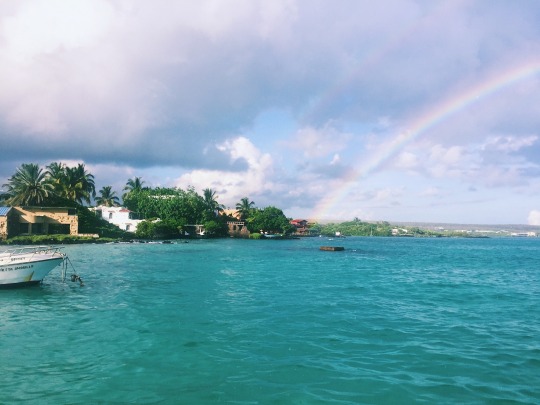
7/22, Friday: DAY 1: QUITO
I have to admit, before we left for our trip to Ecuador, I was nervous. I had done most of the planning for us with looking into hostels, places to visit, and the time and cost of bus transportation between cities for months in advance, but I still felt unprepared the week before my departure. My Spanish was limited at best (4% fluent according to DuoLingo), and I had been reading way too much into safety precautions for traveling on public transportation and exploring the cities after dark. Add to the list that I somehow saved getting my vaccinations and securing my bank account arrangements to just the weekend before my departure, the realization that I would never catch up on PokémonGo upon my return, and suddenly I was freaking out.
Now that I’m beginning to write this during our last weekend in Ecuador, I realize how absurd I was being, but I’m grateful for some of the tips I learned (and for the most part, ignored) during that panic. One of the most important to remember is that while traveling in Ecuador, although US currency is standard (since 2008), big bills are not common and rarely accepted at vendors or casual restaurants. You can most likely exchange 20s or higher at banks, bigger supermarkets (SuperMaxi), or break for change at fancier restaurants, but you’re better off carrying 1s, 5s, and 10s. Single dollars will usually be given back to you in coin form, and there are also 50 cent coins in addition to the mix of US and Ecuadorian 25, 10, and 5 cent coins. I also learned that Banco de Pacifico charges the least for ATM fees ($1.58) as opposed to our unfortunate first choice of Bank Pichincha - which charged an unbelievable 20% of the withdrawal amount. Can you blame me for choosing the bank with a black/yellow logo and name like Pikachu?
Update 12/2017: After multiple visits to Ecuador, I now realize that Banco Pichincha does not charge any ATM fees at all. I’m not sure whether this was also true when I originally wrote this post, or if I made a mistake and misread my ATM receipt! Either way - Banco Pichincha is the way to go! (I use a bank-issued Visa debit card from Investors Savings, which allows me 4 free foreign ATM transactions per billing cycle).
The other precaution I read was to only take taxis with orange license plates, and to ask the driver for the fare price or to start the meter before the ride. I honestly didn’t follow the latter at all, because even in instances when we were likely charged “more than average,” the fare never exceeded $10 (except for long drives to/from the airport in Quito) and I always tipped an extra dollar or two anyway, which isn’t standard either but everyone is so damn nice I wanted to tip them all. More on the former rule later, when we maybe almost get kidnapped because I trust people too easily (sorry mom!).
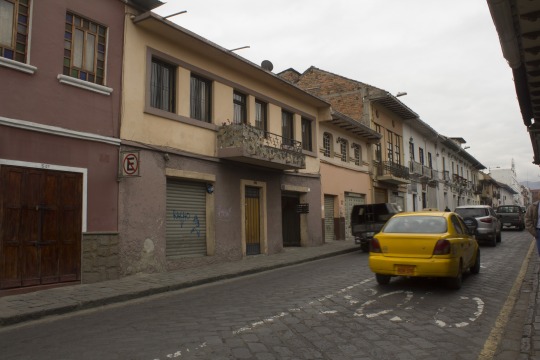
The fact is, I’ll talk to anyone. Most people will tell me that I’m not careful enough, but you won’t believe the amazing people I’ve met, secret places and deals I’ve found, and stories I’ve heard because of that. In this trip alone, I’ve met some of who I think are the best people in the world, and I’m constantly reminded in my travels how much love and light truly exists in this sometimes very scary world. Just remember that despite the negativity we have to sift through daily, there are always incredible friends just waiting to meet you in every corner of the Earth.
We started our trip in Quito, where we arrived to Mariscal Sucre International Airport late at night. We were picked up by Guillermo, who met us at the terminal and drove us through quiet streets to our first hostel, El Hostelito (~$14/pp per night for individual pods). When we arrived, we entered through a giant steel gate door lined with barbed wire above, then walked up the stairs to get to another door leading into the hostel. As we checked in, we asked our hostel hosts if there were any places to eat nearby, but she said she doubted anything was open. She offered to call us a taxi, but when we said we would walk instead, she cautioned us to watch our belongings when we went out. I’m not sure if it was just because it was late, or that she was so adamant about not walking around, but we felt immediately insecure and made it only a few blocks, passing a closed Pizza Hut and a closed Domino’s (on the same block, I swear) before deciding to turn back around. We ended up finishing Will’s bag of Cheez-Its while watching some really terrible TV.
The next morning, we woke up to the breathtaking views and altitude of the mountains surrounding us, and headed to the bus station for our first destination. Of course, one of our first meals was a quick one at the station, but definitely worth it. For $1.50, I tried my first humita, a steamed fresh corn cake wrapped in corn husk - like the most magical cornbread ever. Will shelled out a little more cash ($4) for a full plate of steak, rice, salad, avocado, and papas fritas.
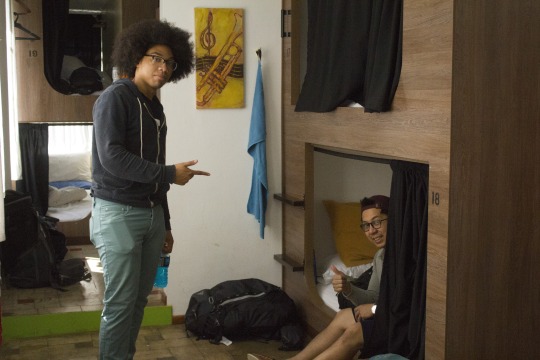
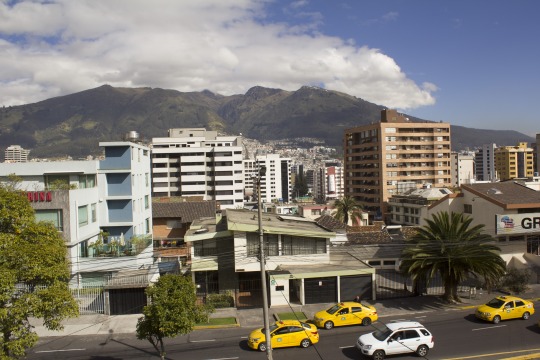
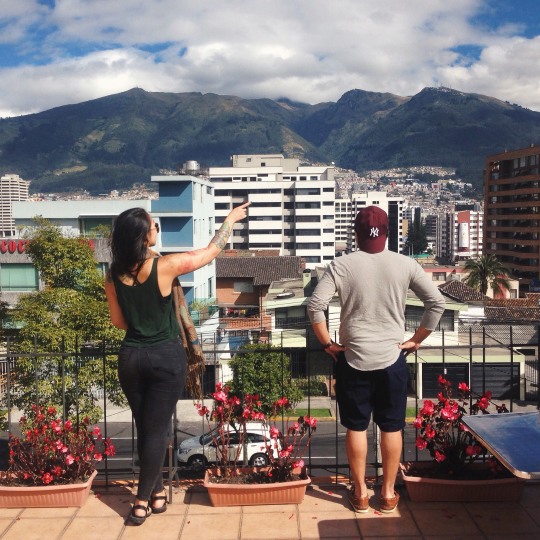
7/23, Saturday: DAY 2: BAÑOS
The bus ride to Baños ($4.50 from the Terminal Terrestre Quitembe, about 3 hours) was unbelievably beautiful. I watched in awe as we carved through the mountains, clouds floating just above the green peaks of trees and land.
Baños de Agua Santa (“Baths of Holy Water”), commonly referred to as Baños, is a city in eastern Tungurahua Province in central Ecuador, named after the hot springs located around the city which have a reputation of having healing properties due to their content of various minerals. It is known as the “Gateway to the Amazon,” as it is the last big city still located in the mountains before reaching the jungle and other towns that are located in the Amazon River basin. Baños is located on the northern foothills of the Tungurahua Volcano, at an elevation of 1,820 metres (5,971 feet) whose activity has been characterized by frequent powerful ash explosions and lava flows can be seen from the town. The last time the volcano erupted in October 1999, all 17,000+ residents were forced to evacuate the city for weeks.
(source: Wikipedia)


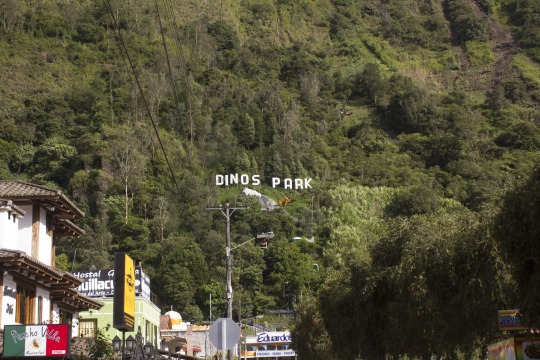
When we arrived, it was late afternoon so right after we checked in to Hostel Chimenea (~$14/pp per night for a 3-bed room), we headed out to catch the last of the slivers of sunlight spilling onto the nearby waterfalls and setting behind the cathedral square. Foolishly, we took the advice of our guidebook to eat at a local café called Café Hood, which despite its delicious meals, offered no authentic local cuisine. At least we got to taste some of the handmade sweets on our way back, including a taffy candy spun on wood, unique to Baños. We actually had stopped to buy some colorful hard candies ($1 per bag) but the woman who owned the cart was so friendly that she kept slipping in taffy into our bags for each bag of candy we bought.
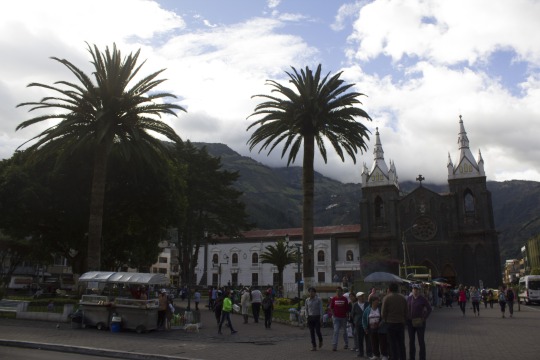

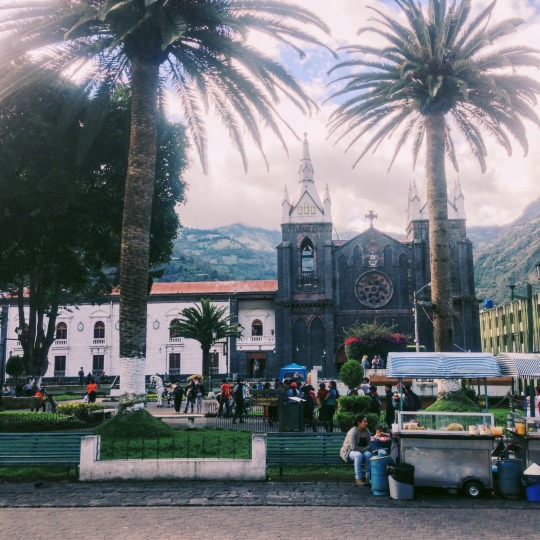
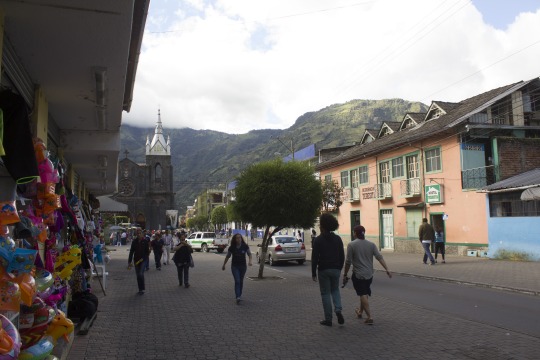
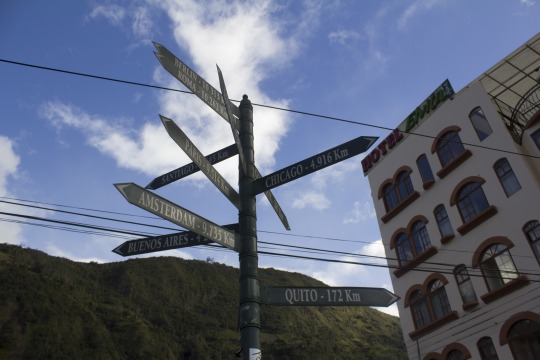
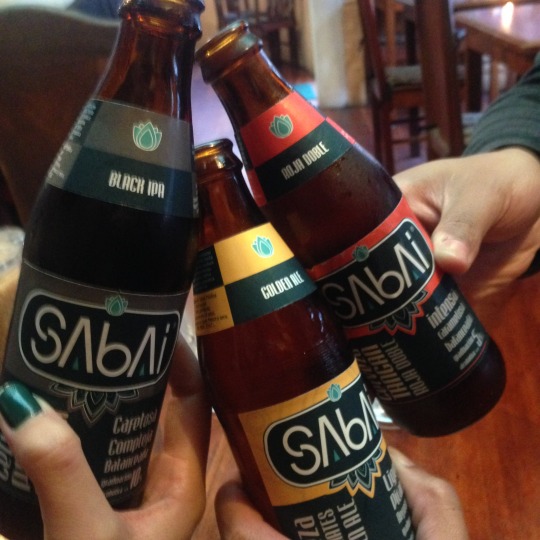

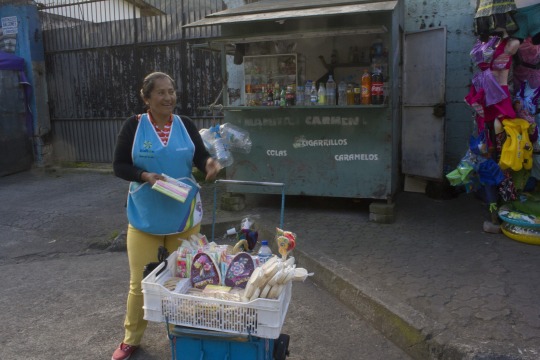
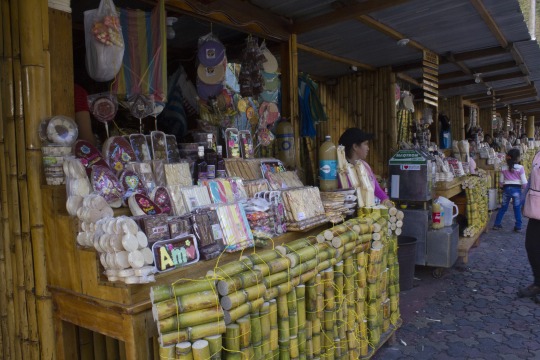
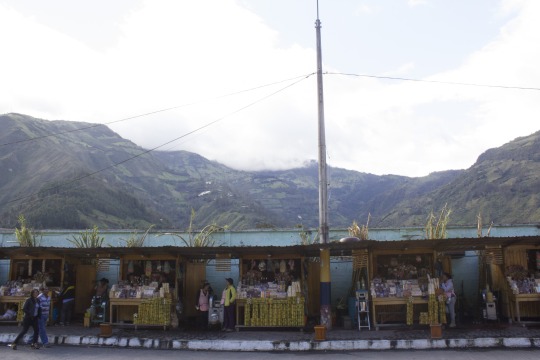

That evening, we headed out to the square to check out the bar scene. At the time, it was only around 7pm so all of the bars lining the streets in the center of town were still pretty empty. We settled down at a spot blasting rock music from its open front, where we met the only other bar patron, Mike.
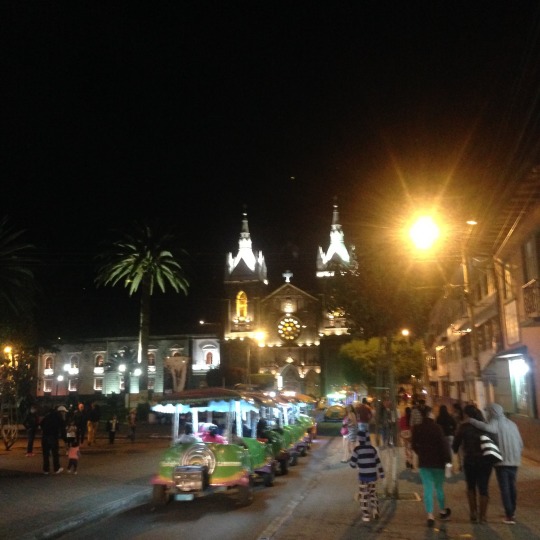
Mike is a United States Navy veteran, who fought in the Vietnam War and has been living in Baños for just about a year, after spending eight years living in Argentina. Like my brother Nathan, he has a deep admiration for Latin America, and like my brother Jordon, was an engineer (mechanical) before retiring. Despite his practicality, Mike is an empathetic man, with a love for the arts; especially music, which he “can’t listen to for too long otherwise I start to become real emotional.”
Immediately upon beginning our conversation, I knew I was meant to meet this person. I don’t mean that in any religious connotation, because like Mike, I don’t quite believe that religion is anything more than “the oldest form of government; they tell you what you can and can’t do, and then they say - by the way, we want your money.”
I just knew that conversation had to happen, then and there. In two hours, Mike gave me answers and asked me questions that I had been searching for and yearning to discover, but simply needed to hear from the right person to truly understand. He had lived a lifetime of wanderlust, with 52 countries and every state in the US of A in all their glory under his belt, which he traveled through on his motorcycle (like my roomie Ethan!). Mike had been through it all, and he was still living for more. I listened to his stories intently, hoping to gain some knowledge from his experiences as he recanted years of his life and all the wisdom that came with that.
He was so unabashedly honest, and I admired that. He didn’t hesitate to admit that because of his time in the war, he often had to come face to face with discrimination against Asians that spurred from that, and he hated that part of himself. As a first generation Chinese American, who has had my fair share of negative encounters with shallow-minded people, I had never heard this side of the story before. It was interesting to hear someone speak about a quality of themselves they hated, and has failed to change at his deepest core, to a person who could very well take offense by it. After Mike returned from the little boys’ room, he said that he wanted to clarify what he meant; that the bad memories create bad expectations of the associated culture he fought as he defended our country, but that he absolutely respects each and every individual and will never allow anything trump that. He then confessed, “I’m a human being and I’m not perfect, but I’ll always be honest.” That commitment to honesty brought up some curiosity from my end, including asking how he managed to live a life so full of travel. While he admitted the Navy funded a good chunk of the start, he told me of the two businesses he successfully built and ran, one of which he sold to an employee for $1 after his wife passed away. In his words, “your ability to adapt is your strongest quality. If you fear nothing, you can do anything.”
It sounds cliche, but that motivation was everything I needed to hear at this point in my life. I’ve never pictured myself settling into contentment, and yet I fear change just as much as anyone else. Mike reminded me that as long as I’m breathing, it’s never too late to learn anything - even how to love. Mike lost the love of his life 21 years ago to breast cancer, and even as he spoke of her to me, his eyes began to well up with tears. She was his second wife, after being divorced for 12 years “with a different girlfriend on my arm each week.” And yet, six months after their first blind date, they were married.
I asked him how - how he knew she was the one, how he could make such a drastic change, and how he made all those years work. The first two questions, he didn’t have much of an answer to. It was the same old spiel of “you just know,” but his answer to the third really stuck. He said that each month, both of them would sit down and tell each other what they had been annoyed with that past month and hoped to improve, and the other wouldn’t be able to respond until a week later, “because time allows you to discover a response, not a reaction.”
There was so much more that I learned from our talk, and I’m so grateful to have met an individual who impacted my perspective and encouraged my aspirations so genuinely. Every time I feel shy about practicing my Spanish, I hear Mike saying, “you can’t fear being judged when you’re making an effort to share someone’s culture, and if anyone wants to judge you for it, fuck ‘em.”
By the time I turned around from the bar, the streets were teeming with people of all ages, but mostly kids looking to party. Mike had recommended The Leprechaun, so we headed there and arrived to a line of people anxious to dance and a crowd just socializing in the street out front. As the obvious foreigners, we got pulled through the line and crowd right upstairs to complimentary shots - yellow, blue and red like the Ecuadorian flag, and lit on fire. It was, very literally, LIT.
By my next drink, I was ready to navigate the crowds to dance to some good ol’ reggaeton music (because the Salsa Room was still too intimidating) and by my last drink, I had an Ecuadorian dance partner. Lucky for me, he spoke English well, skateboards, has a tattoo of a pizza slice and partly owns a cool little pizza place down the street, has style for days, and to top it all off loves Kanye West and Big Pun. I thought of everything Mike told me earlier at the bar, but as classic Jasmine would do, I wrote it off as too good to be true and let him drive me back to my hostel on his motorcycle before letting it go. Don’t even think about saying anything to me about “this is why we worry you’ll be kidnapped some day” because I’ve already heard it.
7/24, Sunday: DAY 3: BAÑOS // CUENCA
The next morning, we woke up bright and early to head to our ziplining adventure, which we had set to depart at 8am. Still half-drunk, we stumbled into town to find the tour’s storefront closed, so we crossed the street for breakfast. Luckily, the friendly woman who booked our tour (and gave us a sweet discount for $20 per person) spotted us and walked in to ask if we wouldn’t mind waiting another half hour for departure to give the drivers more time to prepare. We welcomed the delay to take our time eating breakfast.
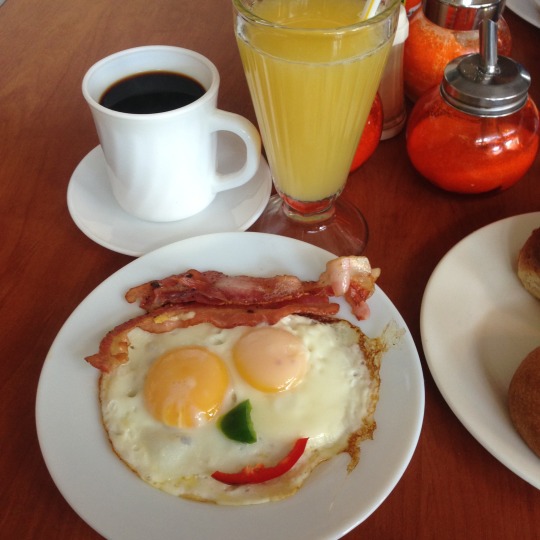
It was about a half hour drive up the mountains to our destination, Puntzan Canopy ($20/pp). When we arrived, our guide Jon simply strapped on our equipment for us and showed us the map of the 6 lines we would be going to that morning. There was no extensive safety training or waiver signing, which was a refreshing change from any kind of “adrenaline sport” that we have in the U.S. Once we hiked up to the first line, Jon explained where to put our hands on the line and how to slow down or speed up, then clipped one person in and we were off. I was super nervous for my first zipline but once I made it to the other side I realized it wasn’t so scary.. until our next line. The next line was a bit longer and a lot higher, and we were given the option to do this one in the regular “seated” position or upside down with legs crossed above our heads. Of course, I went with upside down. About halfway through, I started to slow down a little and for some reason thought I might fall and freaked out, repeatedly saying “holy shit holy shit holy shit” to myself - which I later realized would have been a terrible choice for last words. By the third line, I was feeling much more comfortable and got to experience the “superman” position which actually felt the most natural and gave me a sense of what it might feel like to be able to fly. The next few lines were much higher up and required a decent amount of hiking to get to, which was probably terrible idea for the morning after drinking heavily but also super rewarding. I wonder if I would have had the balls to do any of this had we not conquered Fuji last year. Pretty sure there are still remnants of my fear of heights lurking in my gut, though.
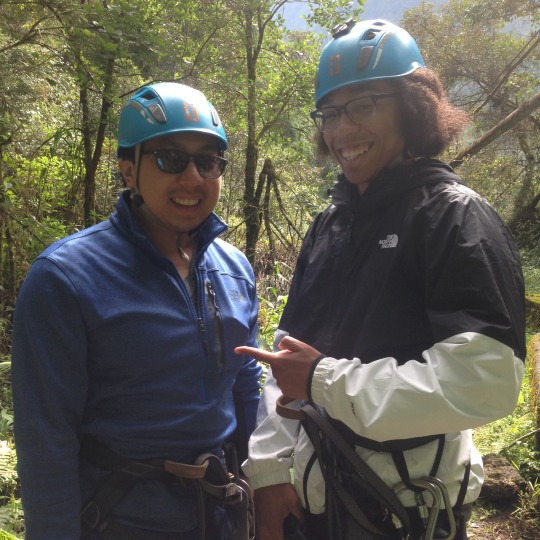
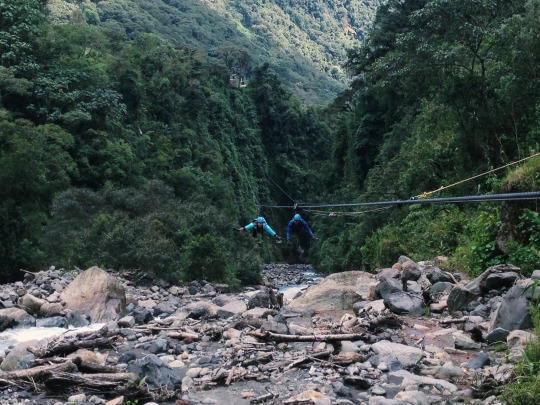
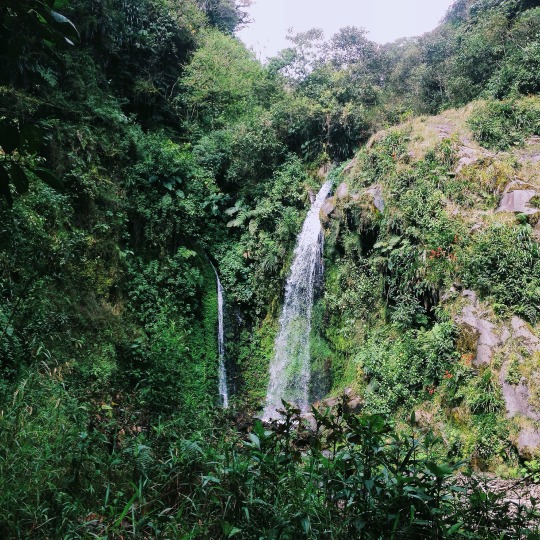
When we returned from ziplining (they call it canopying), we had just enough time to pack and check out of our hostel. Our next destination was Cuenca, (~$8 from the Baños bus terminal, 6 hours). Although I had looked into the bus terminal locations, cost, and time from city to city, I didn’t have the time for detailed schedules, so when we arrived at the terminal, we were surprised that there were no direct buses to Cuenca on Sundays. Instead, we could either take a bus to Riobamba or Ambato and then transfer. The problem was, when we arrived to Ambato, we had no idea how to get to the next bus. Since we were the last ones off the bus, I asked the driver where to go, and understood only the direction to walk towards. When we turned the corner and didn’t see any stations or bus stops, we decided to take a break for food. Right outside of the restaurant sat an elderly man, who although seemed like he might be homeless, made no gesture towards us for anything. But while we ate, I noticed one of the employees step outside with a bowl of food and a cup of juice, handing it over gingerly to the man. I thought about how rare this act of kindness would be in NYC and admired the respect the employee emulated. I figured this would be a good opportunity to ask him how to get to Cuenca too, and sure enough - not only did he type out in Google Translate that we needed to take a taxi to a bus terminal; he walked us outside, hailed a cab for us, and told the driver our destination before bidding us good luck.
When we got to the terminal, we were told it would be another 3 hours before the next bus to Cuenca. By the time we would arrive, it would be past midnight. Since I barely slept the night before, I didn’t mind the long bus ride ahead to catch up on some rest before checking in at La Cigale (~$13/pp per night for a 3-bed room) for real sleep. I was so tired when we arrived that when the concierge asked (in Spanish) if I spoke English, I answered (in Spanish) “only a little” and ended up carrying the rest of that conversation in Spanish. He was probably really confused at how slowly I was speaking but whatever, it was good practice.
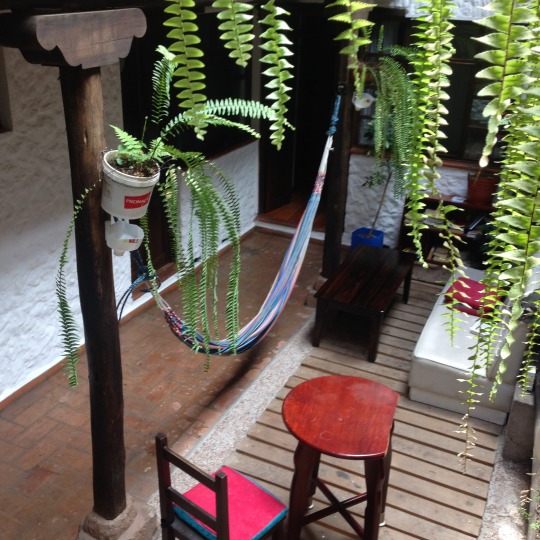
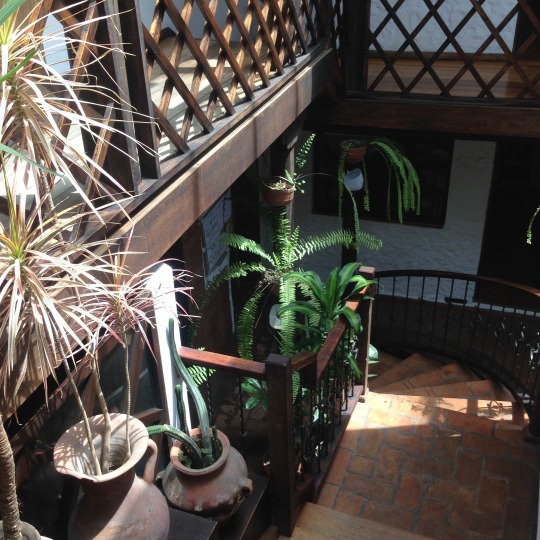
The city of Cuenca — in full, Santa Ana de los cuatro ríos de Cuenca — is the capital of the Azuay Province. It’s widely known as the most European city in the country of Ecuador due to its highly 16th and 17th century era Spanish colonial architecture resembling cities and architecture throughout Spain. Located in the highlands of Ecuador at about 2,500 metres (8,200 feet) above sea level, the centre of the city is listed as a UNESCO World Heritage Trust site due to its many historical buildings.
At least three cultures have left their imprint on Cuenca. When the Spanish arrived in the 1540s, they encountered the ruins of a great but short-lived Incan city called Tomebamba (“Valley of the Sun”). The Spanish eagerly dismantled what was left of it, incorporating the elegantly carved Inca stones into their own structures. Before the Inca, the indigenous Cañari people had lived in the area for perhaps 3,000 years. They, too, had a city here, called Quanpondelig (“Plain as Big as the Sky”).
(source: Wikipedia & Lonely Planet)
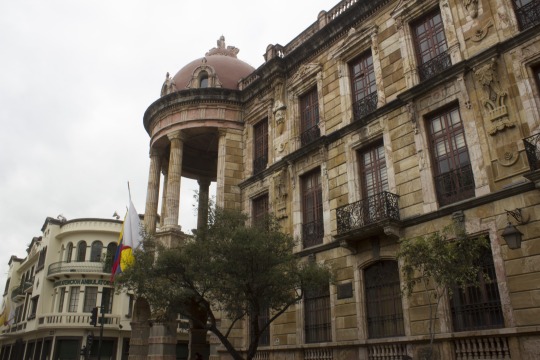
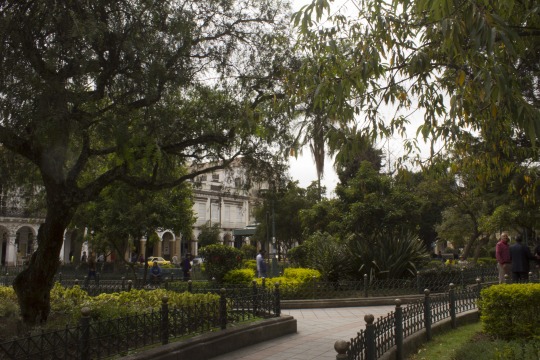
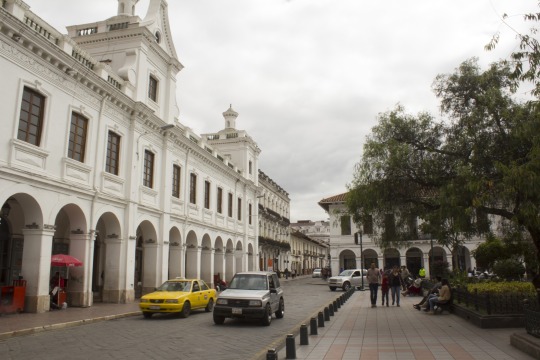
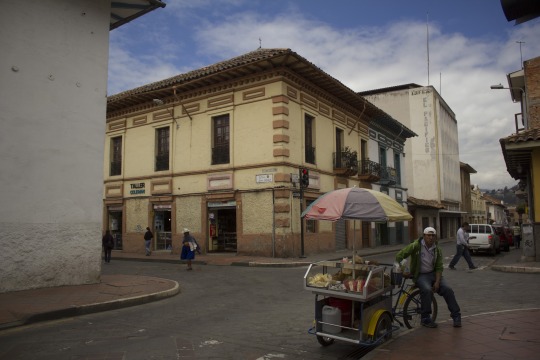

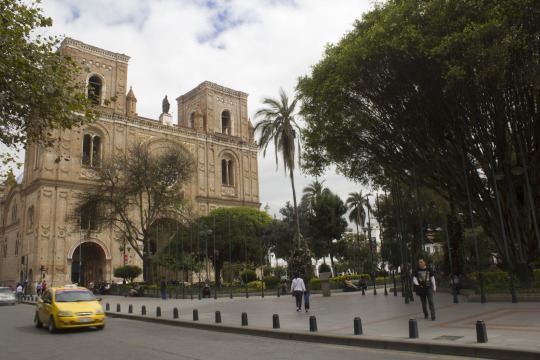
7/25, Monday: DAY 4: CUENCA // GUAYAQUIL
When we woke up, we figured we could squeeze in a few hours of exploring the beautiful colonial streets of Cuenca before having to take another bus to Guayaquil to catch our flight out to the Galápagos. We only had about 4 hours to walk around before having to check out of the hostel, so we gave ourselves two missions and decided we would just take photos of whatever we could along the way. Our first stop was food (duh), and we wandered into an inviting little place where one of the hostesses spoke English and welcomed us in. It was here that I ordered the first of many ceviches, none of which were disappointing despite their differences. The one here was ceviche de camarones, a little bowl filled with an abundance of sweet little shrimp in a savory, tangy vinegar with cubes of tomato, garnished simply with tiny slices of red onion and cilantro, accompanied by lime and a classic bowl of roasted corn kernels.
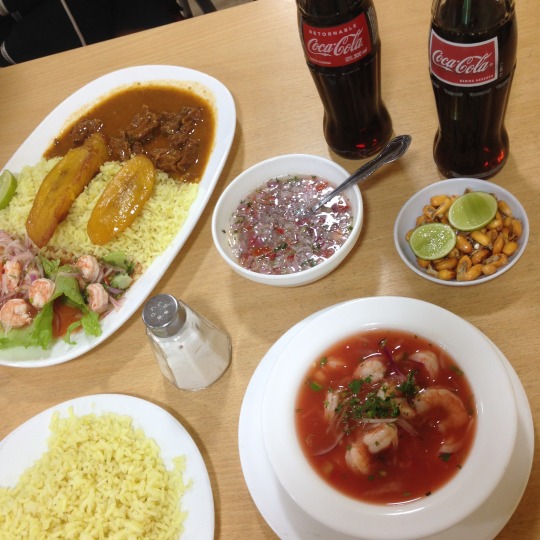
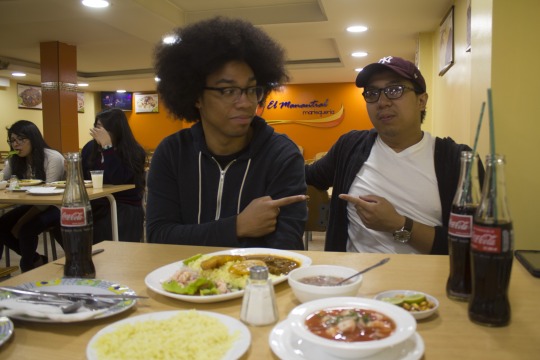
After we had lunch, we went on a mission to search for the best coffee in Cuenca. We didn’t do much research, but once we spotted Cacao y Canela, we knew we found something special. An adorable little café adorned halfway with cocoa beans and cinnamon (appropriate), halfway with kitschy Wisconsin license plates and random signage, we sat down as the only patrons and were quickly served by the attentive waitress. We each ordered a coffee, and Will tried the strawberry cheesecake. After our coffee fix, we walked back to the hostel to pack and check out before embarking on our next bus ride to Guayaquil (~$8 from the Cuenca Terminal Terrestre, about 4 hours).

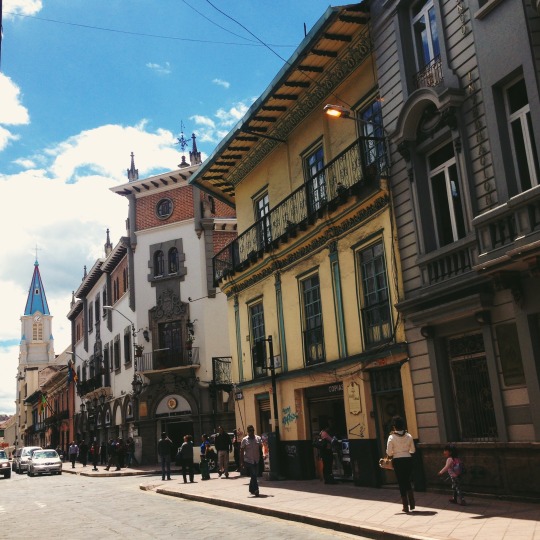


Once we got onto the bus at the Terminal Terreste de Cuenca, the ticket collector stood up to begin speaking to the bus. At first, we figured it would be the standard, 2-minute protocol of general safety precautions, maybe a spiel about how long the ride would be and when we would stop at a rest area. Nope. That speech turned out to be a solid 20 minutes (at least) about - from what I could understand - the dangers of Guayaquil and foodborne illnesses that could be contracted from certain food and drink there. I was baffled, but the 20-something guy sitting next to Will reassured him he didn’t need to pay attention to any of it. I suppose it made some sense, since Guayaquil is considerably more notorious for street crimes than colonial, picturesque Cuenca. But when we arrived, it didn’t feel too different from my experience living in Cebu - granted, the vibe was not like it was in Cuenca, but I felt at home amongst all the gated homes with glass-topped walls surrounding them, the bustle of people and busses in the busy streets, and the occasional stray dog roaming curiously about.
The difference between the weather in cool, breezy Cuenca to hot, humid Guayaquil was a welcome change for me since I prefer to sweat than shiver, but I guess so do mosquitos. Once we arrived in Guayaquil, it immediately felt more crowded and intense than the calm streets of Cuenca. We hailed a cab and shortly after realized that the driver couldn’t figure out how to get to our hostel, La Casa Tangara ($10/pp per night for a 3-bed room), when he stopped to ask local pedestrians for directions. It took a few stops and wrong turns for us to arrive to the metal gate door that our host slid open, which he locked once we stepped inside. This was probably our favorite hostel of the trip, because despite its metal gate doors and glass-topped concrete walls, the interior was decorated by beautiful botanical murals and equally as welcoming live plants lining the corridors and blooming around the outdoor dining patio. It was a small place, with only 3 bedrooms and a shared kitchen, living room, and laundry service, but the host was kind (and exceptionally friendly to Will), the WiFi was poppin, and the room was comfortable.
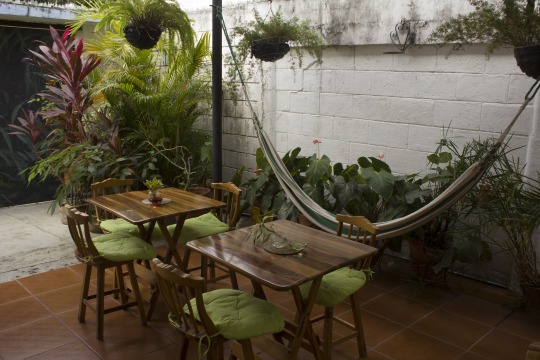
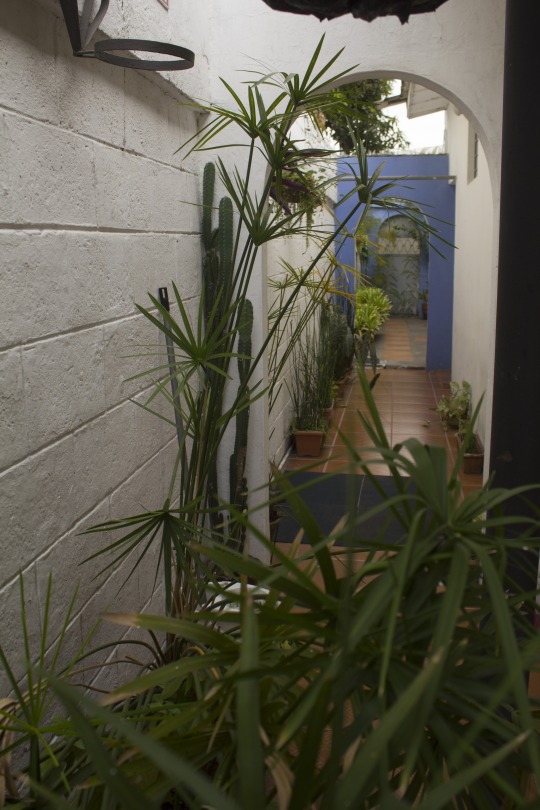

When we settled in, we asked the host if there was any place nearby for dinner, at which point he offered to call us a cab. We asked if we could walk there, but he cautioned that since the sun was setting soon, we should probably take the cab either to the mall, or a few local restaurants. Will asked him if it was safe to leave the hostel, and his response was, “Well, since today is a holiday, it should be safer” (it was Simon Bolivar’s birthday) - as if criminals need to be home with their families on national holidays, too.
We ended up taking a cab to the San Marino Shopping Mall, and made a full lap around to explore each floor and the food court before deciding to cross the street down the block to McDonald’s. Will and X have a tradition of trying the McDonald’s in foreign countries, and I guess I’m not completely opposed; I just refuse to have it more than once during a trip abroad. All I have to say is that the McDonald’s in Ecuador is on another level - as in, they have a separate dessert bar inside, and their fries taste at least 5x better.
Once we left McDonald’s, the most reasonable thing to do next was go to the nearest convenience store for snacks. Of course, being SnackGurl, I had to get a wide variety of snacks to try. I wasn’t very impressed - most of the chip snacks tasted kind of stale, and they were pale in comparison to the freshly fried bags of papas fritas you could get from the snack peddlers who boarded the busses with homemade local snacks (chips, peanuts, sliced fruit, etc).
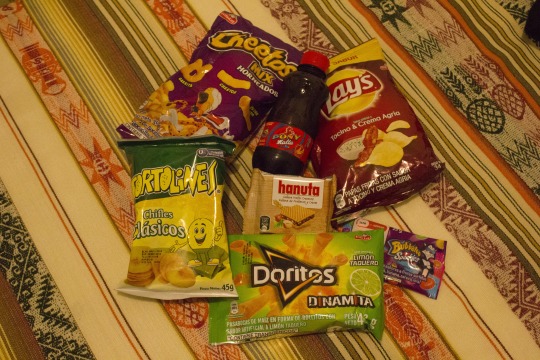
7/26, Tuesday: DAY 5: GUAYAQUIL // SAN CRISTÓBAL
The next morning, we awoke to breakfast made by our host - the most delicious scrambled eggs ever, buttered toast, watermelon, and coffee.
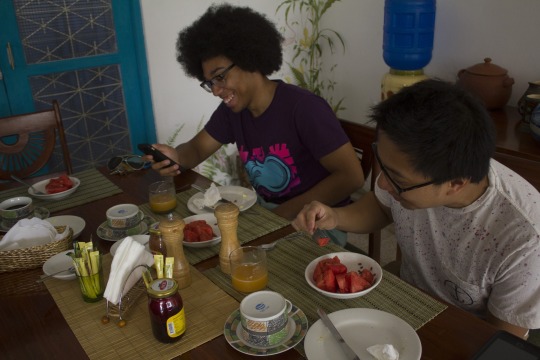
Once we packed, it was time to head to the José Joaquín de Olmedo International Airport to depart for the Galápagos. It’s important to note that the process for checking into a flight headed to the protected archipelago is much more extensive than most flights, despite that it is technically domestic. First of all, there are no direct flights to the Galápagos from outside of Ecuador. Flights depart from Guayaquil, Quito, and Cuenca to either of the two airports in the Galápagos - Seymour Airport (GPS) in Isla Baltra (also known as South Seymour), connected by ferry to Isla Santa Cruz, and San Cristóbal Airport (SCY) in Puerto Baquerizo Moreno on Isla San Cristóbal (also known as Chatham). There are only four flight times during the day, too - one in the early morning, and one in the early afternoon. I would highly suggest planning for at least 2 hours prior to departure time, since check-in requires applying for a tourist transit card ($20), then a preliminary baggage screening before you even step into the airport’s regular security and bag check.
Right before boarding the flight, to my pleasant surprise, I turned around and spotted Giselle, one of my brother Nathan’s best friends. Giss was with her cousin, Claudia, who lived in Cuenca. It was such an awesome moment of serendipity to realize we were on the same flight into Isla San Cristóbal together, and would be traveling to Isla Santa Cruz on the same date as well.

San Cristóbal (also known as Chatham) is the fifth largest and easternmost island in the Galápagos. It is the site of El Junco, the only permanent stream and source of fresh water in the islands, and is also where Darwin first went ashore in 1835. San Cristóbal is also the site of the oldest surviving settlement in the Galápagos, El Progresso, established in 1869. It has since been overshadowed by a second town, Puerto Baquerizo Moreno, located on the southeast coast.
(source: Cornell and Galapagos Conservancy)
When we arrived to San Cristóbal, it was actually a gloomy day with not much sunshine. Once the plane landed, we stepped off the stairs into the windy runway to walk towards the airport, where we were required to pay a $100 entrance fee (cash only!) to the Galápagos National Park. This money goes towards the conservation efforts made to protect the islands’ precious archipelago, where 95% of the land area is designated as protected by the Galápagos National Park Directorate (GNPD). In fact, tourists are permitted to explore specific visitor sites only with Park-certified naturalist guides. The GNPD coordinates group visits to these 60+ sites and carefully monitors ecological conditions.
(source: galapagos.org)
Once we exited the airport, a line of white pick-up trucks were ready to depart from the curb - these are the standard Galápagos taxis that can be found on any of the 5 inhabited islands (Santa Cruz, Baltra, San Cristóbal, Isabela, and Floreana). Of the 21 total islands, there are 18 main islands, 3 smaller islands, and 107 rocks and islets - for a total human population of roughly 25,000. Since most of the islands and islets of the archipelago are not inhabited by humans, they do not permit any overnight stays. In fact, the visiting sites, even on the inhabited islands, are only accessible from 6 am to 6 pm. Since we landed in the afternoon, we only had a little bit of time to visit one of the beaches that day.
(source: Wikipedia)
First, we settled into our hostel Casa de Laura (~$45/pp per night), where unfortunately they had mixed up our reservation. Rather than one room with three beds, we were separated into two rooms, but at least Will and X were directly above my room, despite that we ended up paying more than we expected to for our stay here. They also did not have laundry available here, the bathroom reeked of mildew, and breakfast was not offered, so overall it was not our favorite hostel.
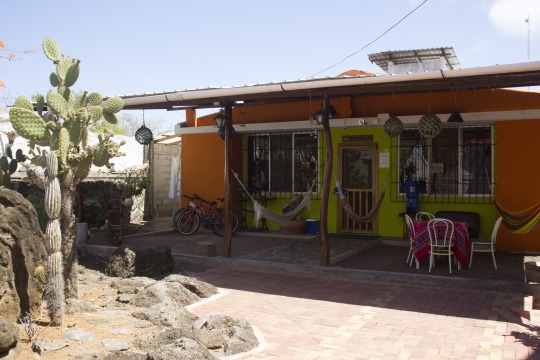
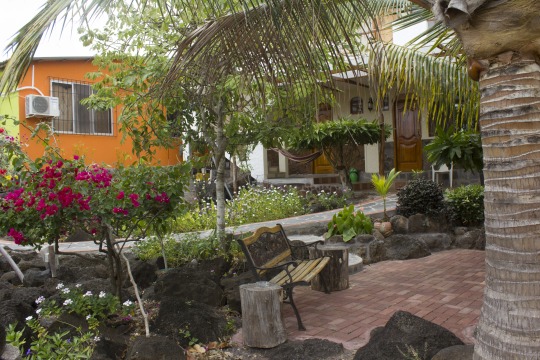
We decided to wander to Playa La Loberia, a beach I had read about that promised an abundance of lazy sea lions, and committed to the long walk down a wide dirt paved road that lead to a rocky beach. I was ecstatic when we finally approached the soft sand after more than a mile of gravel, and saw the first few sea lions lying by the water, basking in the cloudy daylight. Underneath the nearby shrubbery, a few other sea lions hid beneath the branches, resting on each other’s butts. I can’t remember how much time we spent on that beach admiring those beautiful lazy creatures, but by the time we left, the sun was just beginning to set and we were hungry. We headed to a little place decorated with lots of plantlife and trinkets, with flags from all over the world hung from the ceiling. Of course, I had ceviche again.
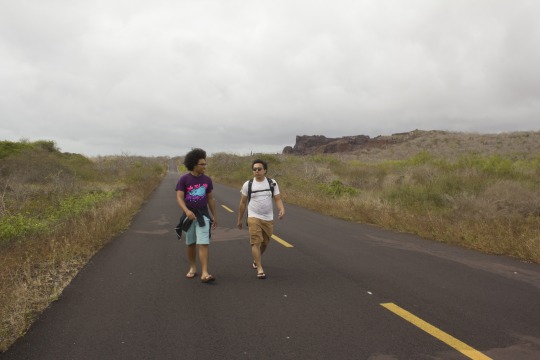
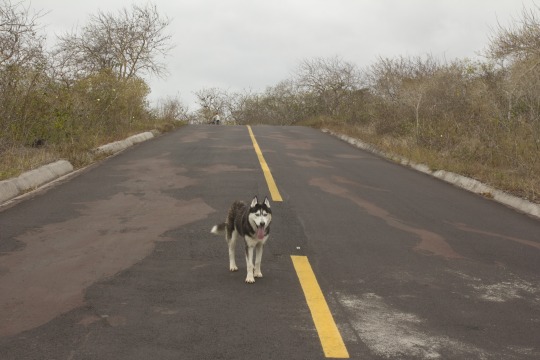
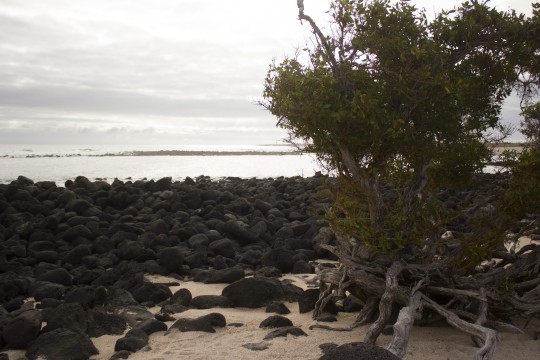
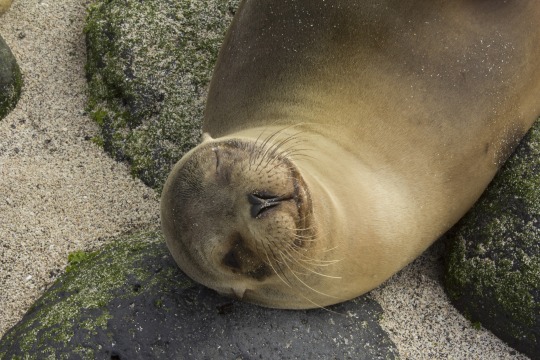
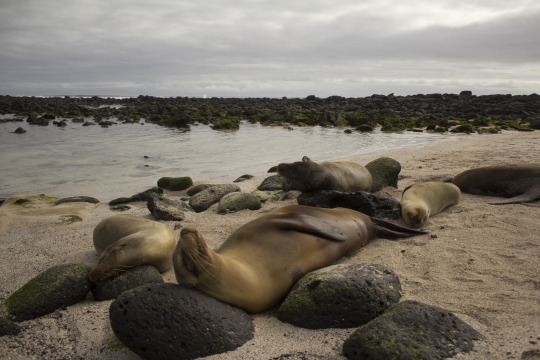
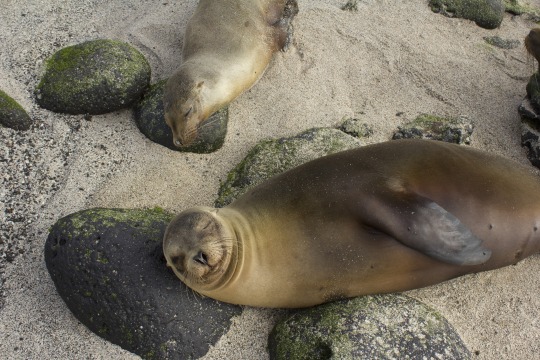
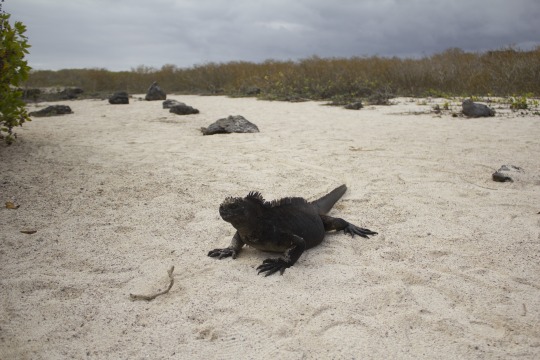
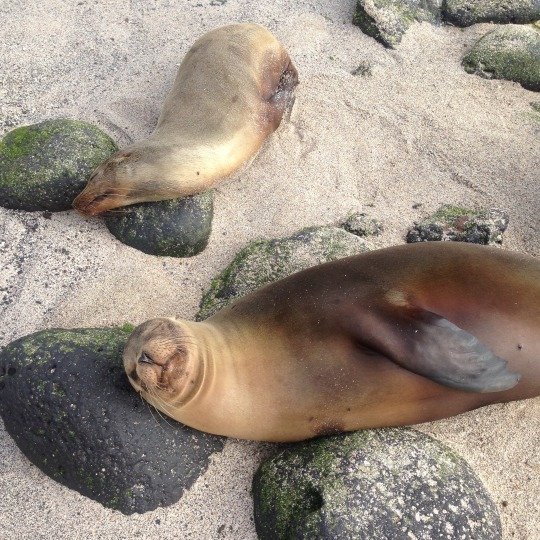
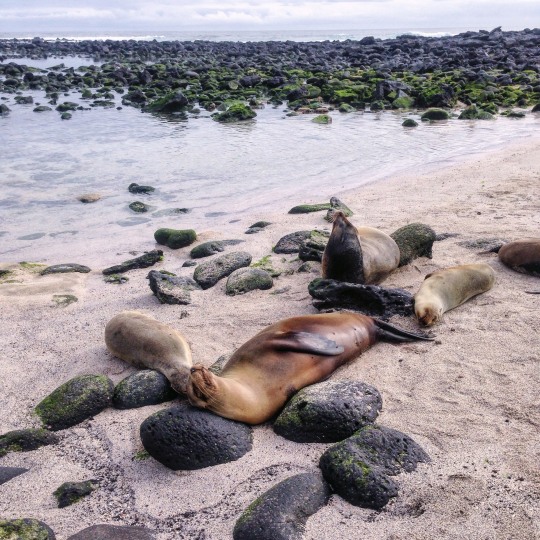

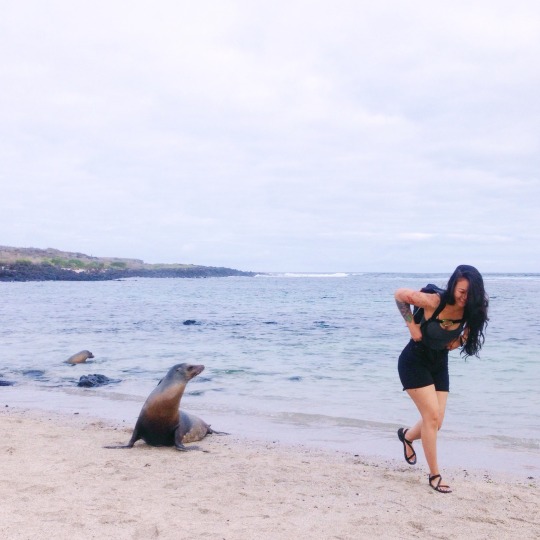
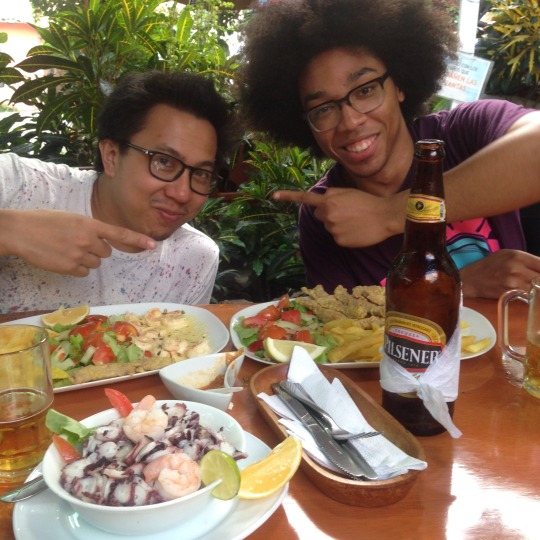
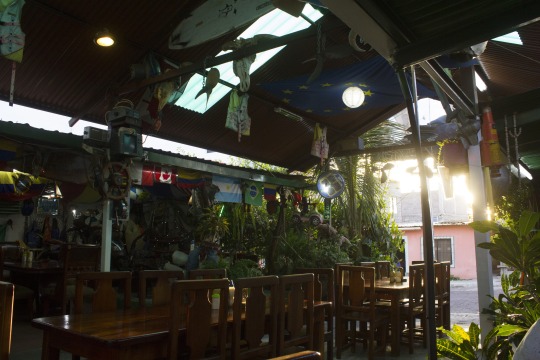

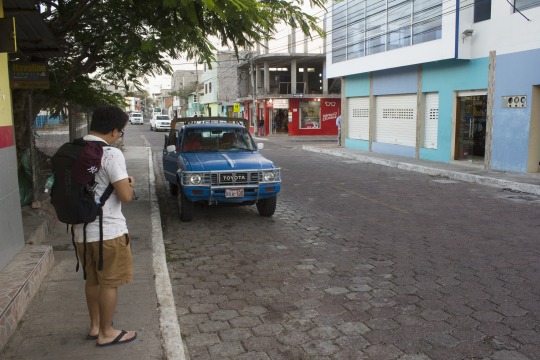
That night, we met with Giselle and Claudia for drinks and to book a tour with one of the local tour groups that they had spoken with earlier. This is where we met Javier, the absolute friendliest man I have ever met in my entire life. Words can’t do this man justice, so I highly recommend that you visit Pacifictour in San Cristobal to meet him. I guarantee that you will smile immediately upon seeing him, because he glows with a rare genuine joy. Our tour experience with Pacifictour was perfect from start to finish, and I’d like to at least credit Javier for getting us off on the right foot. Besides giving us a discount (we each paid around $120, as I recall - as opposed to the usual $180 for day tours), he was so patient with each of us as we tried on our snorkeling gear and wetsuits to prepare individual snorkel bags for the next morning.
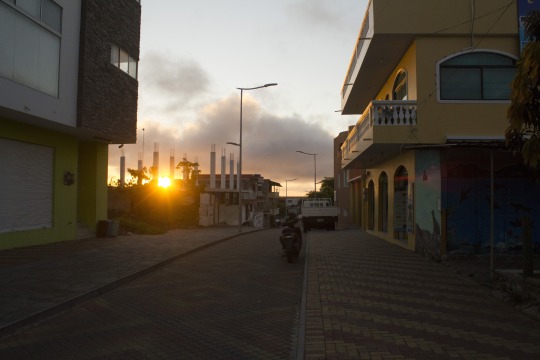

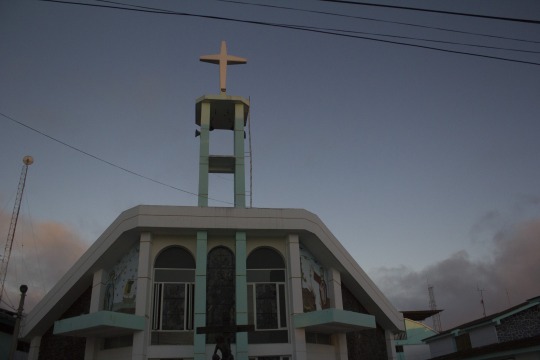
After we settled our tour arrangements, we headed over to El Barquero, one of the few bars in the small surf town of Puerto Baquerizo Moreno. When we first arrived, they looked like they might still be closed, but once we gingerly entered the gate, an older man stepped out of the house to greet us and lead us to the bar that was in the back. Before we could walk in, though, a younger surfer-looking dude asked us for our passports, but some of us were only carrying our driver’s licenses as ID. He made a fuss about this and almost refused to let us in, but Giselle insisted that his demands were ridiculous. By the time we entered the bar, hidden in a small corner beyond the pool table on gravel ground, the tension in the air was already stiff. So when I ordered two shots of whiskey to celebrate Giselle’s birthday and the man arrived from behind the bar with two low-ball glasses for $15 each (beers are usually around $1-3, cocktails don’t normally exceed $10), we weren’t ecstatic. We finished our game of pool quietly before heading out of there, since we had to wake up early the next morning anyway.
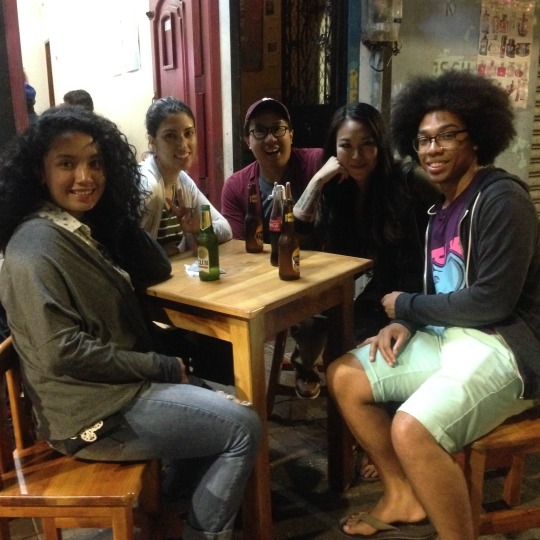
7/27, Wednesday: DAY 6: SAN CRISTÓBAL
By the crack of dawn the next day, we sleepily headed over to Casa Mabell where Giselle and Claudia were staying to meet up and walk over to Pacific Tours together. When we arrived, Javier was already ready to go, bright-eyed and bushy-tailed with all of our snorkeling gear in tow. I wish I could say that he spent the rest of the day with us, but after he walked us over to the pier, he bid us a good trip and headed back to the tourism office. We didn’t really know what to expect, but we were greeted by a very friendly crew of a captain, first-mate, and our tour guide, John Zúñiga. Our group of friends was joined by one more friend when we met Inês on the tour, who was traveling solo in the Galápagos before and after meeting with friends on the mainland. It felt like fate that we all found each other in these magical islands.

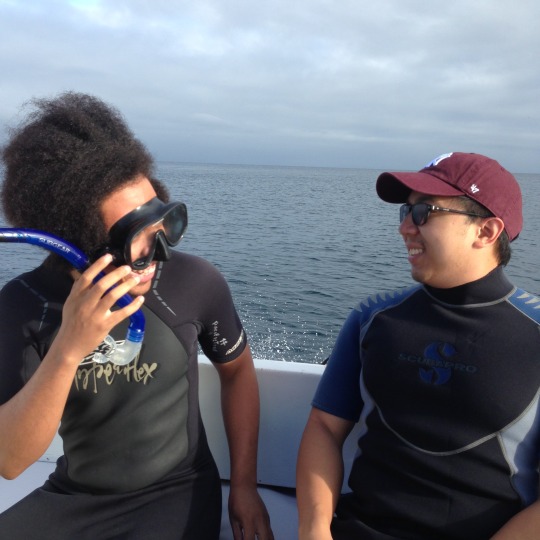

Our first stop on the tour was to León Dormido (“Kicker Rock”), two monolithic rock formations that jut out from the sea, towering over 500 feet out of the Pacific Ocean. When viewed from the south, it looks like a sleeping lion, hence its Spanish name; from the other side, it looks more like a boot, hence the English name. Split with a channel between that reaches 62 feet deep to the sea bed, this iconic landmark of the Galápagos was formed by natural sea erosion to the remains of a volcanic stone. The natural erosion of this ancient cone has created a channel between the rocks that provides the ideal habitat to view a variety of sharks and rays including Spotted Eagle Rays, White-tip Reef sharks, the elusive Galápagos Shark, and Hammerheads. This was a true test to Will’s first time swimming in the open ocean, let alone his biggest fear - sharks.
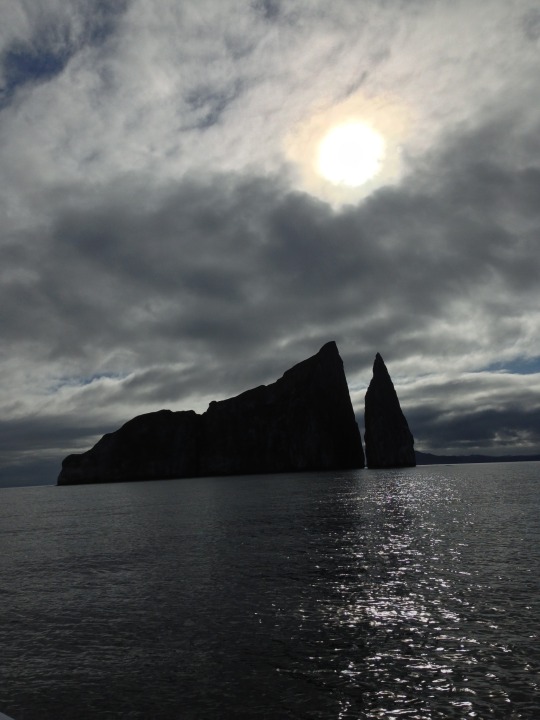

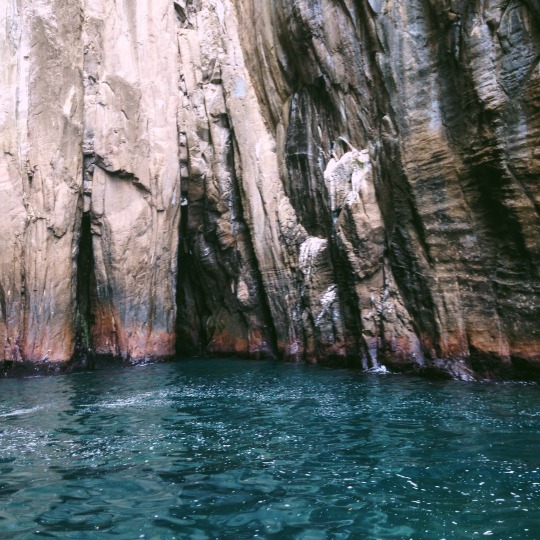
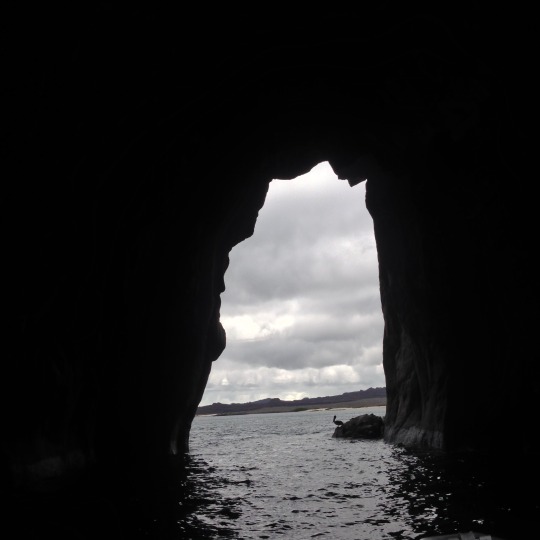
When we first dove in, the water was so cold we all screamed. First we swam from the boat towards the channel, where most of the shark spottings usually are. It was pretty dark in the channel, so visibility wasn’t the best, but once I spotted the shadow of a gigantic Galápagos shark lurking on the ocean floor, my heart began to pound. I’m pretty sure Will had a panic attack because he started choking on water and swam back to the boat to fix his mask. Although I was nervous at first, once I settled into the movement of the waves, I felt at home. The ocean is by far my favorite place to be, and every part of it is so magical to me - except for the jellyfish that kept stinging me. I couldn’t figure out what the sharp pricks were until later that day, when little trails of swollen skin appeared in all the areas I was zapped, itching uncontrollably. Thankfully these stings weren’t deadly and were sort of like intensified mosquito bites. They ended up leaving scars that lasted a few weeks.
After we exited the tunnel, we swam around Kicker Rock for a while, admiring different specifies of beautiful, vibrantly colored fish. But nothing was as majestic as the gigantic sea turtle, gliding past us playfully with his peaceful vibes, allowing the barnacle growth on his shell to just chill there as if a testament to his absolute chillness.
Our next stop was literally paradise - Bahía Sardina is a soft white sand beach located on the northwest coast of San Cristóbal Island. Made of coral and volcanic ash, the sand here is known for being as soft and white as powdered sugar. While we were here, John advised us to step carefully by the dunes and only walk in the areas that he led us through, so as to not disturb potential sea turtle eggs buried in the sand. Sea turtles lay their eggs on the same beach that they were born, sometimes searching from beach to beach until they find the right one.
While we walked along the crystal clear turquoise waters, a few baby egrets and great blue herons swooped about, pecking at the water for vulnerable fish. Above, a frigate bird circled around menacingly, its swift black tail swirling behind each of its graceful dips. The frigate bird is the largest avian species in the Galápagos, and known as the “pirate bird” because of its second-hand feeding habits. Since the frigate bird doesn’t have any oil glands to oil its feathers, it can only hunt outside of the water, pirating the food straight out of other birds’ mouths!
(source: our awesome guide, John Zúñiga - I learned so much!)
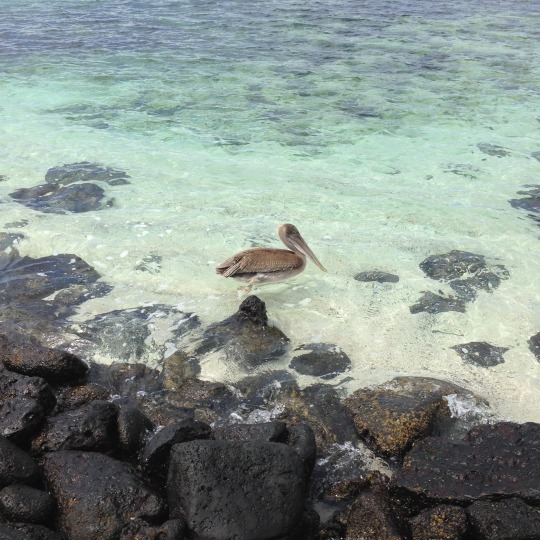
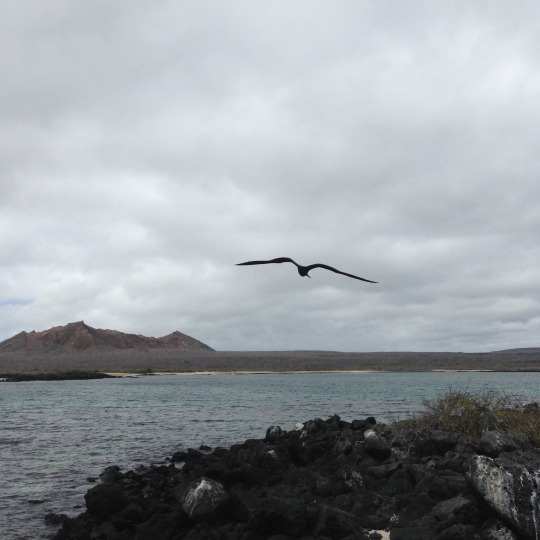

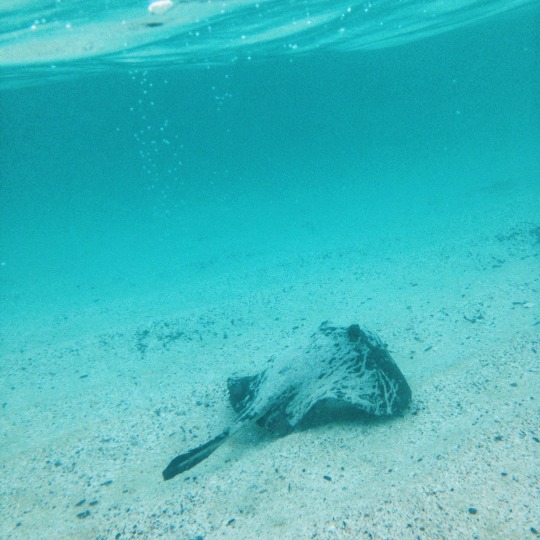
They say that your favorite animal is one that your personality emulates most, and I don’t disagree. I have a lot of favorite animals, but the sea lion is definitely in my top ten. I can’t believe how incredibly lucky I’ve been to be able to see some of my favorite animals in their natural habitats, gleefully living their lives the way the universe intended. I thought that I had reached my pinnacle of happiness last summer when I visited Fox Village in Japan, but seeing these glorious animals basking in the sunlight in their fully natural habitats filled my heart with unbelievable joy.
My brother had forewarned Giselle that she would have a hard time separating me from the sea lions, and I surely didn’t disappoint. As soon as this little guy swam up to me, I was enamored. Sunbathing alongside this spectacular sea lion has got to be one of my favorite memories, and I will always cherish this moment that made me feel so connected with the earth and all of its beautiful creatures.
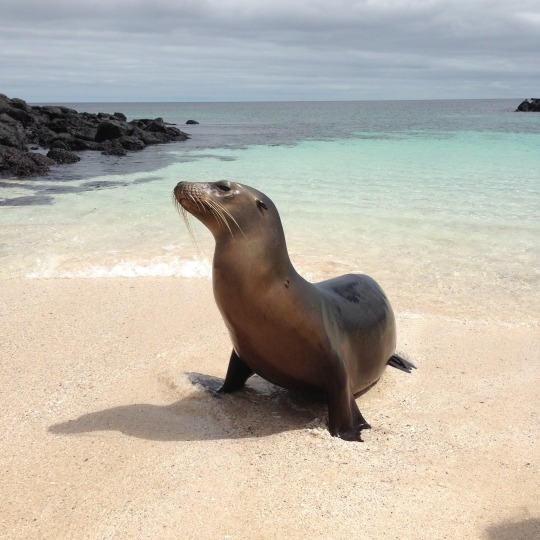
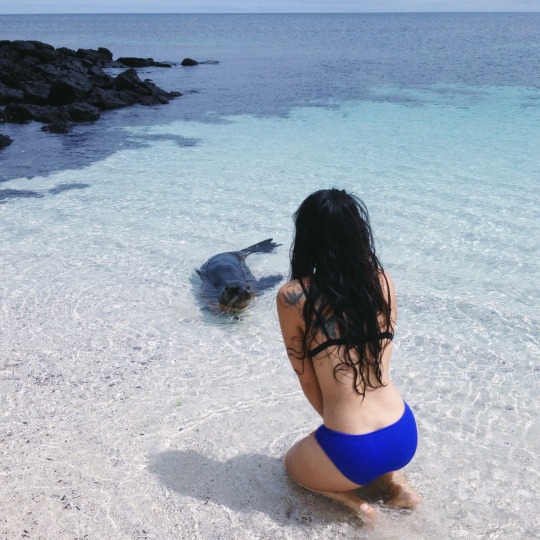
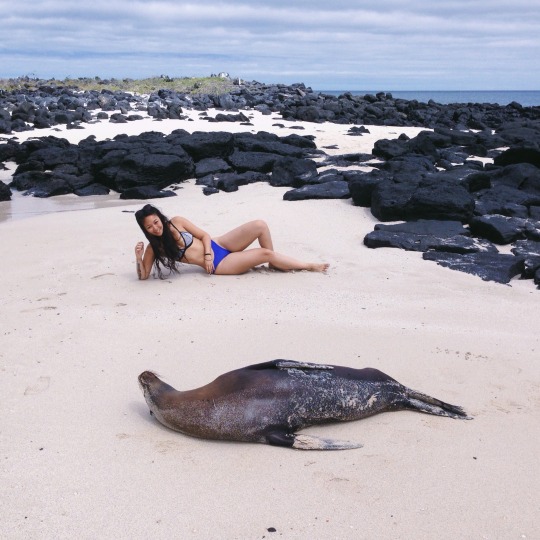
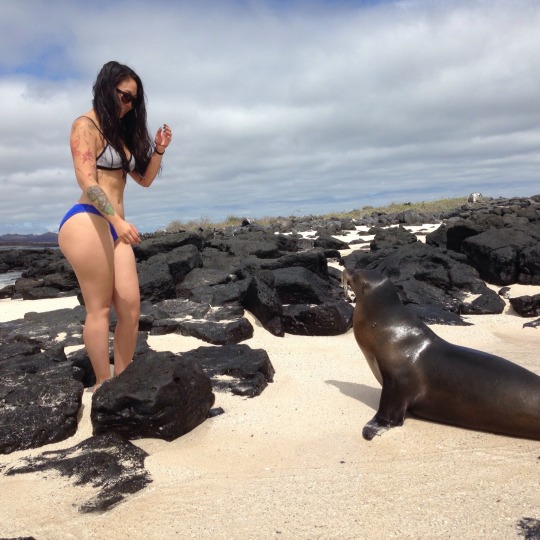
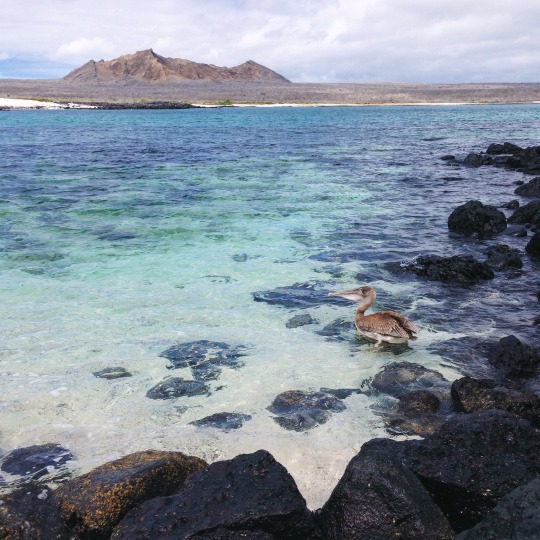
The next destination was equally as breathtaking, but in a slightly different way. We made a wet landing to the soft sands of Bahía Rosa Blanca, and headed towards shore to reapply sunscreen before embarking on a rocky hike through the trail of lava rocks to a small inlet, where dozens of white tip reef sharks were gliding, weaving seamlessly around each other in perfect synchronicity. We all admired their grace in awe when suddenly John asked, “so who is ready to swim?” Given that sharks usually swim to inlets to feed, where they can trap their prey in the corners of the inlet, we glanced nervously at each other as a few of us hesitated to gear up. Sensing our fear, John explained to us that generally, white tip reef sharks are friendly. They’re curious, and will swim up to humans very closely, but rarely attack unless provoked. They’re also kind of kinky. White tip reef shark’s mating is initiated when up to five males follow closely behind a female and bite at her fins and body, possibly cued by pheromones indicating the female’s readiness. Each male attempts to seize the female by engulfing one of her pectoral fins; at times two males might grasp a female on both sides simultaneously.
(source: John Zúñiga)
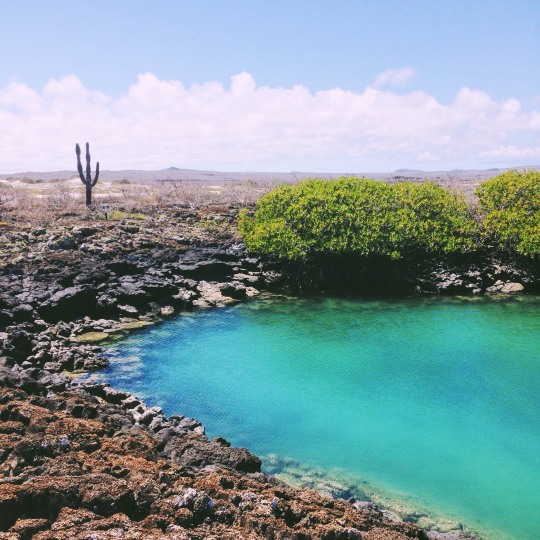
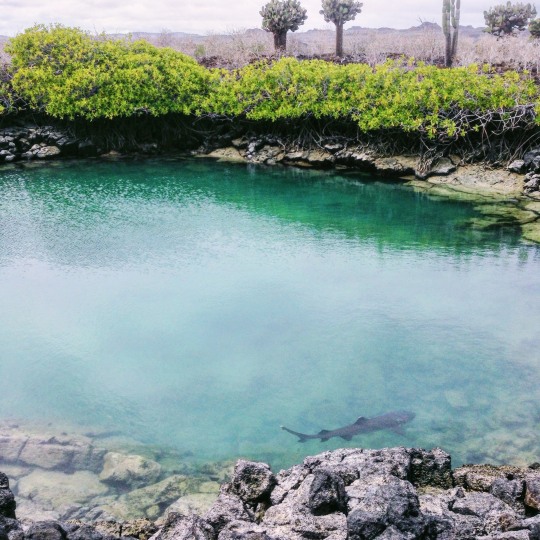
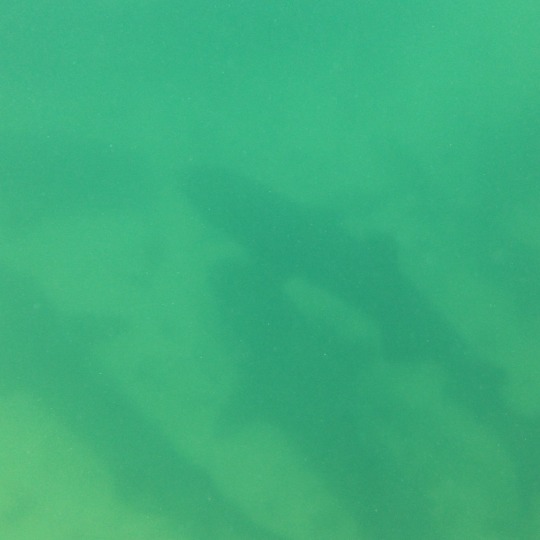
Claudia and Will were the first to dive in as I struggled to adjust my mask, and as soon as they entered the water, the sharks began to circle menacingly beneath them. I opted out of fins, as I feel more comfortable swimming without them, but neglected to notice the sharp edges of the rocks and barnacles leading into the inlet until I cut my foot. The cut was minor, so I decided to continue in and swam towards the sharks, who were now slightly less visible as they darted around a bit more urgently, kicking up dusty clouds of the sea floor sand. I nervously made my way towards John, Claudia, and Will, until my mask began to leak. I headed back towards the edge to grab hold of land while fixing my mask, but as soon as I reached for footing, a razor sharp rock sliced my foot, which immediately began gushing blood.
When I asked John if the sharks could smell my blood, he responded, “well yes, of course they can smell it - but I think they know you have human blood, not fish blood.” He seemed unsure, so I asked if he thought it would be safe to get back in the water with them. Again, he hesitated, “welllll, I think it will be okay, if you are brave enough.” You know me well enough to know that I took that as a challenge, so back in the water I went. Unfortunately for me, by the time I got back in, the rest of the group had gotten out for a break. Now I was alone in the inlet, bleeding, swimming above hungry sharks. My heart was pounding with fear and adrenaline at every movement below me. I decided it would be best to keep my bleeding foot out of the water, so I bent my knee and lifted it up - swimming with one leg only. Later, Ines showed me pictures she took as she laughed at me, swimming around with one foot out of the water like a shark fin. Now I was one of them.
After our shark adventure, John took us for a short tour around the bay as he pointed out the different species that he spotted. One of my favorites was the San Cristóbal lava lizard, endemic to the island and super frickin’ cute. The microlophus bivittatus species are small reptiles with long, tapering tails, slim bodies and rather pointed heads. Their toes are long and pointed, and unlike geckos, they are active during the day. Highly territorial, both males and females defend territories against intruders of the same sex. Both sexes challenge intruders initially by performing 'push-ups’ with their front legs, although this behavior is more vigorous in males. Often times, the males will use their tails in defense against each other or predators, which if bitten off, is not fatal but will not grow back. Female lava lizards prefer male mating partners with longer tails, so if you’re a male who is prone to lose in fights, don’t expect to get any.
(source: John & Quasarex)
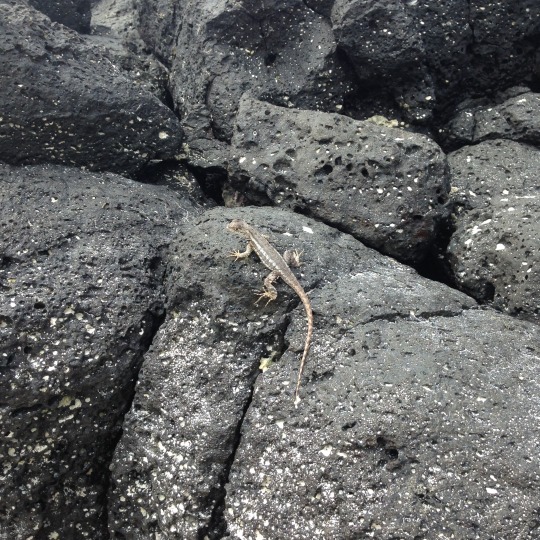
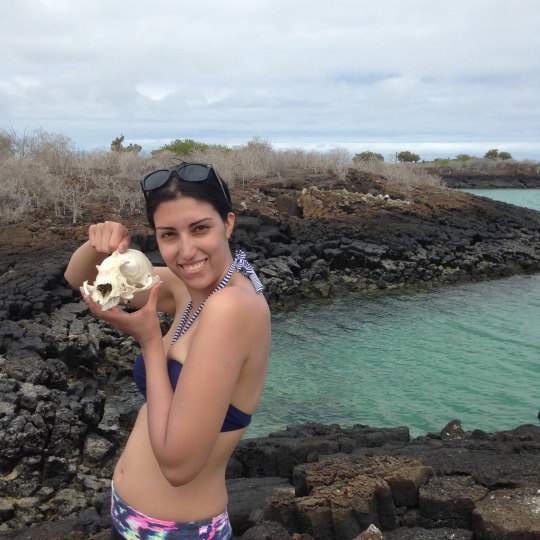
John also explained to us that the reason why the sand on the beaches of Bahía Rosa Blanca are so soft is because it is composed of fine particles of coral. In fact, the sand is so soft that you can slowly sink yourself into it by shifting and twisting without lifting your feet. Once you’ve embedded yourself ankle-deep, if you try to tug upwards without shaking your feet, you’ll find yourself stuck.

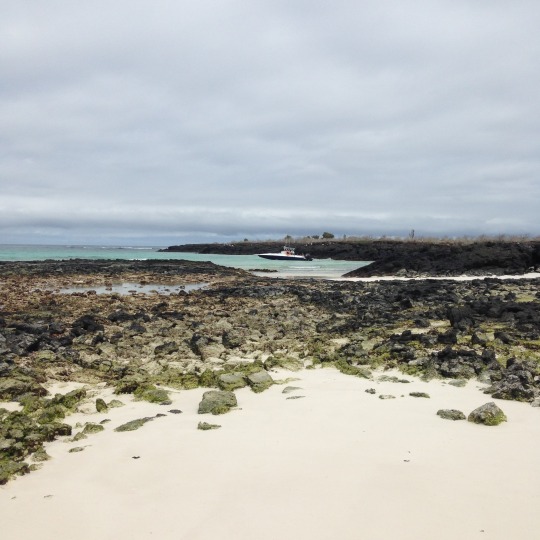
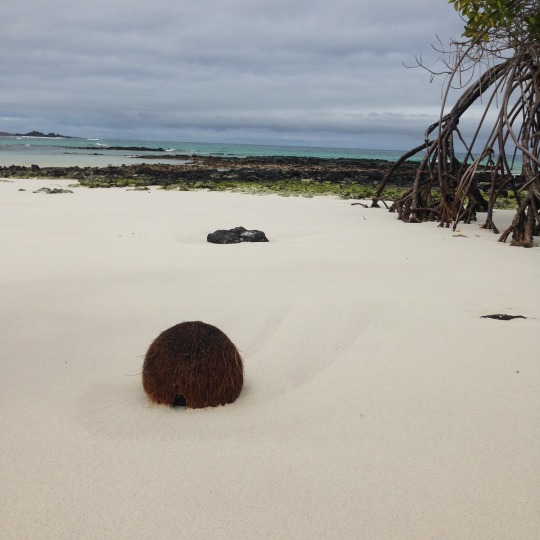
Alas, it was time to leave paradise and board the boat again, where we were served fried fish, rice, and salad for lunch. Like Inês said, it was the most beautiful place we’ve ever eaten lunch. As we started to head back to port, dark clouds began to form. The timing was perfect, because we weren’t scheduled to dock at another stop until we made it back to port, so we were just racing against the clouds to make it ashore. By the time the rain caught up to us, the waves were so rocky that the boat ride turned into a rollercoaster ride. I’m glad no one in our group is prone to seasickness - I love rough boat rides! Along the way, we spotted a humpback whale in the midst of swimming in the storm. The humpback whale, which can weigh up forty-five tons, is perhaps the easiest whale to identify and one of the most fun to watch. Their dark-blue or black bodies are covered in barnacles and they like to “spy hop” by raising their heads out of the water to look around.
(source: About Galapagos)
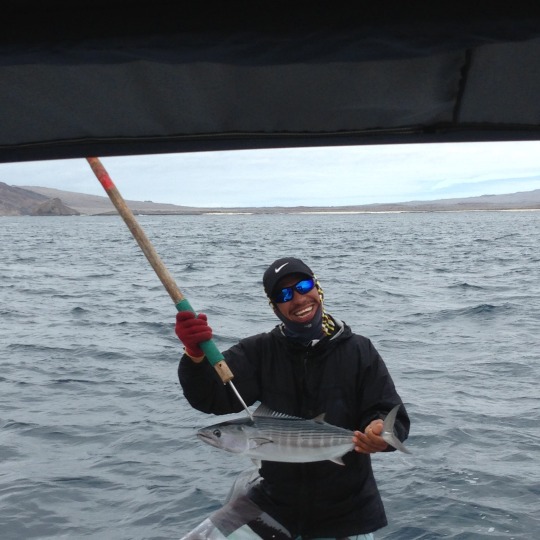

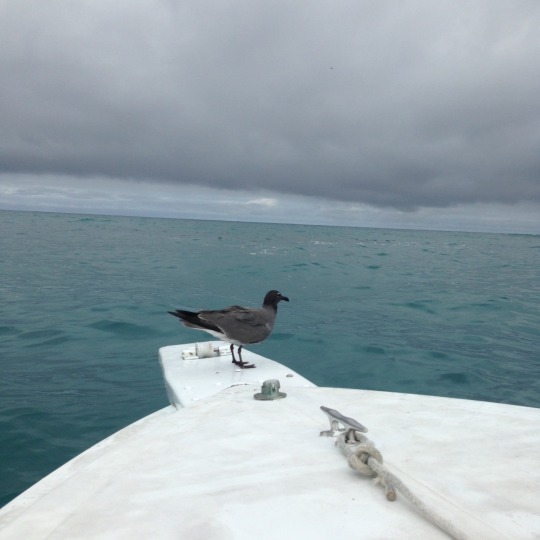
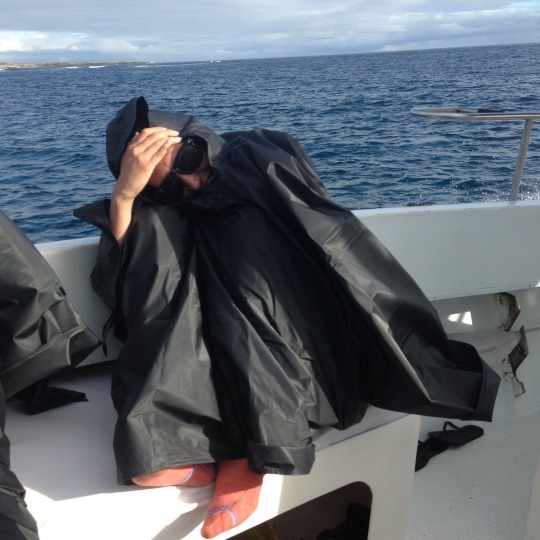
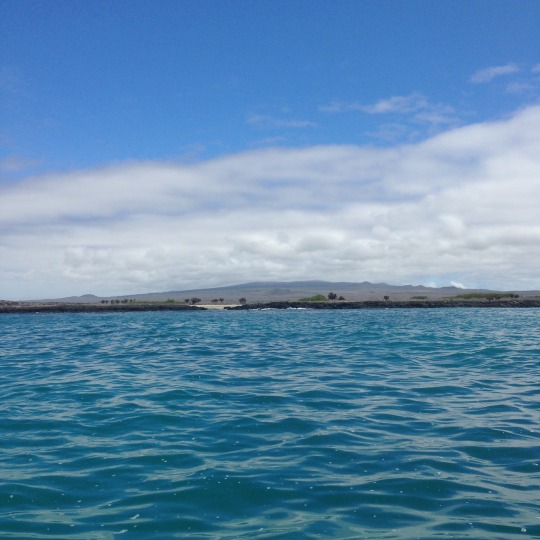

Once we made it back to port, we felt the wave of exhaustion settle in, so we decided to part ways to shower and rest before meeting together for dinner. Giselle and Claudia had to catch up on homework, so Will, X, and I set out to meet up with Ines. We took Giselle’s advice to “just follow the smells” when we were deciding where to eat, and so we followed the same smell I had been mesmerized by the night before. Let me tell you, that was one of the best decisions I’ve ever made, because the food tasted even better than it smelled. It was just a little local spot, called Picanteria “Sapita” with two tables inside, and a few tables outside along with a grill where the delicious smells were emanating from. The choices on the grill were chorizo, porkchop, or chicken - all equally as tempting, but the chorizo looked so pretty that I had to go with that. It was served with a side of colorful pasta salad and a full plate of white rice and beans, almost too much food for me to eat! I can’t remember the exact price, but it was definitely not more than a few dollars, and well worth every cent.
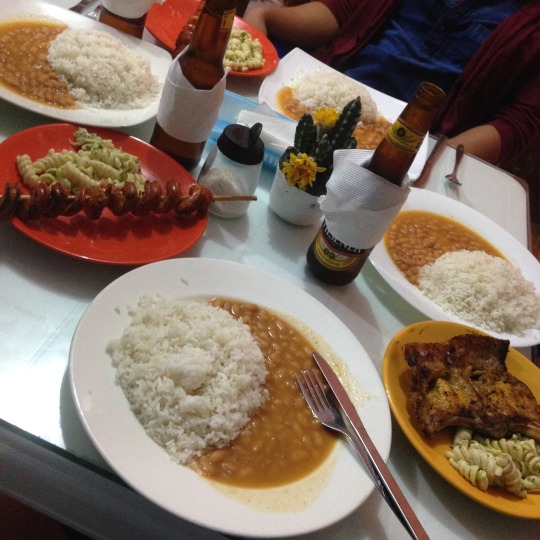
We decided to spend our last evening in San Cristóbal at Bar Iguana Rock, a local bar/lounge with a pool table and dance floor. They were so much more welcoming and friendly than the nasty encounter we had our first night at El Barquero. In fact, I still follow them on Instagram and it looks like they’ve expanded into a restaurant specializing in artful displays of sushi too! I can’t wait to go back to try some, because every photo looks delicious. Coincidentally, while we were there, the first mate from our boat tour showed up to play pool as well! We all knew he had a crush on Claudia so we kept teasing her as he begged her to dance salsa with him.
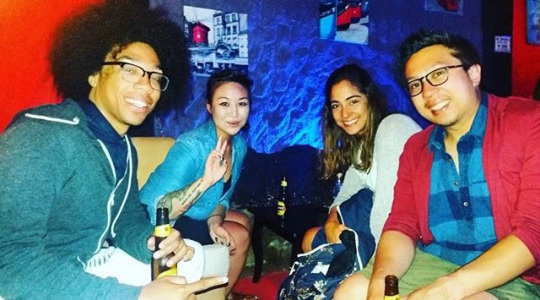
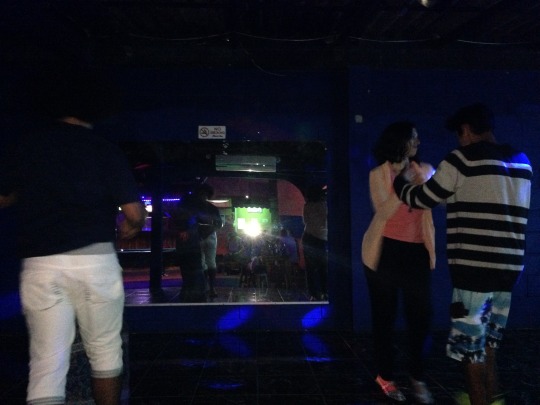
As the night wound down, the girls left to get some rest before our day of upcoming travel. Will, X, and I, on the other hand, were hungry again. We thought we were hopeless as we started to trek back to the hostel through the sleepy surf town that turned into a ghost town at night, when suddenly, I smelled something. Lo and behold, my nose led me to J&J Restaurante, where burgers and hot dogs were being taken fresh off the grill by Mr. JJ himself (I’m not sure if his name was JJ, we just kept calling him that). Bless you, Mr. JJ. Bless you for your contributions to mankind and late-night snackers.
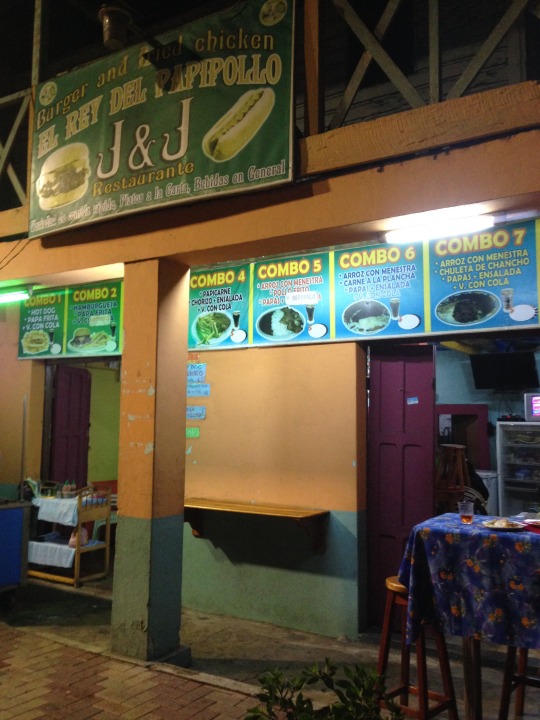
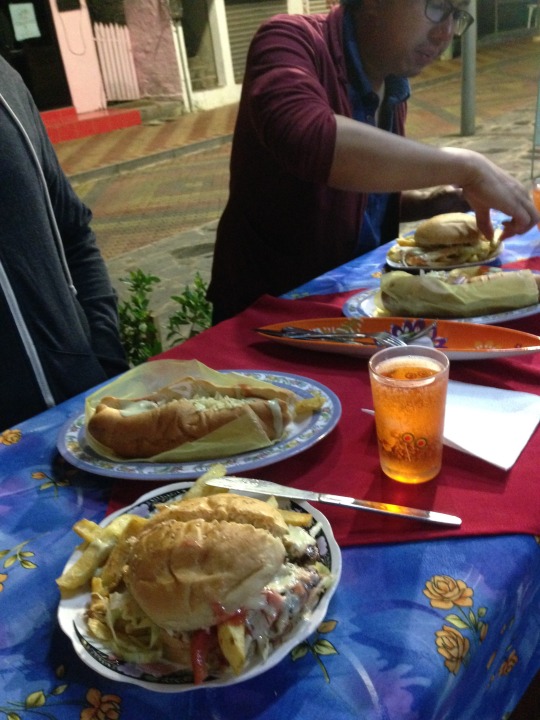
7/28, Thursday: DAY 7: SAN CRISTÓBAL // SANTA CRUZ
The next morning, we had a lazy start as we packed up and got ready to check out of Casa de Laura. For the first time since we arrived, we decided to turn left instead of right to get into the town. Turns out, there was a beach to the left of our hostel all along - literally teeming with sea lions. I was so disappointed in myself for not spending every night sleeping on this beach, when suddenly I was struck with the pungent smell of sea lion poop. Yes, sea lions poop too. Everyone poops. Either way, it was worth it just to see more of these majestic creatures up close in their home.

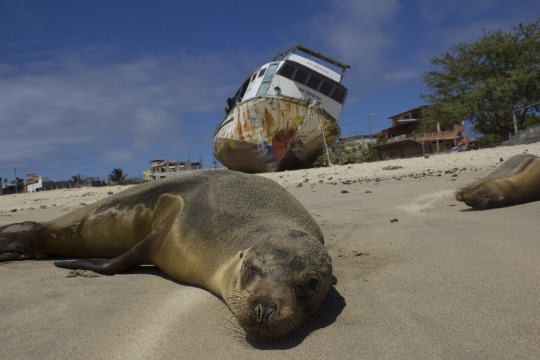
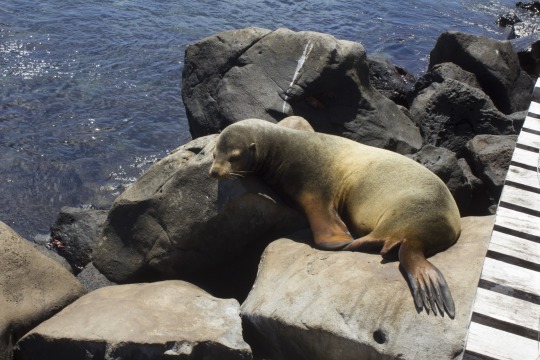

Before heading to the pier for departure, we stopped for a quick snack at Patagonia, where I had my first and definitely not my last bolon experience. Let me tell you a little something about bolon. Bolon is an Ecuadorian dish that is made of fried green plantains that are mashed up and mixed with different ingredients - usually with crumbled white cheese - and then formed into a ball and fried again until it is crispy on the outside and soft and crumbly on the inside. Bolon is a slang term that means large ball, so you could translate the name of this dish as green plantain balls, but I just call them heavenly.
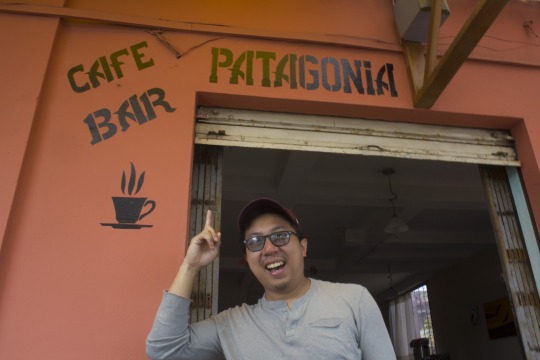
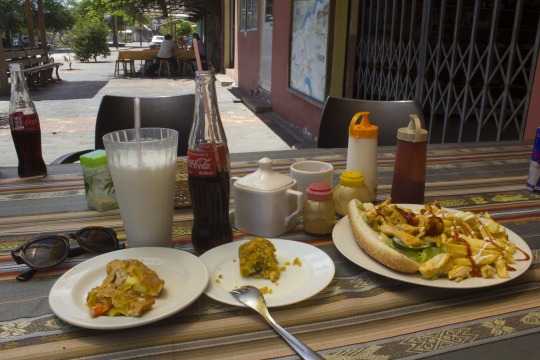
On the way to the pier, I decided to pick up some aloe vera for my unexpected (and painful) sunburn that I must have gotten during our boat tour the day before. Since resources on the islands are limited and there are strict restrictions on incoming cargo to limit the amount of pollution, most tourist items like this, sunblock, and other bath necessities are priced double or triple their original cost. It might seem like a rip-off, but if the price tag was the same as it was in your home country’s grocery store, then tourists would likely start to take advantage of the availability and create more waste and need for cargo traffic in and around the islands. So while $28 was not a pleasant price to pay, I respect the cause and took this as a lesson not to forget to apply sunscreen before falling asleep in the open sun on a boat.
So, I know a lot of people have complaints about how tedious airport security check-in can be, but if you ever plan to travel between islands in the Galápagos, be prepared to have your belongings thoroughly inspected and then tag-locked before you board the inter-island boats. Generally, no food is allowed (bottled water is okay), no plants or flowers, no rocks/shells/coral, and shoes with dirt or mud must be cleaned. This is all in an effort to protect the fragile archipelago and the unique species of each island that could be threatened by outside contaminants or harmful species.
The boat ride from San Cristóbal to Santa Cruz was about 3 hours, and we each paid $30 for our tickets. Despite being slightly over-crowded, the boat was pretty comfortable. I don’t get motion sickness, so I can’t speak on this, but Will did not enjoy the ride whatsoever. The rest of us slept pretty much the entire way, though it seemed like Giss had the best nap of all. When she woke up, she shared her theory that being on a boat is a lot like being inside of a womb - just floating and swaying to the motion of the waves like a little fetus - hence why it feels so comforting!
By the time we woke from our naps, our necks were sore and we were docking into the town of Puerto Ayora, the capital of Santa Cruz located on the southern coast of the island in Academy Bay. Although the island of Santa Cruz (also known as Indefatigable) is the second largest in the Galápagos, it is the most populated, including the town of Puerto Ayora as well as the agricultural villages of Bellavista and Santa Rosa. The island itself is actually a large dormant volcano, which last erupted about a million and a half years ago, leaving behind the remnants of its activity in beautiful visitor sites like Los Gemelos, two large pit craters along the road from Puerto Ayora to Baltra that were caused by the collapse of empty magma chambers.
Santa Cruz is also situated next to Isla Baltra, a small island (also known as South Seymour) where the Seymour Airport is located. The longest paved road in the Galápagos runs north-south across the island of Santa Cruz, which leads from the airport ferry at Itabaca Canal on the north coast through the highlands on its way down to Puerto Ayora.
(source: Wikitravel & Galapagos Conservancy)
Have you ever taken a nap that made you feel more exhausted after you woke up? That’s exactly what happened to all of us, because once we docked, we groggily made our way through the bustling port to the line of white pick-up trucks waiting for the throngs of incoming tourists and decided to part ways to rest before meeting again for dinner.
When we arrived to our hostel, Galapagos Native (~$38/pp per night, for a 3-bed room), we were greeted at the receptionist desk by Joffre, who I had been emailing to coordinate our stay before our trip. Joffre is super friendly and helpful, and is a native resident of the Galapagos (could you have guessed by the name of his hostel?), so he has lots of local knowledge and runs his hostel with amazing conservation practices. The only downside to our room was that the window faced the street, and since the top panels only had a screen and no glass closure, the sound came right through. Other than that, it was clean, roomy, and had plenty of outlets for us to charge all of our phones and cameras. At first, we thought the WiFi was shady but after spending more time on the island, we realized that it was the island itself and not the hostel in particular that received spotty service. After all, we were in the middle of the Pacific Ocean.
That night, we all met for dinner at The Rock, where they were having a cocktail special (2 for $10, I think?). Either way, their drinks and food were delicious. After dinner, we headed over to one of the local bars along the main street of Avenue Darwin, which was surprisingly crowded. This was my first time at Bongo Bar, so I had no idea what to expect when we first walked up the stairs that lead to the rooftop bar, which has beautiful and intimate outdoor seating area, indoor pool table (free!), and both an indoor and outdoor bar. We sat down at a table closest to the bar and immediately were served a tray full of free shots. Of course, this was before I found out that every Thursday at Bongo is ladies’ night, so I just felt all extra special when I took my very first shot of Coco Loco.
After a few drinks at Bongo, we all decided to go downstairs to La Panga, the dance club below Bongo. Now, I have no idea how to dance salsa but Clau and Giss are pros so we all just joined in for fun. As the night got later, it was time to wind down and say goodbye to Inês, who was leaving the next day. It was so sad to see her go, because it felt like we had found such a beautiful travel tribe that lasted only for a perfect few days.
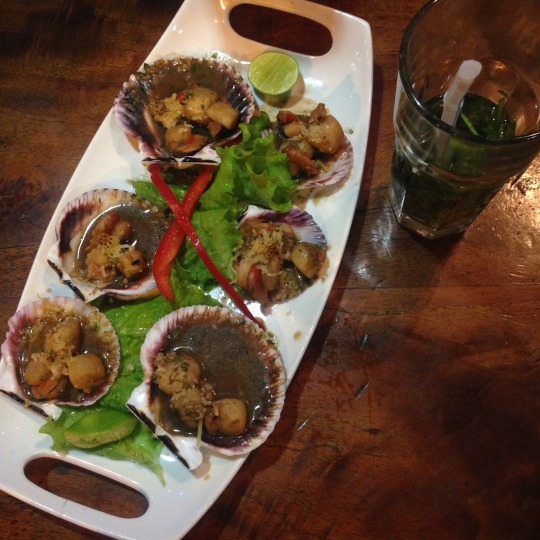
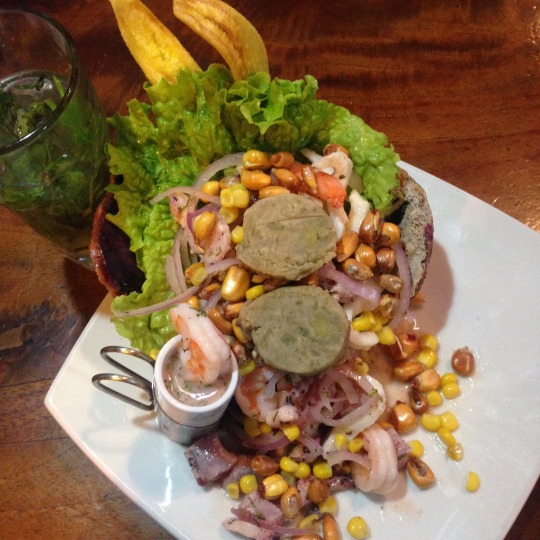
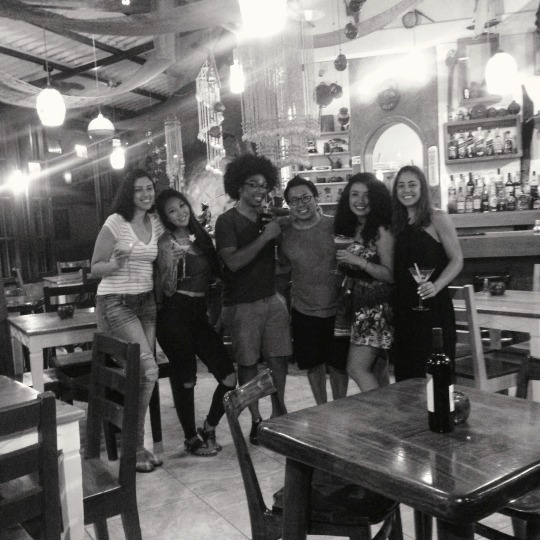
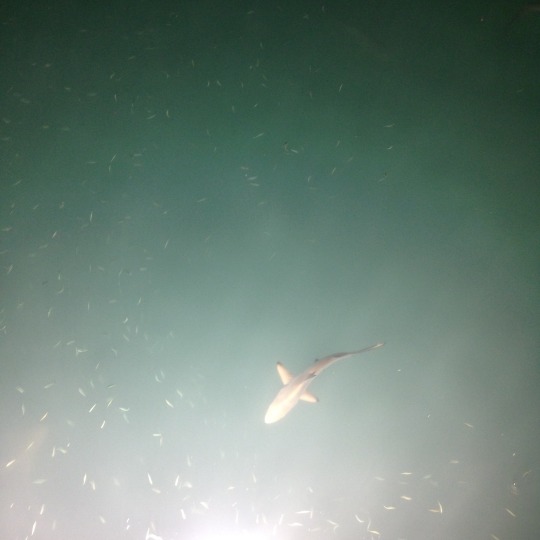

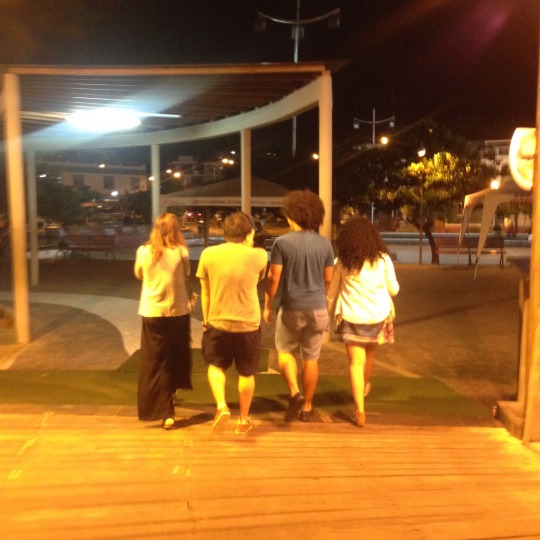
7/29, Friday: DAY 8: SANTA CRUZ
The next morning, Will and I woke up particularly hungry, so decided to walk down the block. Before we could even make it to the corner, the little bodega a few doors down stopped us in our tracks with its enticing scent of freshly baked empanadas. A small group of tourists were clamoring at the cart to place their orders, and we decided to join in. Before we could even sit down at one of the two plastic tables inside, one of the tourists suggested, “try the salsa.. it’s crack.” It was, indeed, crack. We immediately ordered two more empanadas before walking back to the hostel. From that day on, we woke up every morning and headed straight to the Abra K’Dabra empanada cart at MiniMart Merka 7 before starting the day.
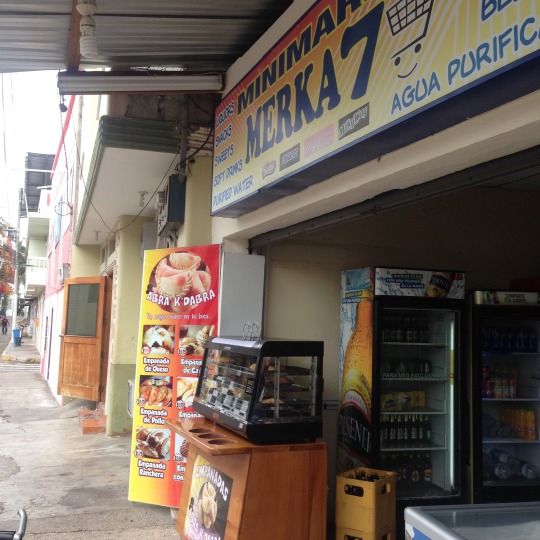
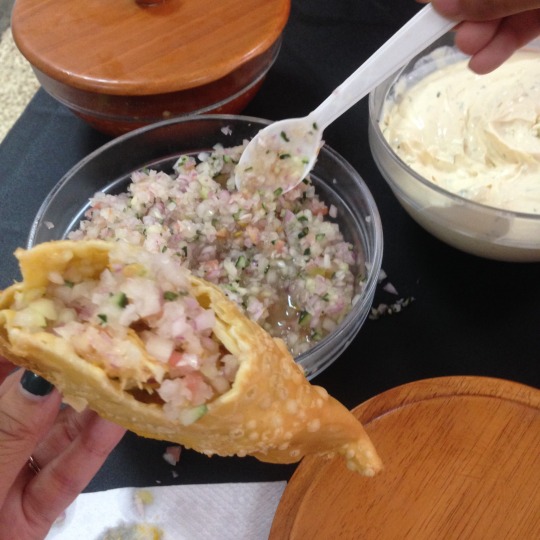
Later that morning, we met up with Clau and Giss at the benches across from The Rock to head out for a day of exploring. Our first stop was to Las Grietas (“The Cracks”), a series of volcanic crevices that were formed during the cooling of molten lava. The porous lava stone of the island allows fresh water to filter down from the highlands into Las Grietas where it mixes with sea water filtering in through the mangroves from the ocean, resulting in a crystalline and refreshing natural swimming pool. To get to this magical sanctuary, we took a panga (water taxi) for about $1 from Puerto Ayora to the otro lado (the “other side”) of the main pier. Once we docked, we followed the signs for the Finch Bay hotel, where the path connects to a short boardwalk along a small beach called Playa de las Alemanes, which leads to another pathway to the beautiful pink salt flats that welcomes visitors onto a cacti-lined trail towards the reward of Las Grietas’ cool waters.
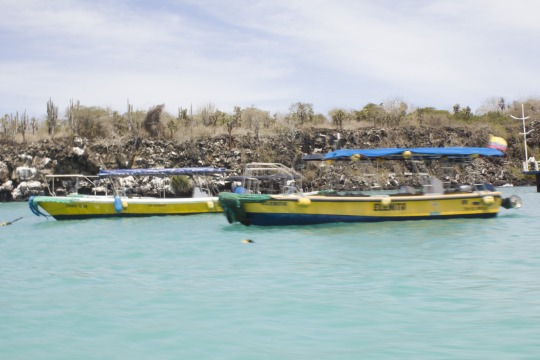
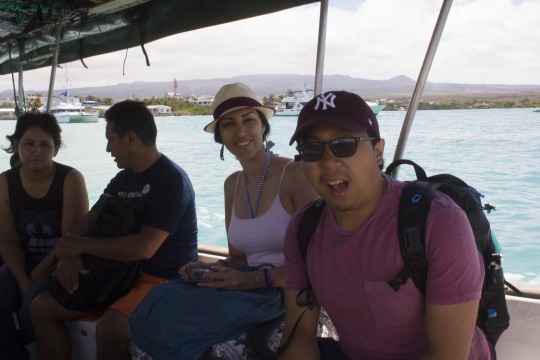

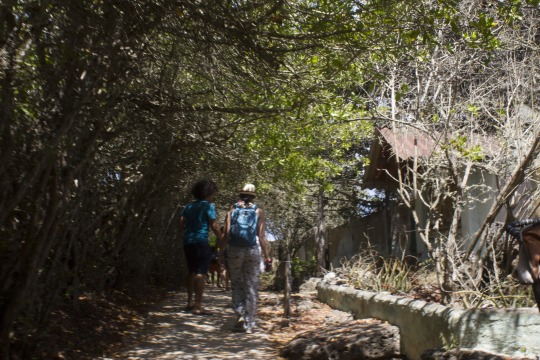
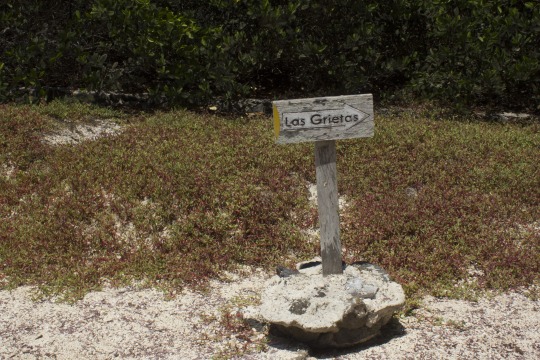
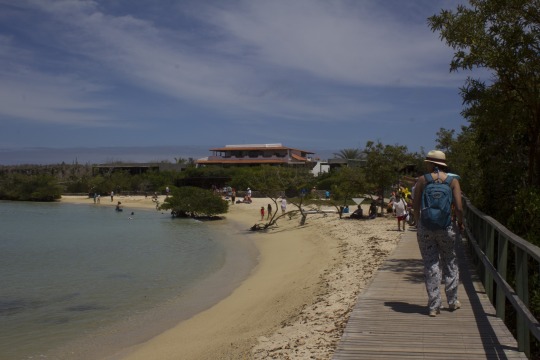
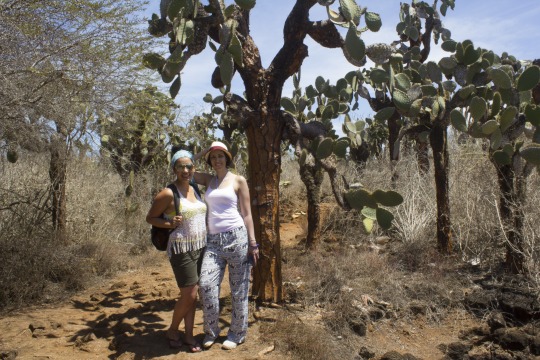
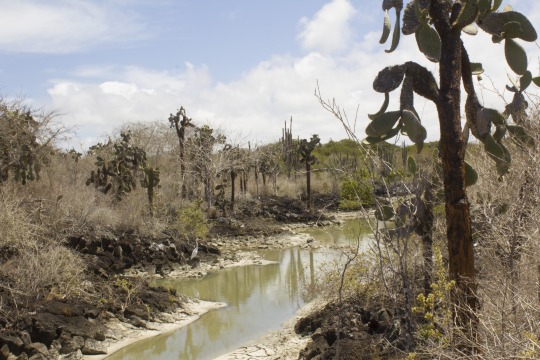
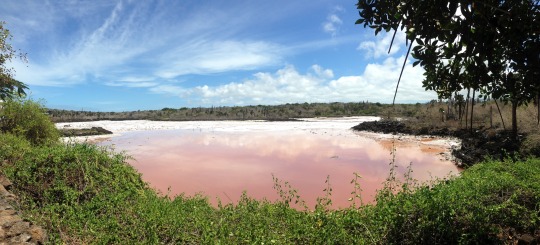
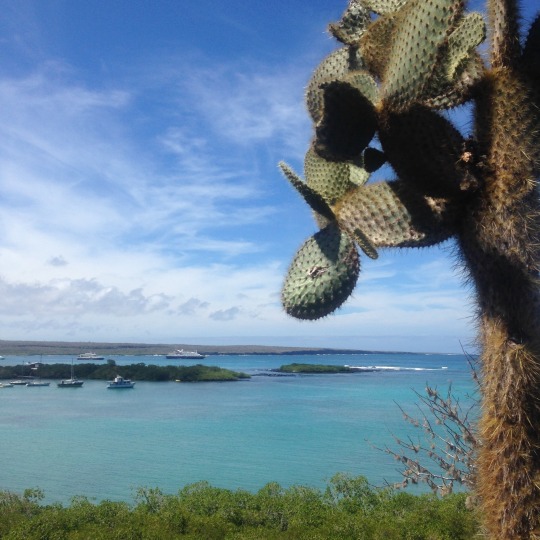
When we arrived, the staircases were already bustling with tourists and locals alike, the wooden coat racks spilling over with clothes onto the hot lava stones surrounding the platform that divers were bravely launching themselves off of into chilly cerulean water. I hesitated to jump in, but the hike leading up had warmed me enough that the cold waters were a welcome refresher, so as soon as the rush of water embraced me, I felt at home again, floating with a perfect view of the sky framed by the towering walls of the crevice.
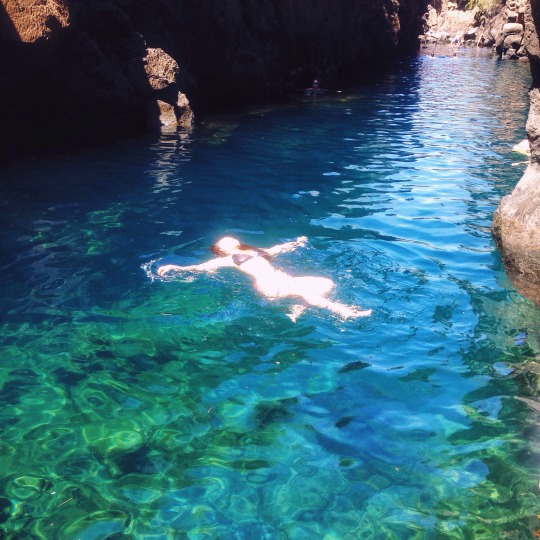
By the time we hiked back down through the cacti trails, past the vast pink salted waters, and back to the panga pier, we were all exhausted and hungry, so once we docked at the port we headed down Avenida Darwin for food. After a short stroll through some of the smaller streets off the main avenue, we came across the Galapagos Deli, where we stopped for freshly made personal pizzas and ice cream. Since there were some flavors I never tried before, I decided to with the guanabana, and mixed it with some fruta (strawberry) for a delicious combination.
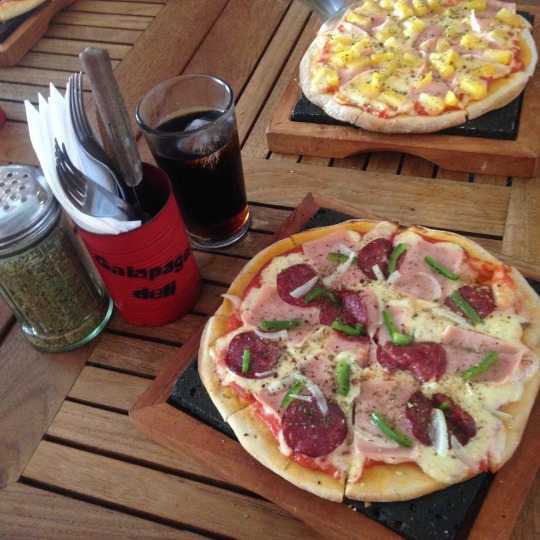

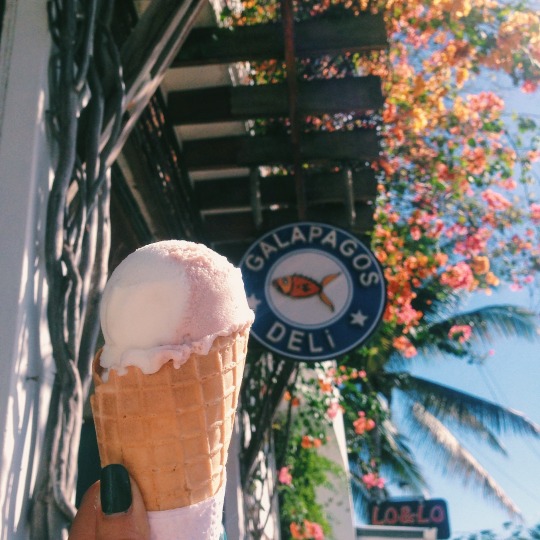
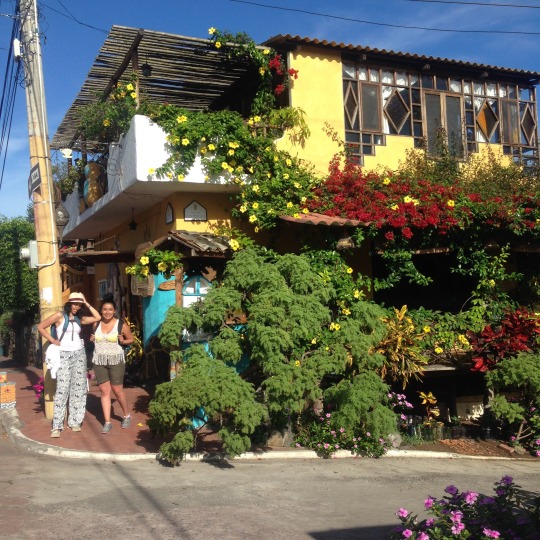
Now that we were full, we walked over to Laguna de las Ninfas (“Lagoon of the Nymphs”), a peaceful lagoon with plenty of shade and a great little dock for napping. By the time I woke up, I realized I had been drooling through a crack in the dock I was laying on - literally, drooling. I haven’t drooled in my sleep since I was a kid, so if that isn’t a testament to how good of a nap it was, I don’t know what is.
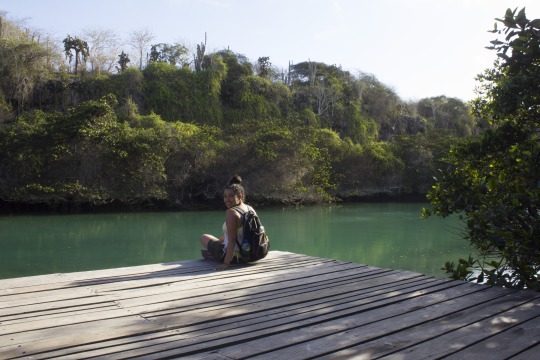
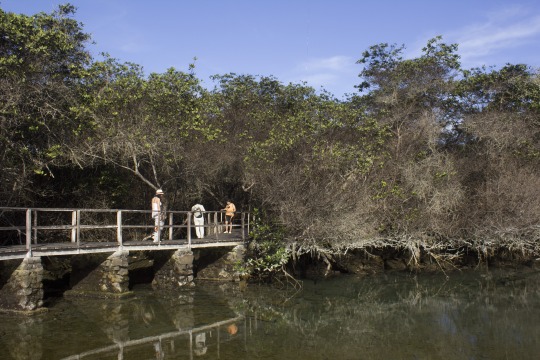
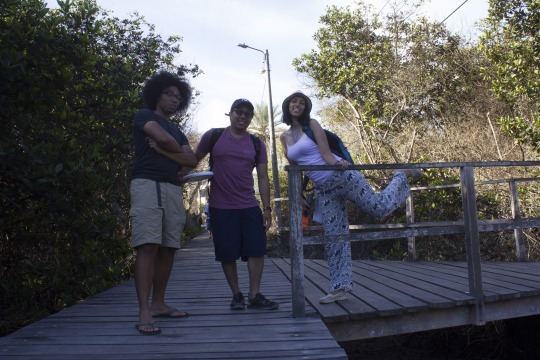
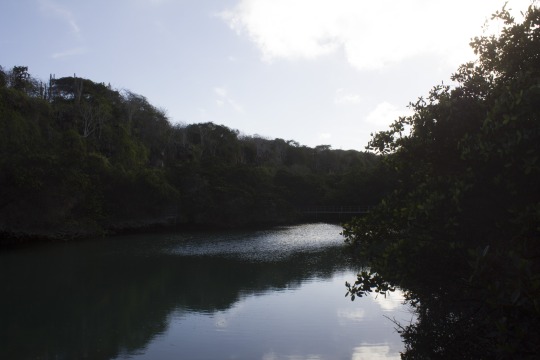
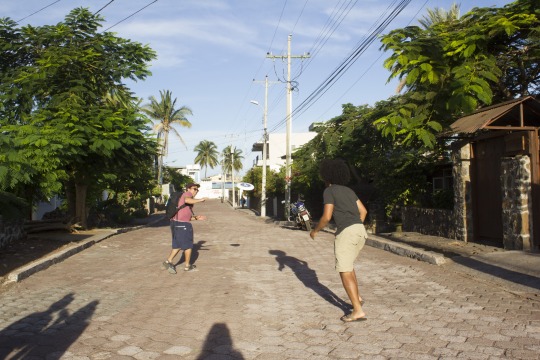

Since it was still early in the afternoon, we decided to take a walk through Puerto Ayora towards Baltra, with the goal of reaching a high vista to watch the sunset. The walk was a long climb uphill, and we never did make it to a vista, but we did witness the beautiful palette of pink hues dancing across the horizon while we explored the terrain.
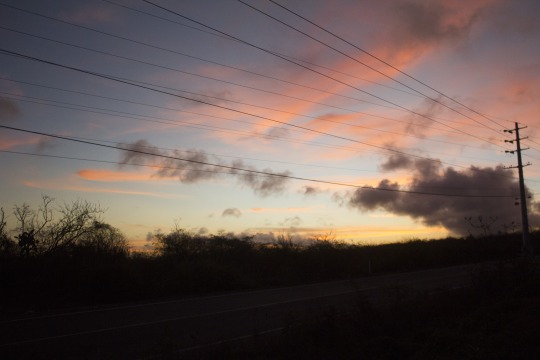
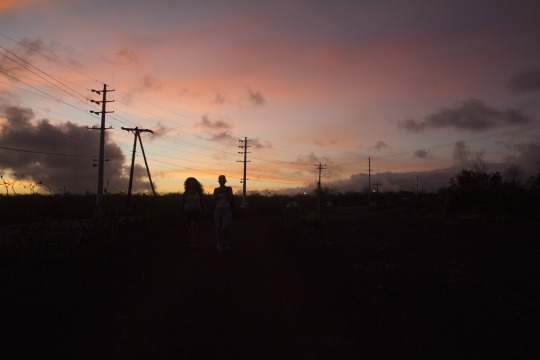
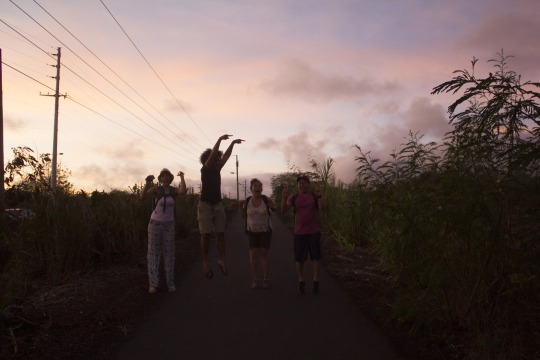
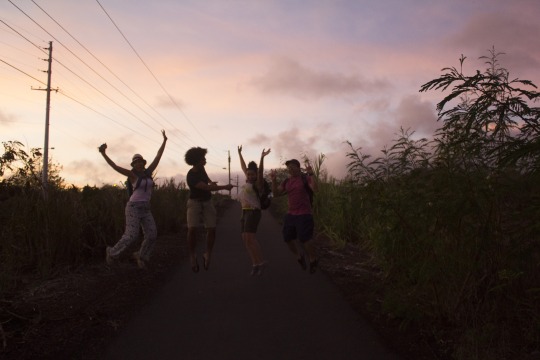
Later that night, we met up with Claudia at Los Kioscos (“The Kiosks”) for some fresh seafood. At the corner of Avenida Baltra and Charles Binford, you’ll find a street lined with local restaurants, framing the cobbled road filled with plastic tables and chairs crowded with tourists and locals picking out their dinner to be cooked right on the grill in front of them. For most dishes, you can choose how you want your dinner cooked - a la parilla (roasted over charcoal grill), al ajillo (pan fried with garlic), frito (deep fried), a la diabla (with spicy red creole sauce), or encocado (in a rich coconut sauce). I opted for shrimp that night, which came with a side of rice, cole slaw, and papas fritas.
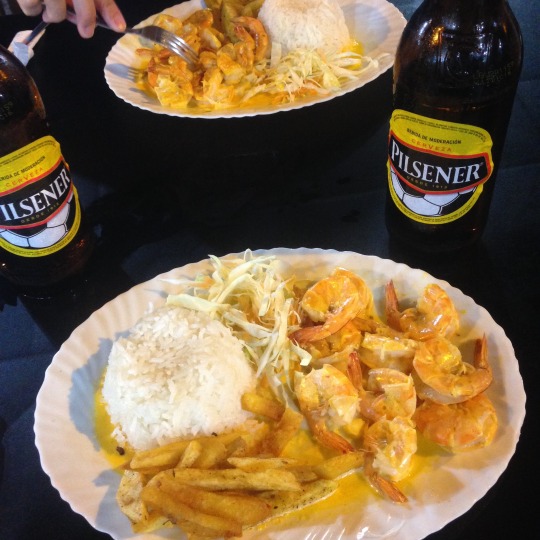
7/30, Saturday: DAY 9: SANTA CRUZ
On Saturday morning, we woke up early to head to Tortuga Bay, the gem of Santa Cruz on the southern coast, famous for its expansive and pristine shoreline that gradually descends into the sparkling Pacific Ocean. Visitors have to sign in before trekking on the 1.55 mile path surrounded by cacti, palo santo trees, and matasarno trees that leads to the beach. In the sun, the journey feels exhausting, but once we arrived, the view was breathtaking - a picturesque soft white sand beach that greeted us with gentle breezes.
Since this beach tends to have strong currents, we walked another twenty minutes towards a smaller beach adjacent to lagoons, where the waters are much more calm and ideal for snorkeling or kayaking. On the way there, we passed dozens of black marine iguanas hanging out under the shade of the mangroves. Claudia and I decided to snorkel and sunbathe for a bit while X and Will rented a kayak from a guy with an eight-pack. Unfortunately, Giss had homework that morning so she arrived a bit later and only got to enjoy the shade where plenty of little Galápagos finches were delicately hopping around in search for crumbs around visitors.
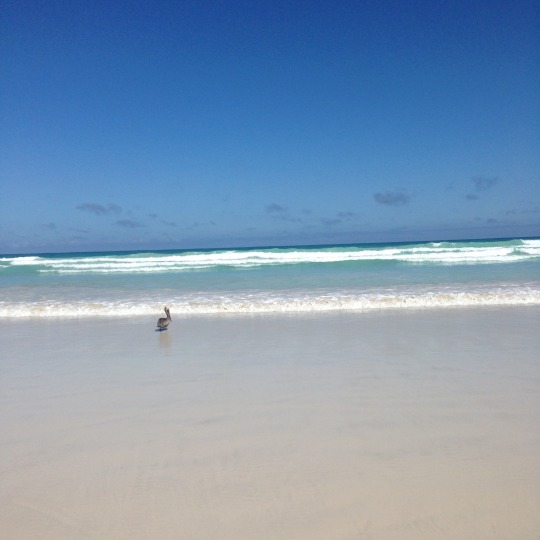
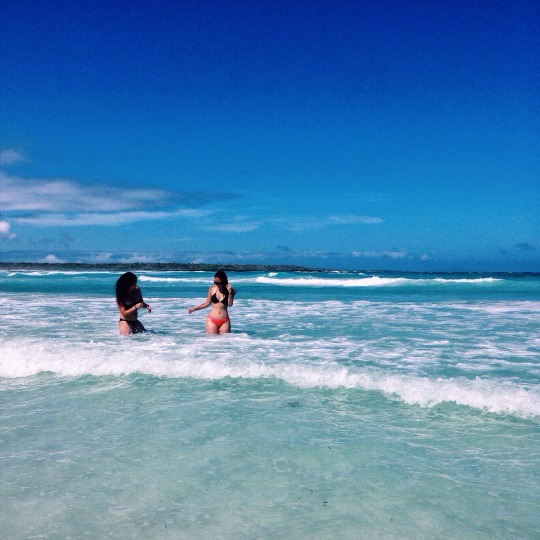
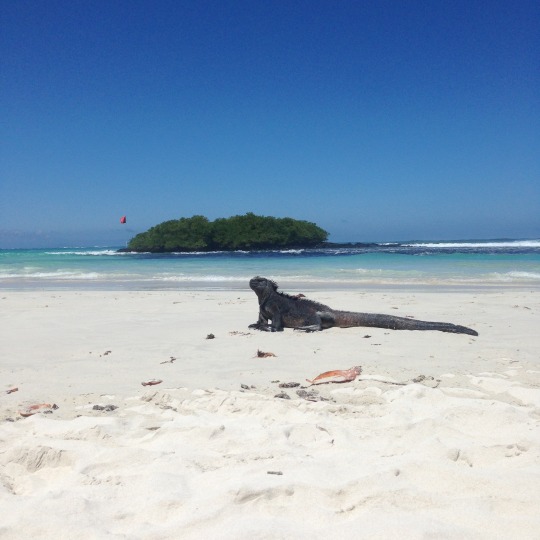
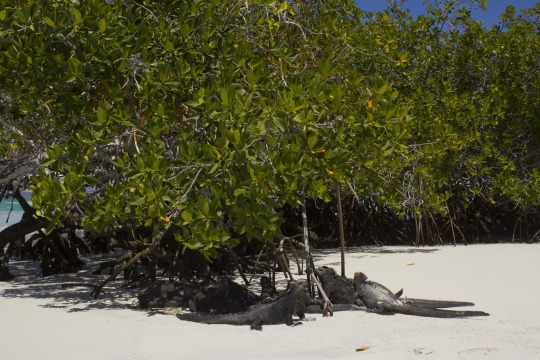
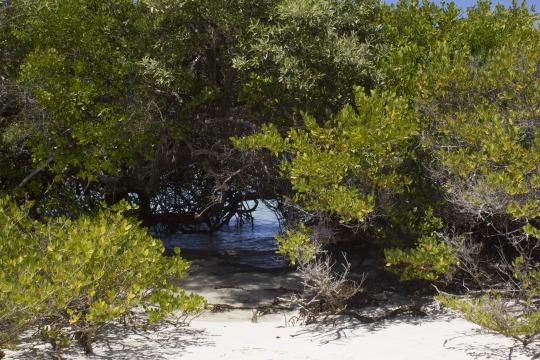
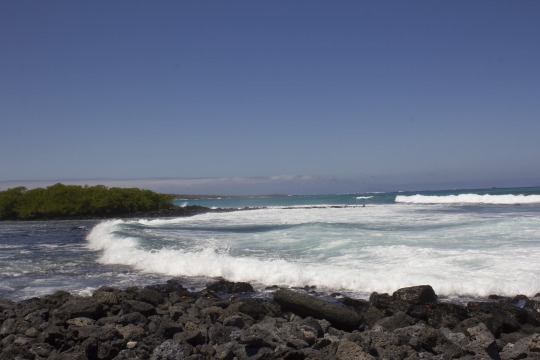
Even though we could have spent the entire day basking in the sun right there in paradise, we had one more visitor site in mind for the day, since Clau and Giss would be leaving for Isabela the next morning and only returning to Santa Cruz for one last night on my birthday that coming Monday. We headed back through the flawless horizon of Tortuga Bay and down the cobbled path between the cacti into town again.
Once we got to town, we hailed a pick-up taxi to negotiate a price to visit El Chato. The El Chato Tortoise Reserve is privately owned land, and located just south of Santa Rosa in the highlands. Apparently, admission is $3 but I honestly don’t remember paying, although we were greeted by the owners of the café on the reserve, who offered us complimentary cups of coffee and tea after we had hiked the grounds. I’m not sure if it was because we arrived late in the afternoon and that the reserve is only open to visitors from 8am to 5pm, but it felt like we had the whole place to ourselves.
We only had about an hour there, roaming the open spaces coming face to face with these majestic prehistoric creatures. The Galápagos tortoise is the largest living species of tortoise, and native to seven of of the islands, with a life expectancy of over 100 years. Within the archipelago, at least 14 species of Galápagos tortoises have been identified, although only 11 survive to this day, living on 10 of the largest islands. Several of the surviving species are seriously endangered. One of the species, C. abingdonii from Pinta Island, is considered extinct. The last known specimen, named Lonesome George, died in Isla Santa Cruz on June 24, 2012. George had been mated with female tortoises of several other species, but none of the eggs from these pairings hatched. Charles Darwin’s observations of the differences in characteristics of Galápagos tortoises in 1835 contributed to the development of his theory of evolution.
(source: Wikipedia & Galapagos Conservancy)
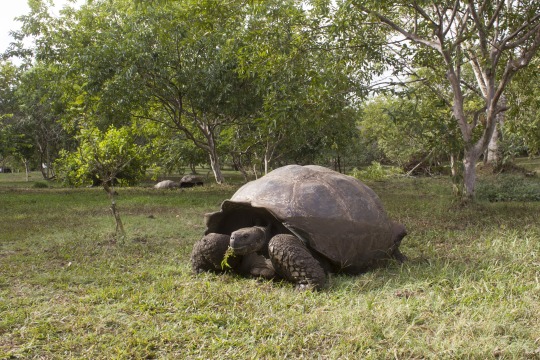
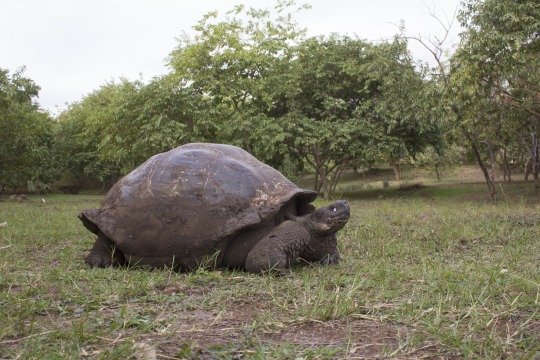
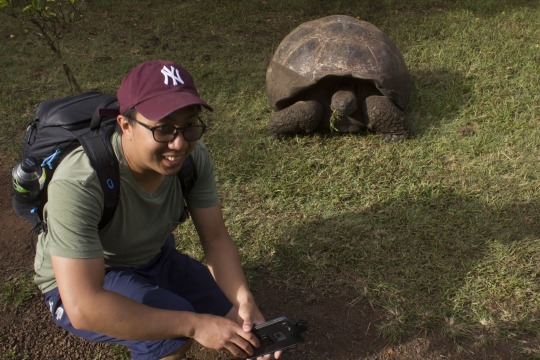
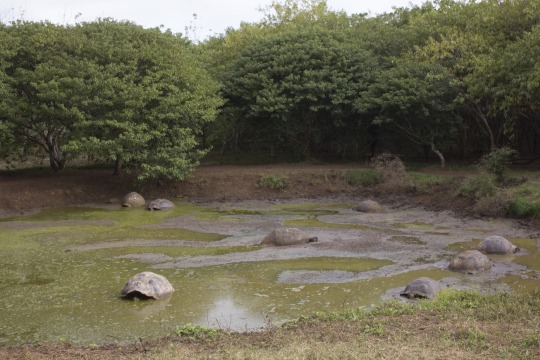
As we walked around, we noticed that some of the tortoises were munching on the abundant fruits scattered under trees, so we picked them up and instantly recognized their fragrant smell. Guayaba, or guava, grows all around El Chato and leaves their delicious little fruits for tortoises (or in our case, visitors) to eat. All it took was a little brushing dirt off, and there we had an instant snack!
If you’re reading this, you probably know me well enough to know that Jurassic Park is my favorite movie. Of. All. Time. Because of this, I’ve always kept a special place in my heart for dinosaurs, so coming this close to the unique endangered species of dinosaur-like animals was a lot like that scene where Lex and Tim are sitting in a tree with Alan admiring the brachiasaurus grazing from the trees around them.
It’s important to note that while we were able to enjoy the fruits of the earth (get it? lol), there are certain fruits in the Galápagos that should be avoided at all costs. Manzanitas (little apples) grow from the endemic Manzanillo tree, also known as the Poison Apple Tree due to their highly toxic fruit and leaves. In fact, even just skin contact with the milky white sap that the leaves contain can cause blistering and burning on the skin. Eating the fruit can be fatal too, although only the Galápagos tortoises are able to digest these poisonous apples. It’s a good thing we didn’t mistake manzanitas for guayaba!
(source: Red Mangrove)
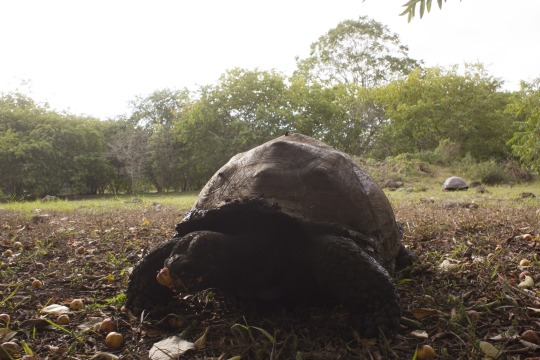
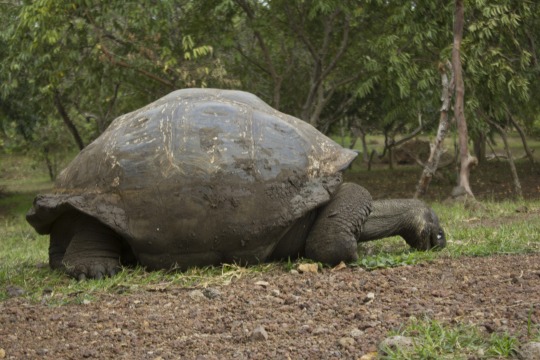
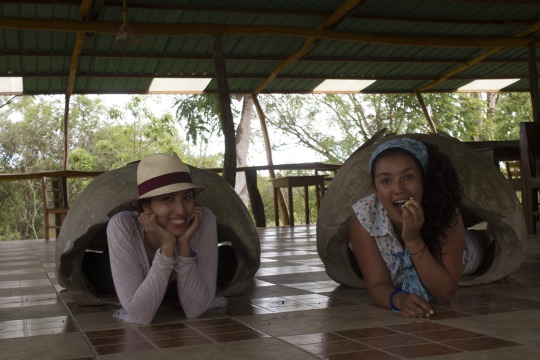
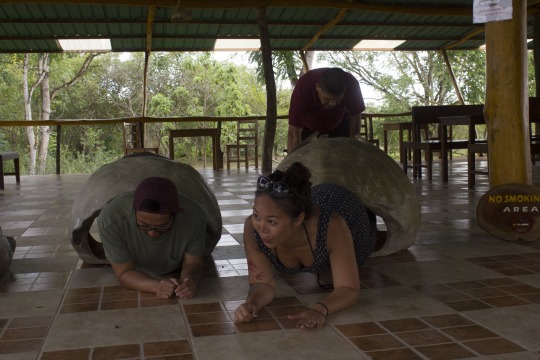
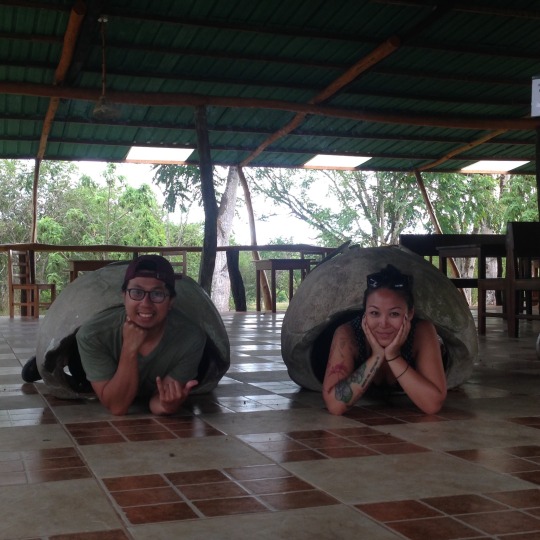
As the sun began to set, we realized we only had enough time to quickly explore some of the underground lava tubes that span throughout the volcanic belly of the island. At El Chato, there are several entrances to these tunnels that formed when surface lava cooled and solidified, while the underground molten hot lava continued to flow, eventually leaving an emptied cave.
(source: Galapagos Conservancy)
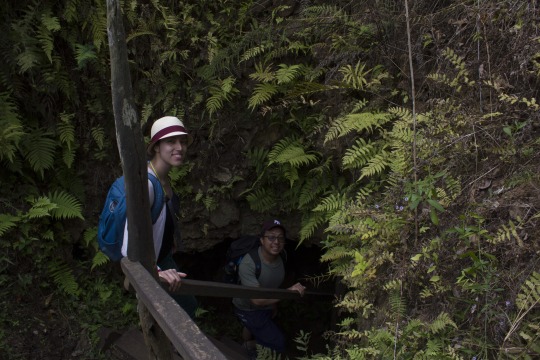
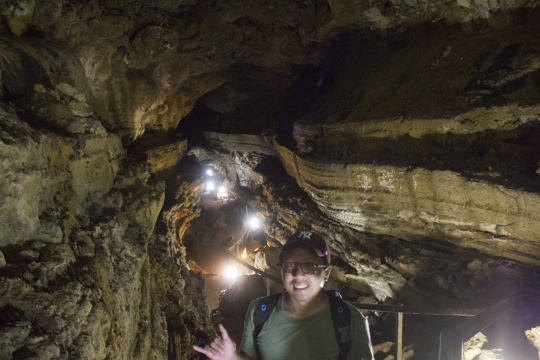
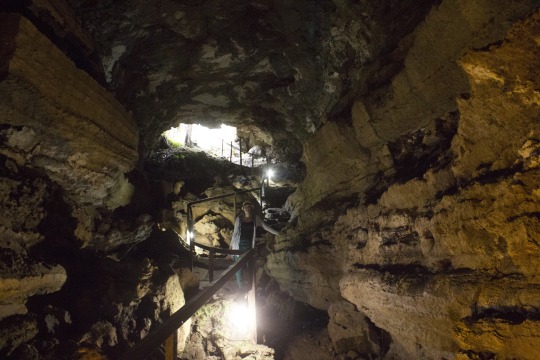
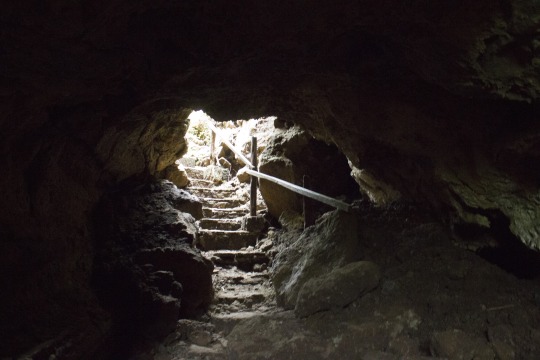

Since we were the last visitors on the property, the hosts at the café generously offered us as much coffee and tea as we wanted as we posed with real tortoise shells and collected as many guayaba as we could hold. On the way back, our taxi driver suggested that we stop in Santa Rosa for a road-side snack. At first my eyes darted to the empanadas that were huge and crispy, but the real prize were the potato balls that Will still dreams of to this day.

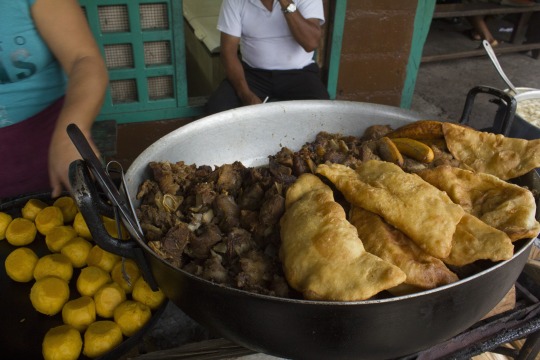
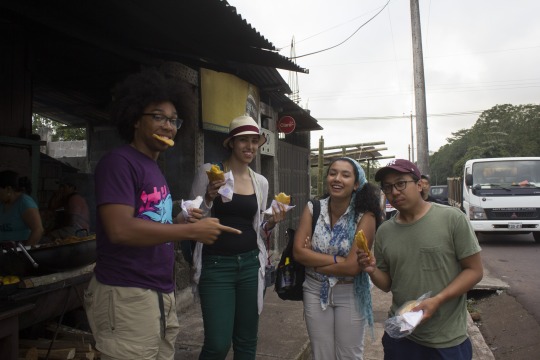
When we made it back into town, we headed to the Kiosks again so Giselle could experience the divine fresh seafood we tried the night before. This time, I opted for the whole brujo (mottled scorpionfish) fish wrapped in foil and grilled right over a charcoal grill in front of our table. As a kid, my favorite part of the fish was always the eyeball, so I had no shame stripping this delicious masterpiece to its bare bones. I just wish I remembered to take an “after” picture for dad, the king of eating whole fishes and cleaning bones.
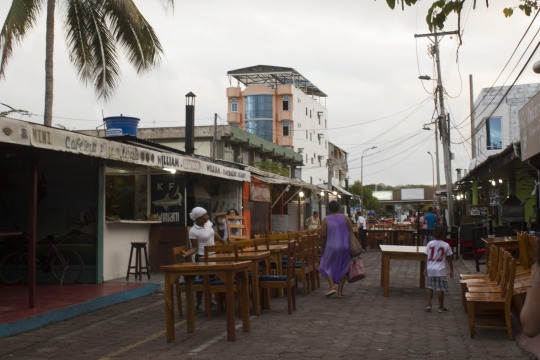
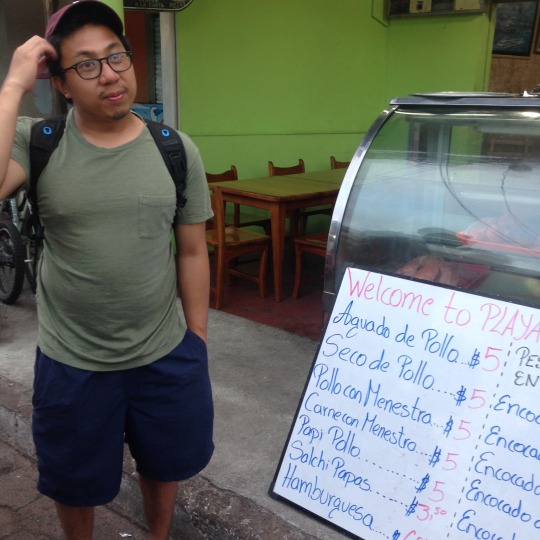
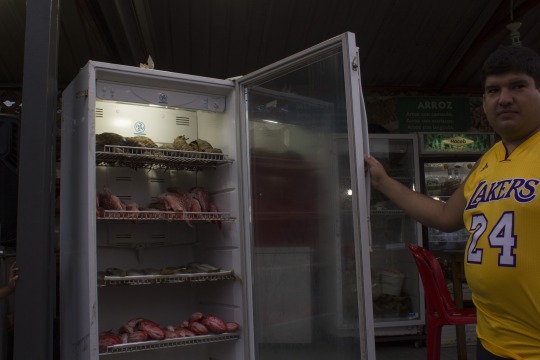
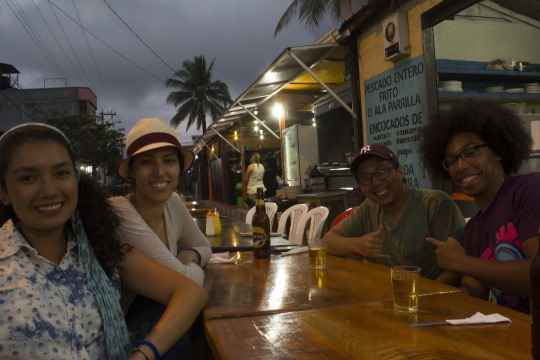
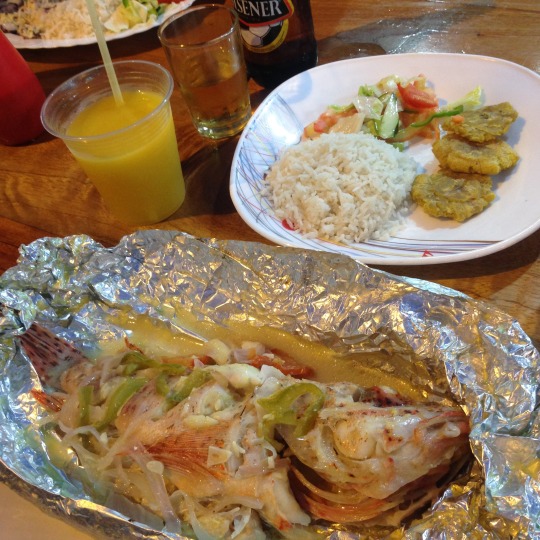
After we ate, we parted ways to get ready for what we expected to be our last night out together, since Clau and Giss would be leaving for Isla Isabela the next morning, and they weren’t sure how much time they would have upon their return to Santa Cruz before heading back to the mainland. Giss ended up having a lot of homework to get done, so Clau joined me, Will, and X at Bongo to share some drinks and celebrate the beautiful bond of friendship that bloomed from our time together. It had only been a few days, but in less than a week, I felt like Claudia knew me at my core, and that in some past life, we had been sisters bound by the light of our souls. There is really nothing more amazing than the realization of how many incredible, loving beings there are roaming this earth waiting to meet you, and who are meant to change you on your journey through this life. Seven months after this trip, Clau and I still keep in touch almost every day and share our magic moments with each other, because I know that she truly understands me.
When we got there, it was so crowded that we had to hunt for a table to free up in the corner of the terrace before we could sit. Once we did, we took turns going to the bar since we didn’t want to give up our spot, but since my birthday was two days away, Will and X kept buying my drinks for me. We were content with just sipping on our drinks and people watching until Clau leaned in to ask, “So, are there any boys here you think are cute?” to which I shook my head at once I scanned the terrace again. Clau wasn’t convinced, “Really?! But it’s your birthday, we should dance! Are you sure?” Doubtfully, I looked around again, but no one caught my eye except for the bartender, who was so busy I never even saw him look up once, so I told Clau, “Well, the bartender.. but he’s the bartender.” I kept glancing at him, glowing under the bright overhead lights behind the bar, an angelic contrast to the dark and humid air hovering over the crowd, but his eyes stayed low, focused on the swift movements of his hands, pouring, mixing, pouring, mixing. Regardless, a lack of cute boys to dance with was not going to stop me from dancing.. especially not when I had my friend Jack Daniels to keep me company.
By the end of the night, I had taken back an unknown number of Jack & Cokes, and an even more mysterious number of Jack on the Rocks. Clau claims that I was speaking Spanish to her flawlessly, and X claims that I was demanding pizza [in Spanish], but somehow they managed to tuck me into bed that night.
7/31, Sunday: DAY 10: SANTA CRUZ
The next morning, we all woke up far too late. After grabbing a quick empanada to start us off, we headed through the small streets in search of a good place to sit down for breakfast and ended up at a lovely little place called Lo & Lo, which was right next to the Galapagos Deli. Still reeking of whiskey and too ashamed to take my sunglasses off just yet, I struggled to figure out what to order while X and Will revelled in making fun of me from the night before. Apparently, after I demanded pizza, X had set out on foot in search of late night snacks, and had been stopped in the street by a man looking for me. Immediately, I pictured the bartender from the night before and secretly hoped it would be him when I asked, “What did he look like?” but when X started describing him, I knew it wasn’t him. Disappointed, I broke into my bolon reluctantly, unable to enjoy its perfection. Suddenly, X exclaimed, “Wait, that’s him!” as a tall, tan, handsome man took a seat at a table with friends. But it wasn’t him. I needed a nap.
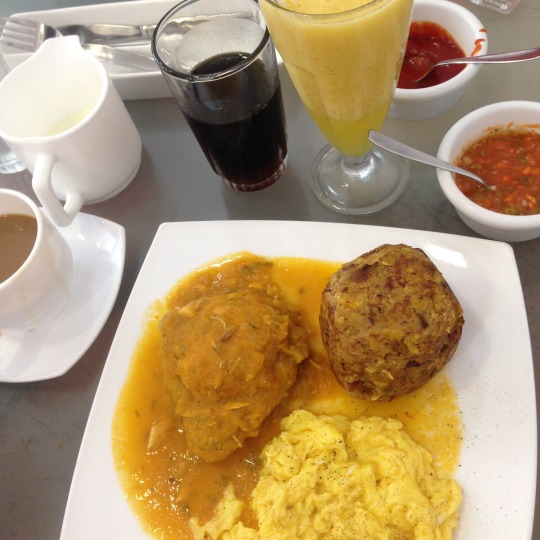
After we ate, we headed back to Galapagos Native to pack and check out before heading to Galapagos Dreams to check in. You may be wondering why, silly Jasmine, would you book two separate hostels within a few blocks’ walking distance of each other? Loyalty, that’s why. I had booked our second location first, knowing that I’d want to go on a tour in search for fur seals. The Galapagos Dreams hostel offered a room and tour package, so we booked this early in the year. Later, when we planned our itinerary and realized we’d be staying in Santa Cruz for longer, we decided that if one of the two hostels turned out to be less than accommodating, at least we would only be staying for a few days at either. Weird logic? Kind of, but the more experiences, the better, right? Change is good! Don’t judge me. Anyway, we had to switch hostels.
Once we settled into Galapagos Dreams (~$30/pp per night for a 3-bed room), which offered a bit more privacy since it’s on a quiet road, we just spent that Sunday afternoon relaxing. Later that day, Will and X were craving pasta, so we headed out for dinner at Café Hernán and some snack & souvenir shopping before calling it a night. Usually, I’m awake when midnight strikes and it’s officially my birthday, but this time, I was knocked out with an open bag of Dorito’s by 10pm.
8/1, Monday: DAY 11: SANTA CRUZ
My 25th birthday started off low-key, with ice cream for breakfast (of course) at il Giardino, one of the cafés on Ave Darwin. After that, X wasn’t feeling very well, so Will and I decided to rent bicycles. In case you don’t know, I never learned how to ride a bike. In fact, both of my brothers and I were never taught, although Jordon has recently learned (yay!). Will took this big brother duty seriously, and decided he wasn’t going to let his lil sis get left out of activities anymore. Unfortunately, after about an hour of learning how to balance in motion, I crashed right into a curb and broke the chain off the rental bike :(
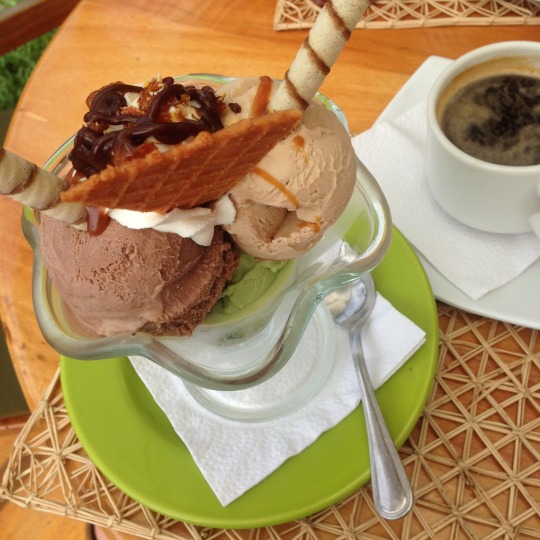
We spent the rest of the day relaxing while X recovered, until dinner when Clau and Giss surprisingly arrived back to Santa Cruz early and were able to meet with us! I was so happy to see them again, and this time they had brought friends! Clau and Giss met Ivan, a Filipino Australian who was traveling solo while visiting Isla Isabela, and then ran into Giss’ cousin with her friend upon returning to Santa Cruz. Suddenly, our little trio turned into a party of eight! Once we all met, we walked around Ave Darwin drinking beers for a bit to decide where to eat. Eventually, we ended up at La Garrapata, the al fresco restaurant right below Bongo, next to La Panga. Ironically, the tall handsome man who had asked X about me was our waiter that night.
I can’t tell you how lucky I felt that night, surrounded by old and new friends, as if the universe was reminding me that the world is full of loving people just waiting to be met. And just as I was relishing in the sweet company surrounding me, the bartender from Bongo came hopping down the stairs, straight to the bar of La Garrapata to pick up a plate of food before disappearing upstairs again. I don’t think anyone else caught me in that moment of delightful surprise other than Clau.
I’m not sure who told the waiter it was my birthday, but after I devoured my delicious ceviche dinner, I was surprised with a slice of chocolate cake and candles. Giss and Clau even got me a present so that I had something to unwrap - and it was the most perfect gift - a stuffed animal sea lion that doubled as a backpack.
After dinner, we decided the only proper way to end the night would be to return to our beloved Bongo. By the time we got upstairs, I was so nervous that I couldn’t even bring myself to the bar to order drinks, let alone look the bartender in the eyes. Instead, I played it off as being tipsy and stole glances of him every now and then. Somehow, news had spread from La Garrapata to Bongo that it was my birthday, as one of the servers brought over a flaming shot for me. Soon, we were taking group shots and I was d-r-u-n-k. We were pretty much the only patrons at the bar since it was a Monday night, but that didn’t stop us from having a great time. I think everyone started to catch on to my crush, because as we were dancing inside, Giss nudged me and nodded behind me as a signal to turn around. Of course, who else would be standing there watching us dance but the dreamy bartender. Still nervous, I quickly turned back around without so much as eye contact.
By the time we were ready to leave, literally every person in our party had offered some kind of encouragement to talk to the bartender. My secret crush was now public news. Too drunk to compose myself, too nervous to strategize a plan, I decided to just walk away. But just as we were descending the stairs, Ivan asked us to wait for him. “Be right back!” he said, and I thought nothing of it, assuming he was running to the bathroom before the walk back to our hostels. A minute later, he returned. With the bartender.
Suddenly, I was face to face with this stranger, but somehow when I looked into his eyes, I felt like I had known him for lifetimes before. “It’s her birthday, and she thinks you’re cute,” someone said - I don’t know who, everything around me was now a blur - “Really? Thank you,” he said with a sweet smile before he asked my name. “Jasmine,” I whispered, as he took my hand, kissed it, and said, “Raúl.” My heart was beating out of my chest.
Pretty soon, we realized that we could hardly speak each other’s languages as we scrambled to find a way to stay in touch. I tried to explain that I was traveling with a phone that didn’t have service on it, so I couldn’t do much. He took his phone out, and I nervously chose Facebook, typing my name in. Never in my life have I ever been more frustrated at how many other Jasmine Chows exist on this planet. Once he realized I was having a hard time finding myself, he just pulled up his phone pad and asked me to put my number in. Foolishly, I did this, and left with a kiss on the cheek… only to realize a block down the road that there would be no way for him to contact me with that number until I returned back to the US. Jasmine, you idiot.
8/2, Tuesday: DAY 12: SANTA CRUZ
A few hours later, we were waking up at the crack of dawn for our last tour in the Galápagos, and my final chance to spot the elusive Galápagos fur seal. Ever since we began planning this trip, I had been on a mission to find the fur seals. I had even coined a jingle called Fur Seal Island with a catchy tune that I caught Will humming along to once. In fact, when we booked this particular tour to Isla Bartolomé with Galapagos Dreams Tours ($175/pp), I had specifically asked if there was a chance we would see fur seals.
I suppose you could say that Pacific Tours in San Cristobal had spoiled us, because we certainly weren’t expecting the large group that joined us on this tour. At exactly 6:00am sharp, a mid-sized bus pulled up in front of our hostel to pick us up, as Jonathan (who owns Galapagos Dreams), handed us our snorkeling gear to take aboard. Not much was explained to us about the tour beforehand, so we were completely unaware that we’d be spending our day with the same people on the crowded bus, which we were last to board onto.
When the bus arrived to the port at Baltra an hour later, we groggily made our way out to join our group at the dock. Soon, we realized that the tour was catered for Spanish-speakers, and we were the only ones who needed the tour guide to translate to English for us. Somehow, I felt like our version was trimmed down a bit, and lacked the jokes and anecdotes that we enjoyed as a group on our San Cristobal tour. Regardless, it was a beautiful sunny day, and I was ready to enjoy the spectacular views from Bartolomé. Will and X, on the other hand, were still exhausted from celebrating the night before and both slept through the entire boat ride.
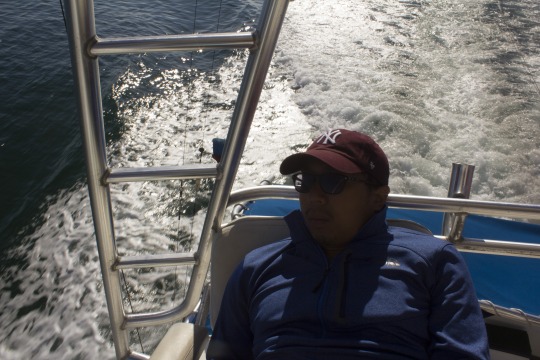
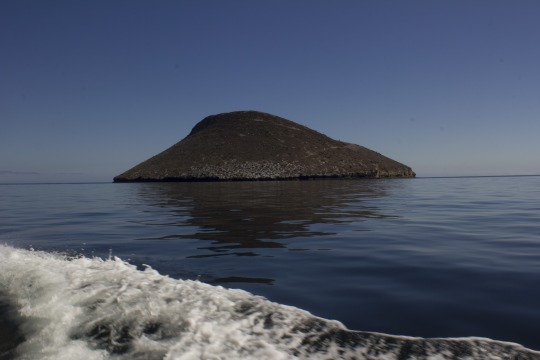
Isla Bartolomé is a volcanic islet just off the east coast Isla Santiago. Although is one of the “younger” islands in the Galápagos archipelago, it is the most visited and photographed of all the islands. With a total land area of just 1.2 square kilometres (0.5 square miles), this island offers some of the most beautiful landscapes in the archipelago, consisting of an extinct volcano and a variety of red, orange, green, and glistening black volcanic formations. Bartolomé is famous for its Pinnacle Rock, a volcanic cone, that was formed when magma was expelled from an underwater volcano; the sea cooled the hot lava, which then exploded, only to come together and form this huge rock made up of many thin layers of basalt. When we arrived, we docked at a small bay opposite Pinnacle Rock and began to climb the 600 meter trail to the 114 meter summit to enjoy views of Pinnacle Rock, the immense black lava flows at Sullivan Bay and the rest of Santiago Island, and Daphne Major and Minor.
(source: Wikipedia & Galapagos Conservancy)
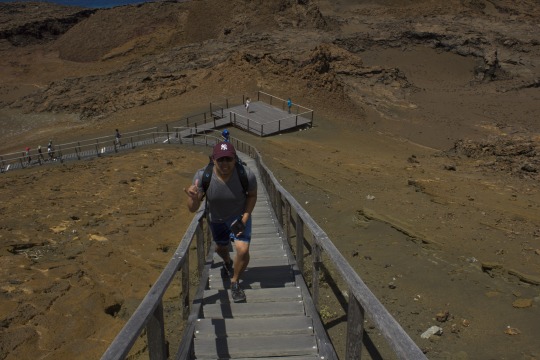
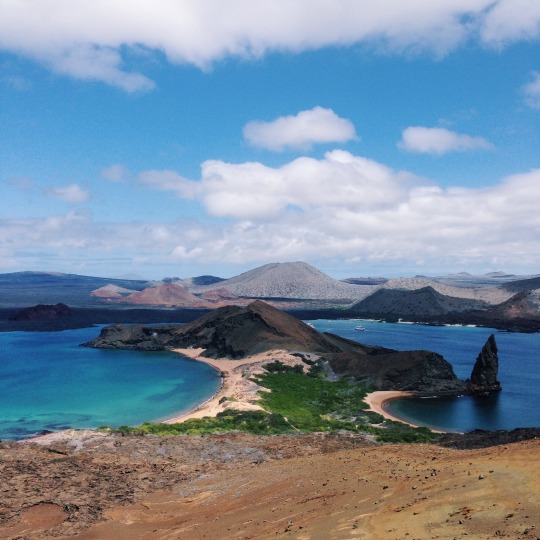
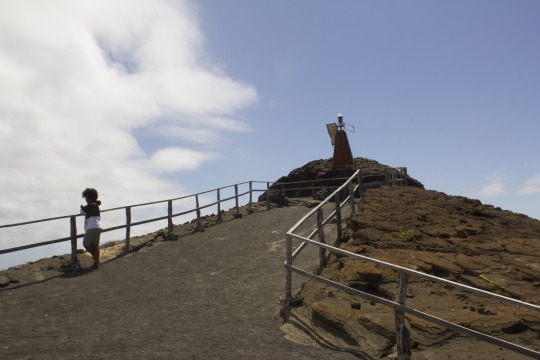
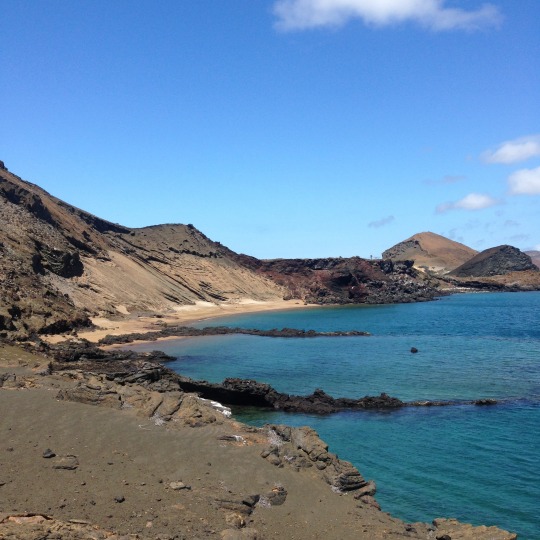
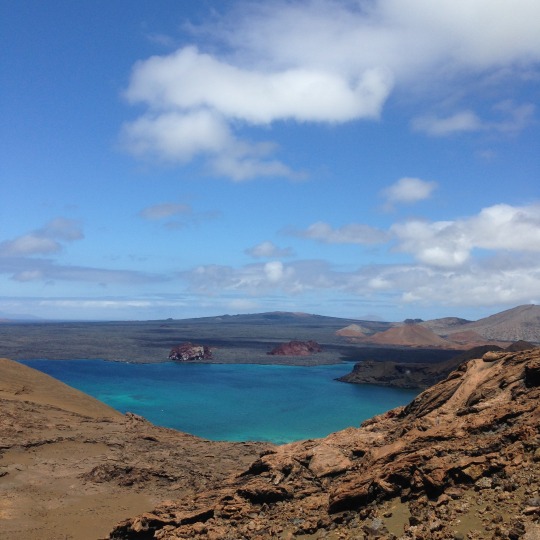
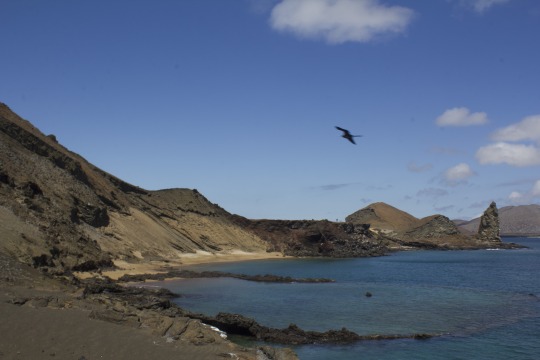
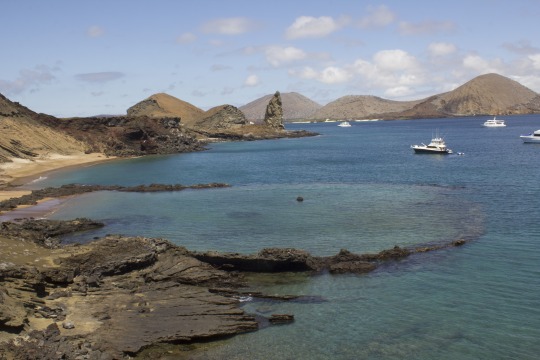
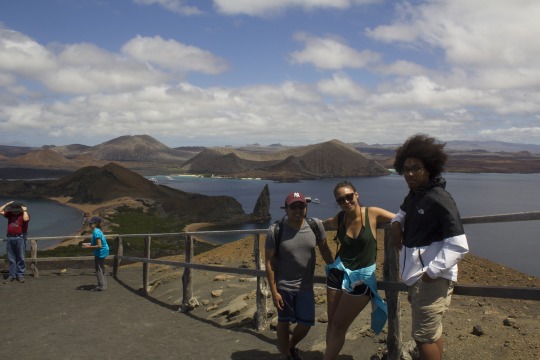
Along the way, I began to talk with a woman who works for IBM and was traveling solo from Venezuela. She was really sweet, and we bonded over our opinions on enjoying life and the little time we have on this earth. After our hike, we headed back down to the boat, which took us to the north beach adjacent to Pinnacle Rock. Here, we were able to snorkel around a particularly active reef, where tons of colorful fish were swimming around. Since it was an overcast day, the water was too cold for most people. X and Will had pretty much determined they were going to spend the entire tour day napping whenever they could, so they took this opportunity to lay on the beach. But for me, it was my last afternoon in the beautiful paradise of the Galápagos Islands, and I wasn’t going to waste any chance I had to jump into the ocean.
I’m not going to lie and say that I wasn’t disappointed when the tour guide told me that fur seals are hardly ever spotted during the day, but I was still glad to swim around the magnificent sea life I was feeling particularly grateful to be surrounded by that day. So there I was, minding my own business, drifting along with the currents and marveling at the beautiful fish, when suddenly a playful sea lion swam out of nowhere and started twirling all around me. Now, I was perfectly aware of the rules - humans are not allowed to touch any animals in the Galápagos, especially sea lions, whose mothers abandon them if they smell the scent of a stranger on their babies. I did my best to avoid bumping straight into this little guy, but he literally bopped his nose right onto the GoPro I was holding onto and proceeded to swim circles around me! By now, the other tourists that had been relaxing on the beach were clamoring to get into the ocean to get a closer look, but once the crowds got in, my playful friend disappeared back into the waves. I like to think that he was a messenger sent by the fur seals to wish me a happy birthday and apologize for their absence.

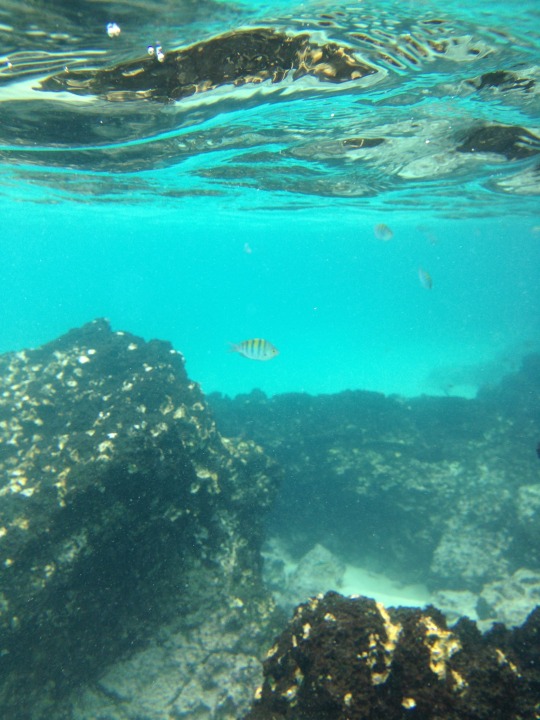
After snorkeling, we boarded the boat again for lunch before embarking back to Santa Cruz. Since this was a much larger tour group, the boat was larger too, and was equipped with a kitchen and dining area below deck. We enjoyed a nice hot meal prepared by the crew before heading back to shore. This time along the way, I chatted with Javier, who was traveling with his wife, parents, and two daughters and their boyfriends from Puerto Rico.
By the time we arrived back to Puerto Ayora, it was late in the afternoon and we were exhausted. We headed back to the hotel, but I realized I didn’t have any more shampoo left, so Will and I set out to walk to the supermarket by the pier. It wasn’t a long walk - only about 10 minutes, but the entire time, I felt like people were looking at me. I get paranoid all the time, so I tried to brush it off, but I couldn’t help but notice eyes from shops and cafes all along Ave Darwin glancing at me, some turning their heads to look. Feeling self conscious, I asked Will if he noticed, but he was busy on his phone. He started to reassure me, “No one is looking at you,” when suddenly, as we passed La Garrapata, he said, “Oh wait, our waiter from your beeday just pointed at you.” I thought this was strange, but had no explanation, so by the time we got to the supermarket, I forgot about it all. That is, until we started on our way back. Hands now full with shampoo and nail polish remover, and the sun already set, we walked along Ave Darwin back towards our hostel. Again, I felt eyes on me, and thought I even caught someone chuckling at me. Now it felt like the Twilight Zone and everyone knew a secret that I wasn’t aware of yet. Then, as if the stars themselves had done this for me, there he was.
I’ll never forget that image of Raúl, with a teal tank top and a backwards burgundy hat on, smiling that dreamy grin that could melt the skin right off of me. He was standing with friends, eating out of a granola foil or candy wrapper. “Hello,” he said. I was literally speechless. All I could do was smile and keep walking. A few strides away, an American couple behind us were giggling. The woman said to me, “Those guys were definitely checking you out.” I couldn’t even bring myself to glance back. Jasmine, you idiot.. after giving him your number, which he can’t even use to contact you, and realizing that you hadn’t activated WhatsApp on your travel phone so you couldn’t even use that with WiFi, you just walked past him? Idiot.
Now we were back at the hostel, and I was baffled at myself. I was desperately trying to connect to WiFi to ask Kellie for advice, but nothing was going through. Feeling defeated again, I took a shower, and we decided to head back to il Giardino for dinner. At dinner, I could hardly eat. I was suddenly feeling so nervous again, and I didn’t know what to do. Will and X insisted that the only thing I could do was to go back to the bar that night. They weren’t going to come with me, but it was the only way I’d get to see Raúl again. So after dinner, I packed all my bags, knowing we would have to leave the next morning at 5:30am to take a taxi to the airport. I didn’t know what time I would be out until, but I wasn’t going to take any chances.
My heart was beating like a drum again as I walked down Ave Darwin. I could feel my heartbeat in my throat as I tried to swallow every breath. I climbed the stairs to Bongo slowly, nervously. When I got to the last step, I stopped. There he was, glowing under the overhead lights just like the first night I saw him, and suddenly a wave of calm washed over me. I took a seat at the bar and asked for a Cuba Libre, and then I watched him - pouring, mixing, like that first night. But this time, he looked up, and there I was - falling in love with him.
I spent the rest of the night sitting on that bar stool until closing, mostly just chatting with the few other patrons, including a frequenter named Chino, and a scuba instructor named Victor who tried to earn a quick $40 to split with me by bringing me over to a table that told him they’d pay him to get my attention (I refused). At one point, Raúl asked to take a photo with me, which I’m pretty sure he then sent to his friends. Coincidentally, shortly after we took the photo, the tall waiter who had served us on my birthday came running up the stairs laughing, to playfully punch Raúl in the arm. They had been friends all along - the guy who, at the beginning of our trip to Santa Cruz, was looking for me, and the guy who, by the end of our trip, I had been looking for.
After he closed the bar, Raúl took me for a walk around Puerto Ayora, and asked me if I was hungry. Instinctively, I said yes (because I’m usually always hungry) but I was still too nervous to eat, so when we sat down and he ordered two enormous identical plates, I’m sure he got the wrong impression of my appetite - after all, he scarfed down his entire plate of chicken, rice, beans, salad, and fries in a few minutes, and all I did was pick at my fries. When he got up to pay, I offered some money, but he refused. Feeling guilty about all the food I was wasting, I asked him if we should wrap it, and he just assured me that it was okay. He was so genuine in the way he said, “it’s ok, you’re full” - all I wanted to do was kiss him.
By the time Raúl walked me back to the hostel, the sun was just about to begin rising, and our taxi truck was already waiting outside. When he hugged me and asked me not to go, something in my heart told me I knew I would be back, so I promised - I’ll be back.
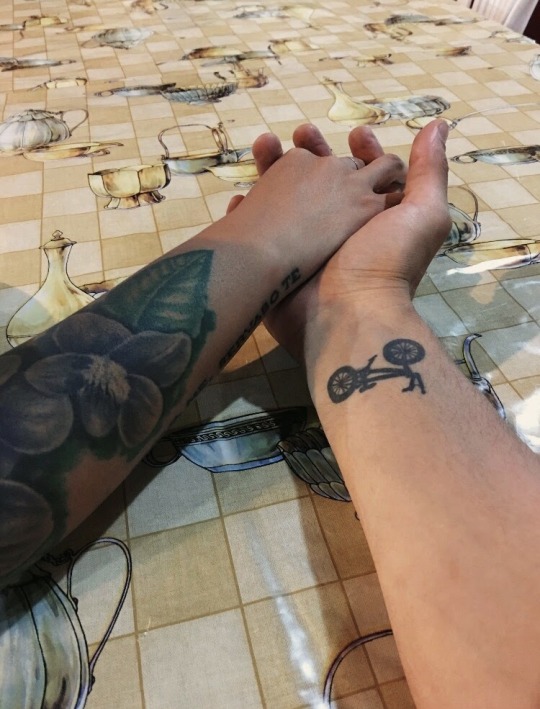
8/3, Wednesday: DAY 13: SANTA CRUZ // QUITO
Still sleepless when we landed in Quito, we stopped for a quick bite inside the airport before hailing a cab to our hostel, Hotel Cuba Vieja (~$25/pp per night for a room with 2 beds & a cot), a beautiful and cozy little place with colonial vibes and the most amazing complimentary breakfast. When we arrived, I immediately fell onto the bed to take a nap. By the time I woke up, it dawned on me the huge difference in WiFi connectivity here in Quito versus in the Galápagos, as messages started spilling in. I was surprised that the boy I met at Leprechaun in Baños had found me on Facebook and messaged me to let me know he had taken a bus to Quito and would be here for a few days with friends.
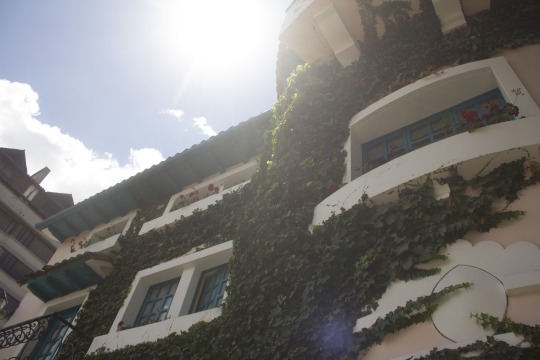
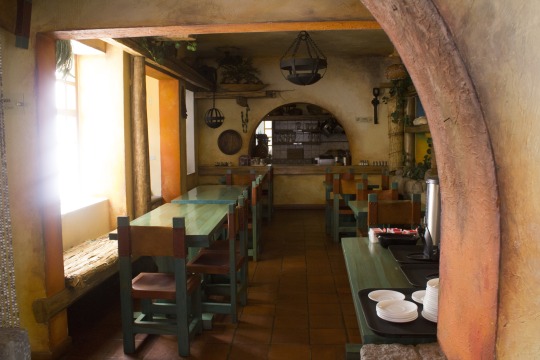
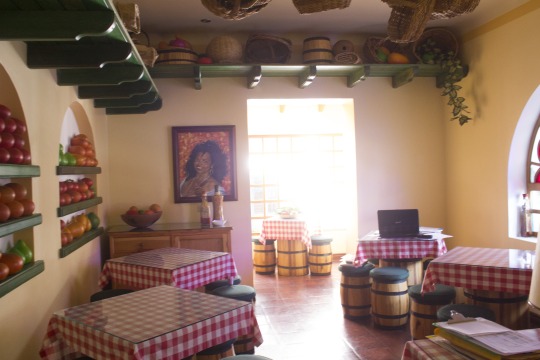
We met up at the Juan Váldez Café at Plaza Foch in La Mariscal Sucre, where he was hanging out with a friend named Iris, a beautiful blonde Russian who spoke perfect Spanish and English too. Little did I know in that short encounter with Iris that she would become one of my closest and dearest friends, who I would return to Ecuador with a few months later.
Later, we met up with Will and X at Azucar Beach just across the street for some drinks. I was feeling extremely tired and congested from the elevation of Quito, so I could barely finish my beer before needing to call it a night.
8/4, Thursday: DAY 14: QUITO
The next morning, we set out early to take a taxi to the TelefériQo ($8.50 round-trip for foreigners), a gondola lift running from the edge of the city centre up the east side of Volcán Pichincha to the Cruz Lom lookout at 4,100 m (13,451 feet). There’s also a path from the Cruz Lom lookout that leads to the summit of Rucu Pichincha, but there have been many reports of robbery and assault at all times of the day, so it isn’t recommended.
It’s actually suggested that visitors spend a few days in Quito to become more acclimated with the altitude before even visiting the TelefériQo, but we were eager to spend the day exploring, since we had initially planned our itinerary to only spend 3 days in Quito and the last 2 days in Otavalo. After we rode the TelefériQo to the top, we took some photos at the lookout and rode it back down. When we were done browsing the souvenir stands at the bottom, we started to head back towards the main road to catch a taxi when I started chatting with a man also headed that way. When he asked us where our next destination was, and I told him we wanted to see the center of the world and visit the Intiñan Solar Museum, he offered to drive us to both, and two additional destinations, for $30 total.
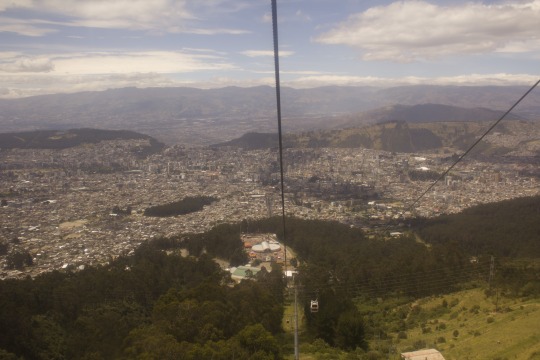
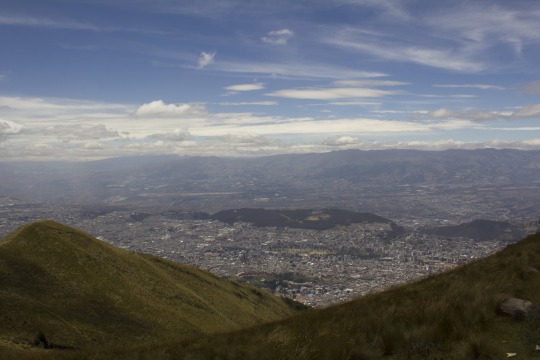
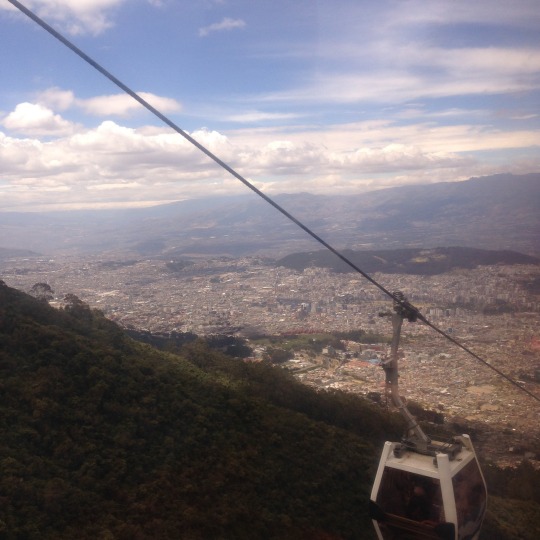
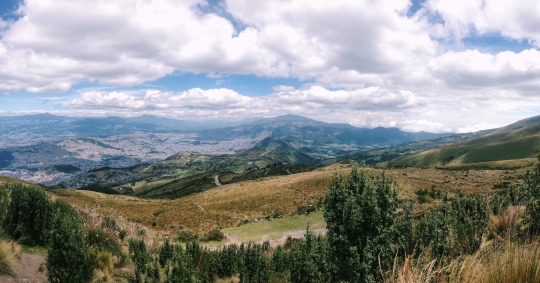

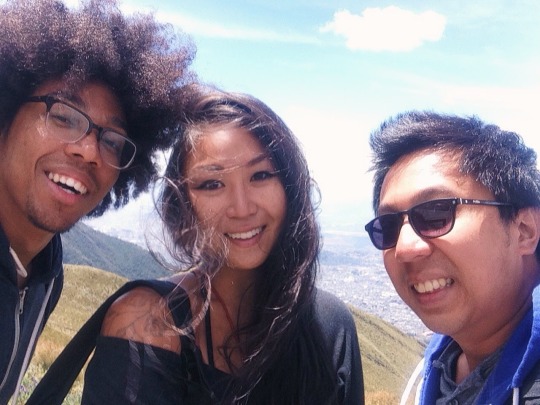

This is the part where I broke the “only take taxis with orange license plates” rule, since his taxi was actually a van. I know what you’re thinking, but it gets even weirder.. because once we got to the end of the winding road that leads up to the TelefériQo, he stopped the van, and opened the door. Then he explained that his brother Jesús would take us from here - his brother was parked in a burgundy 4-door, with his son in the back seat. Then he asked us, “is it ok if his son goes with you too?” Baffled, I nodded, and got into the front seat of the car. I know what you’re thinking. X and Will were thinking it too, as they reluctantly got into the back seat with this boy who couldn’t have been more than 10 years old. As we started to drive, X passed me a note on his phone that read, “this feels sketchy,” but for some reason, I trusted that everything was going to be just fine.
It was a silent hour-long ride to the Museo Solar Inti Ñan (Intiñan Solar Museum), but once we arrived, I think Will and X felt more relieved. Admission to the museum is only $4 for adults, and includes a guided tour in English or Spanish. Our guide was fantastic, as she took us throughout the museum grounds to teach us about the indigenous tribes of the Amazon, the dangerous animals and insects of the jungle, fun physics experiments to prove that we were standing at the center of the earth, and even live guinea pigs. Although the equator line has been remeasured, many people still consider this the true Mitad del Mundo (“Middle of the World”). In fact, if you bring your passport to the Intiñan Museum, you can have it stamped with a Mitad del Mundo stamp.
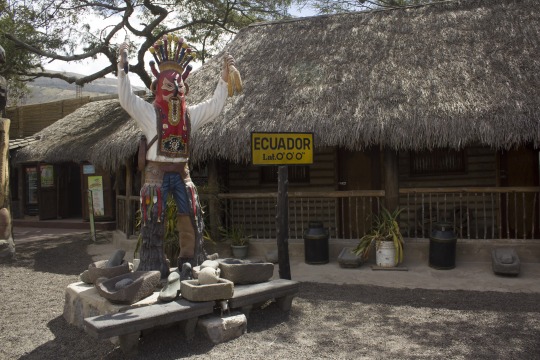
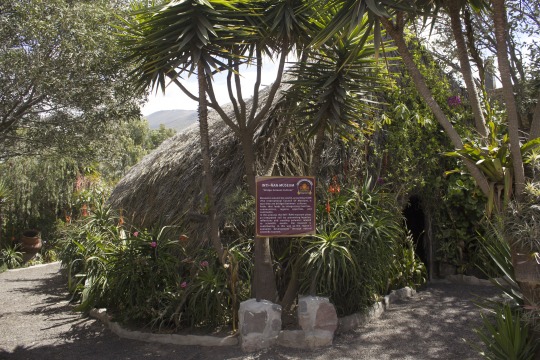
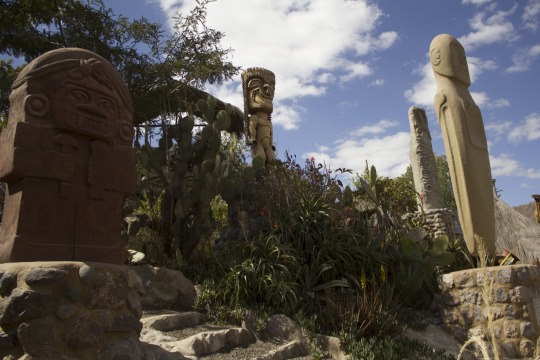


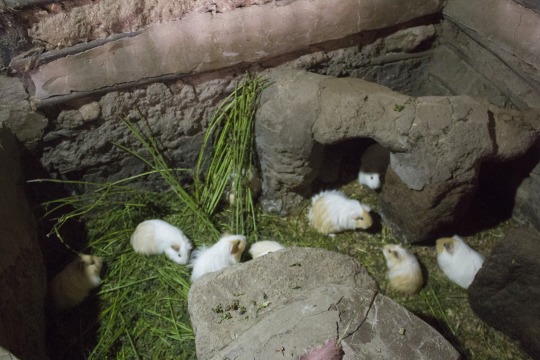
At the end of our tour, we got to learn about the origins of the cacao tree, the cocoa bean, and go through the process of making chocolate - including tasting a fresh cocoa bean taken out of a cocoa pod, and the end product of the dried cocoa bean that results in cocoa butter and cocoa powder. Then, we got to browse the wide assortment of Pacari chocolate, the first single-origin organic chocolate entirely made in Ecuador. The word Pacari means “nature” in Quechua, an indigenous language of the Andean region. I’m usually not a big fan of chocolate (I prefer salty snacks over sweets) but Pacari’s Café Cubierto con Chocolate (chocolate covered espresso beans) has made it into my top 5 favorite treats.
Our next stop was Volcán Pululahua, an inactive volcano in the Pomaqui Valley of the Pichincha Province that erupted 2,500 years ago, leaving a huge volcanic crater that has since grown green and lush. At 34 square kilometers, the volcanic crater is one of the largest in the world, with a lava dome in the middle that rises around 500 meters above the crater floor and is covered in cloud forest vegetation. Believed to be first settled by the Incas, Pululahua is one of the only two inhabited volcanic caldera in the world, and the only one cultivated by its inhabitants. Pululahua is Quichua for “Smoke of Water” or “Cloud of Water” which probably refers to the neblina (fog) which rolls in around midday every day and fills the crater. Because it virtually never rains at Pululahua, the fog is the only real source of water for the crops cultivated here, supporting cloud forests and many species of orchids and fertile farmland. For this reason, Pululahua was declared a Geobotanical Reserve in 1966 and is regulated by Ecuador’s Ministry of the Environment.
(source: ecuadortravelsite.org)
Visitors can descend into the actual crater of Pululahua but we decided to take in the view at El Mirador, the observation terrace near the south west side of the calder, before stopping into the gift shop where we picked up some souvenirs from a nice woman who tied matching woven bracelets onto our wrists (I haven’t taken it off since then). Afterwards, we headed to our last destination of the tour.

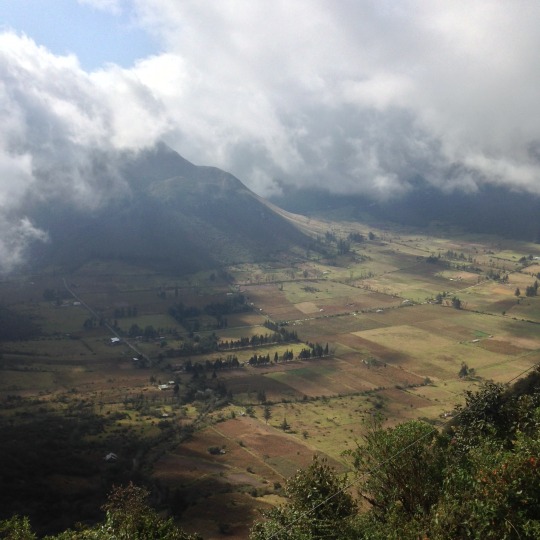
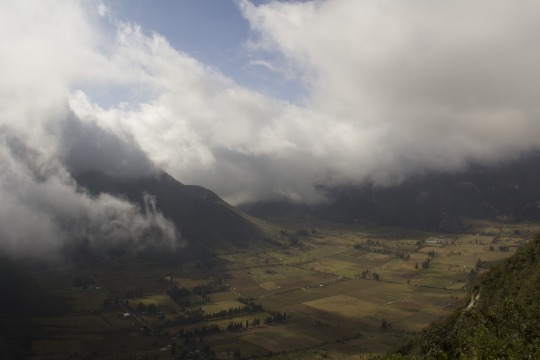
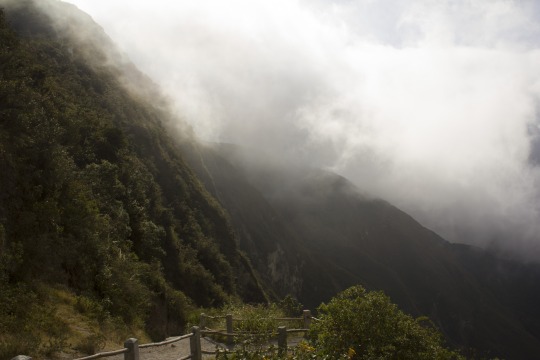
When Jesús pulled up to the curb of Ciudad Mitad del Mundo (“Middle of the World City”), he mentioned to me that since there is a fee ($3 admission) to enter the monument grounds, he and his son would wait for us at the curb. Mind you, I was only 4% fluent in Spanish at best, so most of the time, I could understand the general point of something but miss details. We got out of the car and walked up the steps to the monument entrance, towards the 30-meter-tall polished stone trapezoidal monument topped with a brass globe. The tower was constructed between 1979 and 1982 by Pichincha’s Province Council to replace an older, smaller monument built by Government of Ecuador under the direction of the geographer Luis Tufiño in 1936.
(source: Wikipedia)
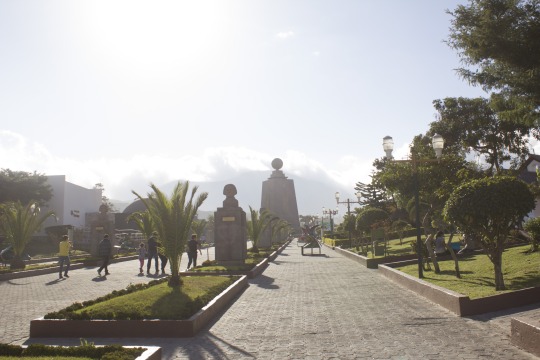
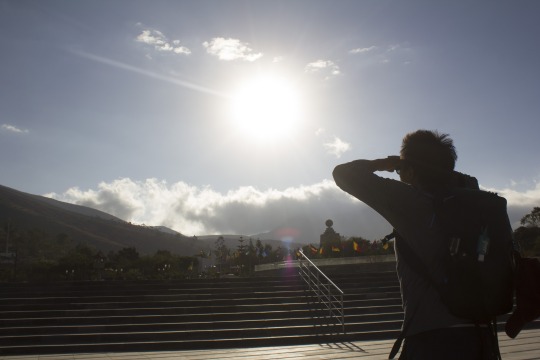
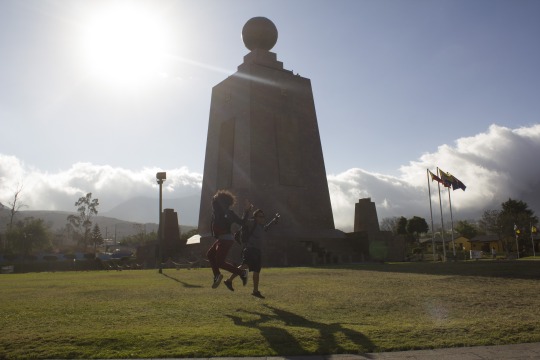
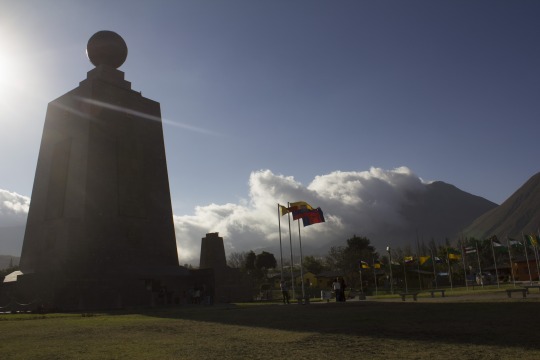
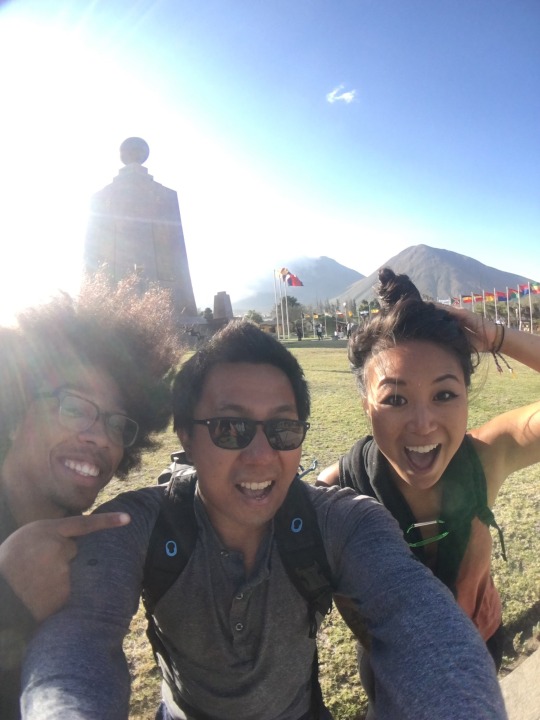
Exhausted from the long day, we headed back quickly after just few photos and a quick lap around the windy grounds, without even bothering to visit the ethnographic museum. But when we returned to the corner of the curb we had been dropped off, we couldn’t find Jesús. X and Will started to panic, thinking that he had driven off with our souvenirs and abandoned us. That didn’t make sense to me, since we hadn’t even paid him the tour fee yet, and we had all of our valuables with us. So we waited, as time crept by. The guys started looking around the parking lot, thinking maybe he decided to park and take his son inside, but the car was nowhere to be found. I started to worry a little too, but then I remembered we only spent about 10 minutes exploring the grounds, which he probably didn’t expect. I reasoned that maybe he took his son to get something to eat, or maybe the kid had to pee (I know I did). Just as the sun began lowering, and we were debating hailing another cab, there he was, pulling around the curb.. the boxy burgundy 4-door that reminded me so much of our old-school Toyota family car from my childhood. When he pulled up, I was ecstatic. I felt like I had just successfully proven that my gut feeling was right all along. When Jesús dropped us off at our hostel, we handed him $40 and some Pacari chocolate for his son. In return, he handed over his business card for Transporte Turistico - turns out he was legit all along. We highly recommend Jesús Guamán (WhatsApp: 0988 178 109, Email: [email protected]).
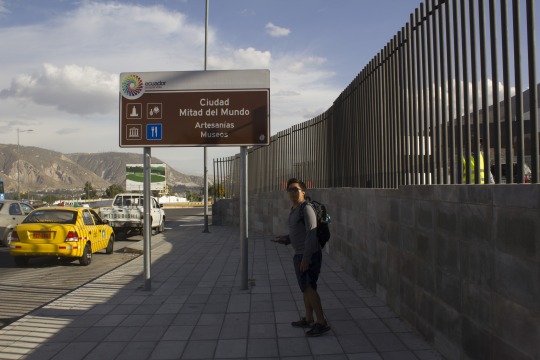
That evening, we met up with Nathan’s friend Sophie, who was born and raised in Quito and studied abroad in Boston where she met my brother on a salsa dance cruise. Luckily, Sophie shared the Chow family affinity for international cuisine and recommended that we try Hasta la Vuelta Señor, a classy sit-down restaurant with amazing authentic dishes from the highlands. We tried the festival de empanaditas, which was like a sampler that included a selection of small corn pancakes stuffed with cheese, two small puff pastries with cheese filling and two small meat filled maize pastries, which were all delicious. We also had the mote con chicharrón, which is boiled white corn with fried pork rind, and a few different drinks including jugo de naranjilla (my favorite) and chicha, a maize beer originating from the Andes.

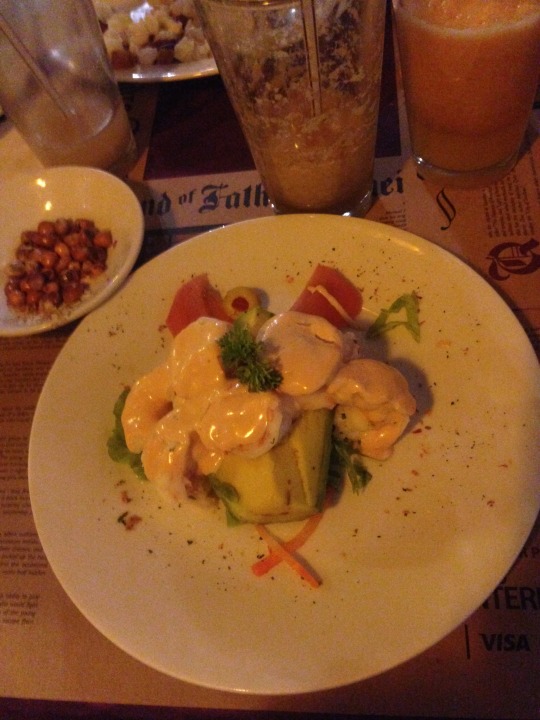
Luckily, our hostel was just a few blocks away from the restaurant, because by the time we left, we were all sleepy and cold. Sophie explained to us that in Quito, a range of seasons happen each day - from a hot sunny day in the afternoon to a chilly autumn night after sunset. Because of its elevation, Quito receives some of the greatest solar radiation in the world, meaning that even though it doesn’t necessarily feel overwhelmingly hot, the sun can easily burn during the day. Like its weather, the city of Quito offers a wide range of culture, from the club district of La Mariscal where we were staying, to the foothills of the Andes mountains. Sophie was born and raised in Quito, and by talking to her, I could tell how much love and pride she has for her city. We were lucky enough to share our experience with a native of the city. In fact, Sophie’s love for Quito was what inspired us to cancel our last leg of the trip to Otavalo and extend our stay in Quito instead.
Quito, formally San Francisco de Quito, is the capital city of Ecuador, and at an elevation of 2,850 metres (9,350 ft) above sea level, it is the highest official capital city in the world and the one which is closest to the equator. It is located in the Guayllabamba river basin, on the eastern slopes of Pichincha, an active stratovolcano in the Andes mountains. With a population of 2,671,191 according to the last census (2014), Quito is the second most populous city in Ecuador, after Guayaquil. In 2008, the city was designated as the headquarters of the Union of South American Nations. The historic center of Quito has one of the largest, least-altered and best-preserved historic centers in the Americas. Quito and Kraków, Poland, were the first World Cultural Heritage Sites declared by UNESCO, in 1978.
(source: Wikipedia)
8/5, Friday: DAY 15: QUITO
The next morning, I met with Ivan at the Juan Váldez Café at Plaza Foch again to explore the cathedrals of Quito. We took a taxi to the northeastern part of the Old Town, where Basílica del Voto Nacional (“Basilica of the National Vow”) looms high on the San Juan hill as the largest neo-Gothic basilica in the Americas. Rather than gargoyles, Ecuadorian animals like tortoises, iguanas, and armadillos protrude from the church’s side, decorating the high towers that visitors can climb after walking a wooden plank inside the main roof. Admission into the church is $1.50, and an additional $2 to access the towers. Inside the sanctuary, beautiful stained glass spills sunlight onto the cold concrete in soft pink hues that also graze fourteen bronze statues that represent eleven apostles and three evangelists. The real prize, however, is seen from the balcony and the rooftops, where we took in spectacular aerial views of the Old City and La Virgen de Quito in the distance.
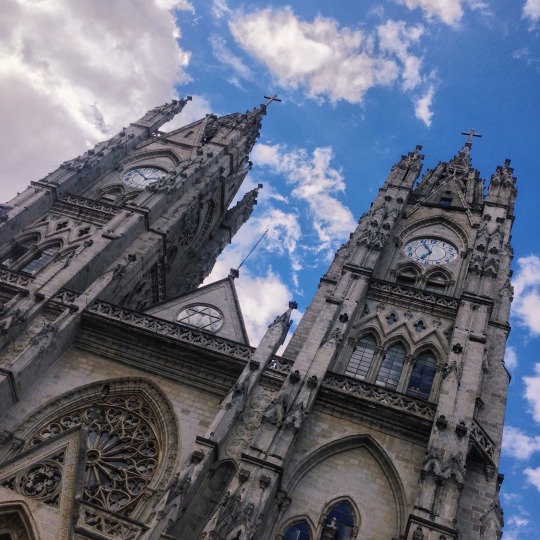
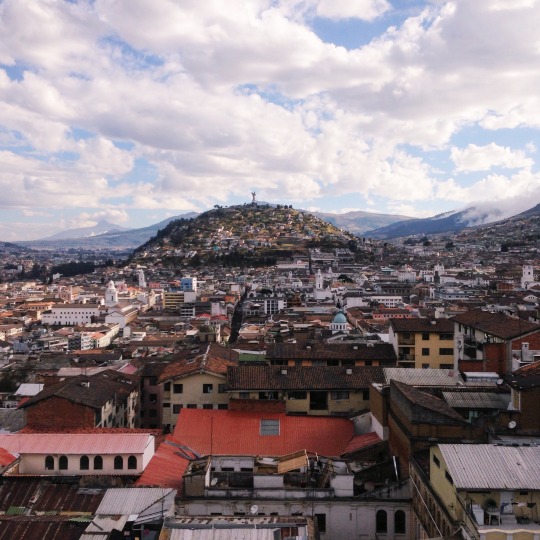

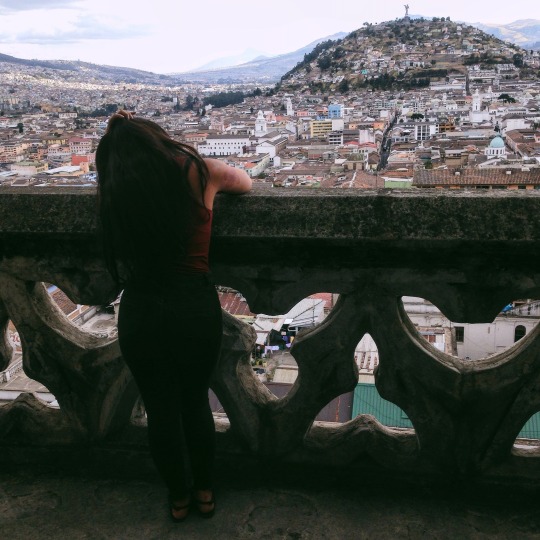
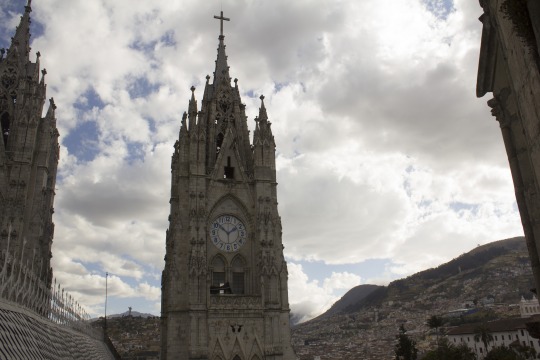
The basilica was proposed in 1883 by Father Julio Matovelle as a monument as a perpetual reminder of the consecration of Ecuador to the Sacred Heart, and by 1884 the president had begun budgeting for the construction. It wasn’t until 1892 that the first stone was placed, and finally by 1909, the Heart of Mary Cathedral was constructed as a religious commitment in the name of the country. The basilica was blessed by Pope John Paul II on January 30, 1985, and it was consecrated and inaugurated on July 12, 1988. The basilica remains technically "unfinished,” sunlight basking on the bare tresses that lead to the rooftop. Local legend says that when the Basílica is completed, the end of the world will come.
(source: Lonely Planet, Frommers & Wikipedia)
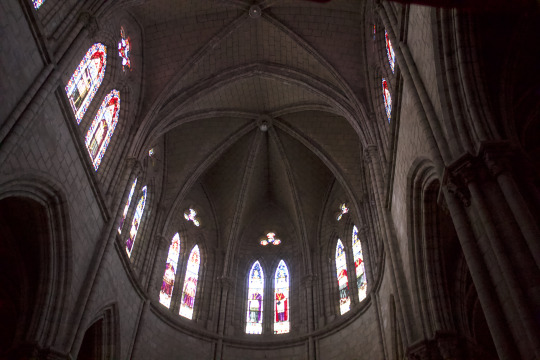
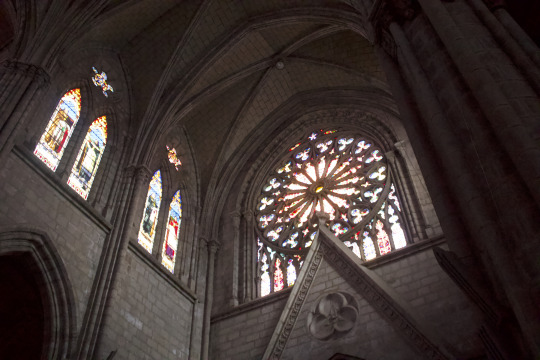

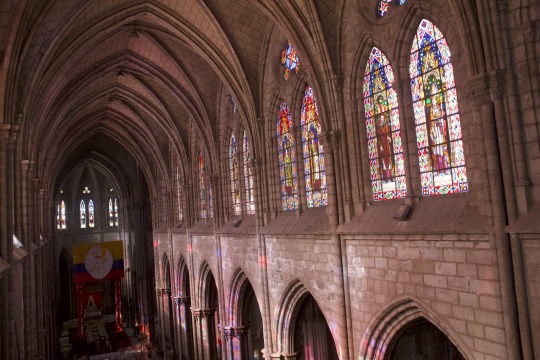
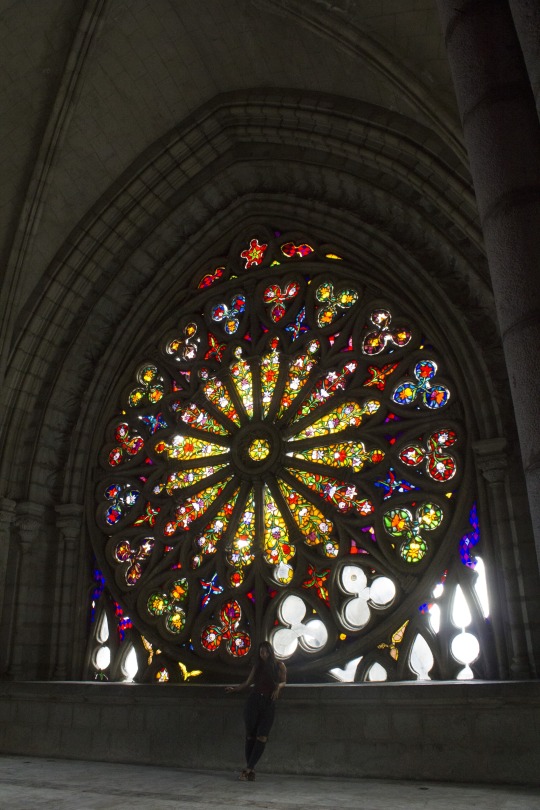
Our next stop was La Iglesia de la Compañía de Jesús (“The Church of the Society of Jesus”), better known as La Compañía ($4 admission). The Jesuit church is one of the most significant works of Spanish Baroque architecture in South America, known for its large central nave, decorated with gold leaf, gilded plaster and wood carvings after 160 years of construction from 1605 to 1765. The floor plan of this beautiful church forms a Latin Cross, creating perfect symmetry with its walls that drip with gold. Photography isn’t permitted, but rules are made to be broken, right? :)
(source: Wikipedia)
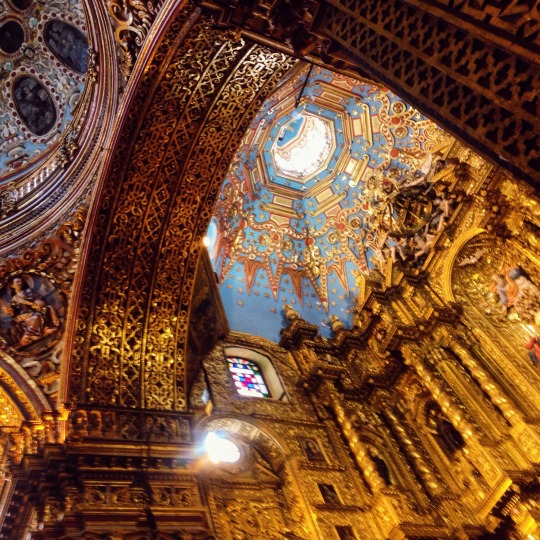
After our day tour around Old Town, we headed back to La Mariscal, where we split ways, and I went to meet Will and X for dinner plans with Sophie and her boyfriend. At first, we planned to meet at the food trucks at the corner of Avenue Mariana de Jesús & Av. Río Amazonas, which was just a short walk away from our hotel. But when we arrived, it was so crowded that there was barely any room to walk between the throngs of people, sitting on the pavement, on the curbs, standing around, framed by a perimeter of food trucks in a dark parking lot lit only by the fluorescent bulbs inside of the trucks. For a moment, I felt nostalgic - like I was in highschool again, going to the Grease Trucks in New Brunswick for the first time.
Once we spotted Sophie and she introduced us to her boyfriend Miguel, they suggested we head to another location with seating. We hopped into their car and headed over to La Platea, a beautiful little food truck stop at Avenue La Coruna. The area was decorated by recycled materials, crafted into adorable crate seating and unique artwork all around. Designed with a great use of space and much better lit than the previous location we tried, this spot felt more like Smorgasburg on a summer night in Coney Island, and it was just as crowded. Long lines stemmed from every single one of the trucks, leading into the central lounge where every seat was taken, whether it was a wooden crate, a bundle of hay, or a vintage stool. After browsing all of the delicious options, Sophie and I placed our orders at Cleto’s Burgers while we scanned the crowds for parties nearing the end of their meals, hoping to eventually poach their table. Finally, we were able to sit down and enjoy our dinner together before Miguel and Sophie drove us back to our hotel.
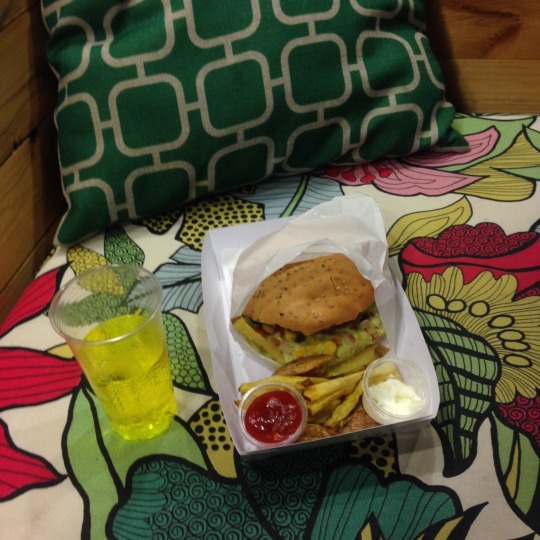
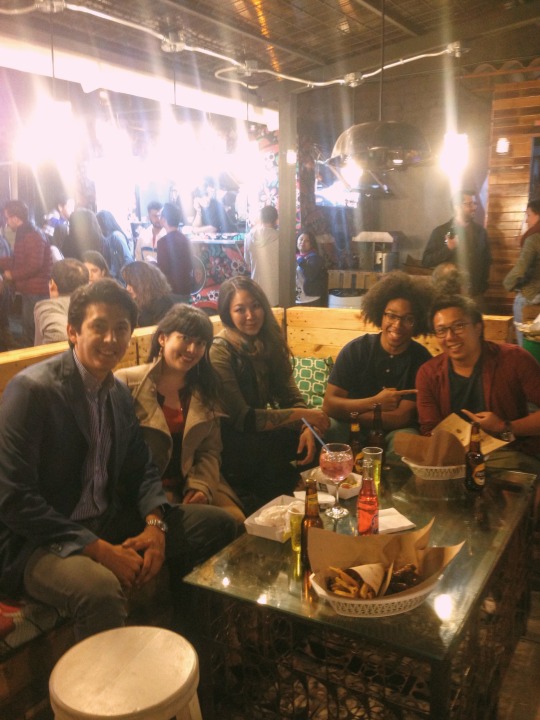
8/6, Saturday: DAY 16: QUITO
The next morning, we woke up just as the sun began to rise for a road trip to Cayambe with Miguel and Sophie. Since Miguel and Sophie live on opposite ends of Quito, Miguel must have woken up in the middle of the night to pick up Sophie before heading over to us. The drive to Cayambe was about an hour and a half northeast from Quito, towards Volcán Cayambe. Sophie and Miguel wanted to share one of their favorite restaurants with us: a place called Café de la Vaca that is well known in Quito for its delicious food, sunny ambiance, and fresh milk. Unfortunately since it was a weekend, it was extremely crowded, so rather than wait hours for a table, we enjoyed the beautiful green landscape surrounding the restaurant, played on the swings, and then headed out on our way to another local restaurant.
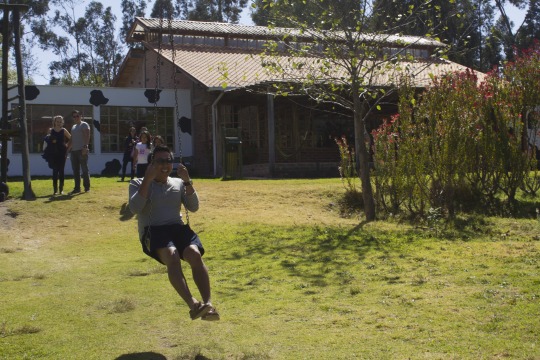
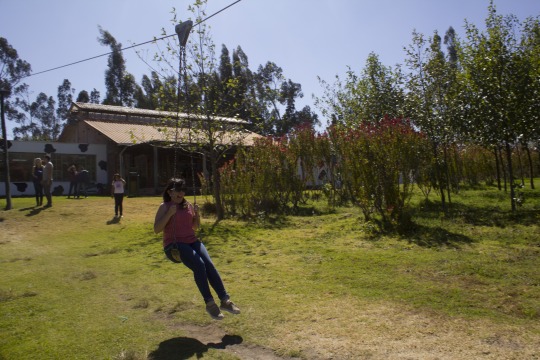
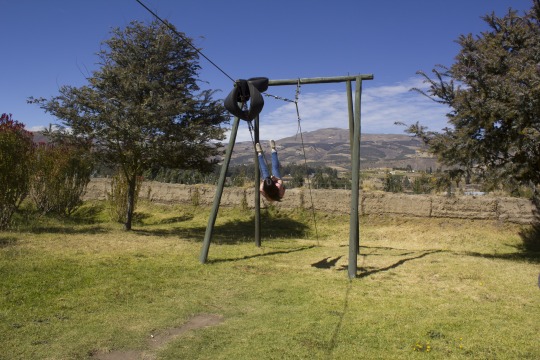
On the way through Cayambe, we stopped at Quitsato Sundial, a giant circular platform of a mosaic with light and dark pebbles drawing an eight-pointed star that indicates the solstices, equinoxes, and intermediate lines pointing to the cardinal directions. In the center of this platform there is a cylindrical orange tube which serves as a gnomon, pointing to the corresponding hours and months of the year in the platform according to the shadow cast by the sun. From here, we could see Volcán Cayambe, the only place where the Equator passes through a glacier and the highest point on the Equator in the world.
(source: Wikipedia)

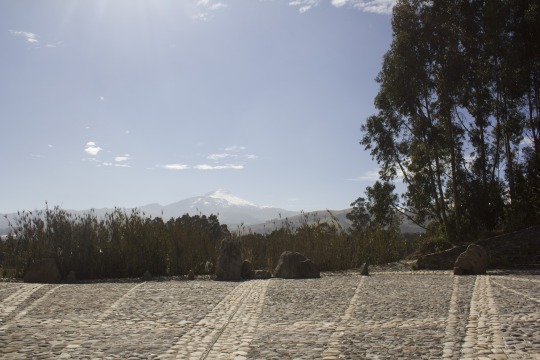
When we got into town, we stopped at Platos A La Carta for breakfast, where we shared queso de hoja and bizcochos (cheese and biscuits), a delicious Cayambe local favorite. We also ordered some other breakfast dishes, which came with drinks. I was so hungry and thirsty that I didn’t even think to smell the drink or ask what it was before taking a sip - which I would soon admit as a mistake when I realized it was pineapple juice. Turns out I’m still allergic to pineapples.
After getting sick, I was feeling exhausted, so we started to head back to Quito. On our way back, though, we spotted a restaurant called Guarango Zero advertising cuy, which Will, X, and I had not tried yet. Cuy is a delicacy in the Andean region where it was first domesticated as early as 5000 BC for food by tribes. The name cuy comes from the the indigenous language of Kichwa, because of the high-pitched bird-like sound the animal makes. In Ecuador, cuy was the main source of meat before cattle were introduced to the country, and became a status symbol because it meant you had enough money to eat meat as a luxury. Later, the animals were brought over to Europe by Spanish, Dutch and English traders in the 16th century and introduced as exotic pets because of their docile nature. Since then, the animals have adopted the name guinea pig, though the exact origin of the name is unclear.
(source: Wikipedia)
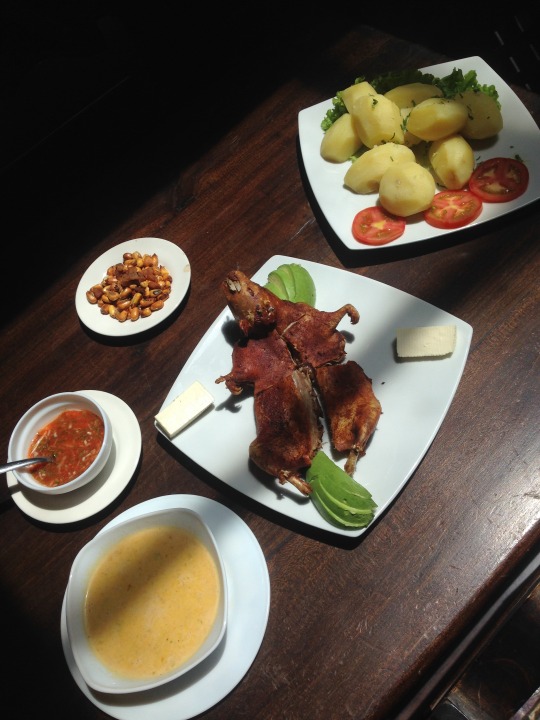
I know what you’re thinking - I’m a monster for eating an adorable little guinea pig. But to be honest, I feel like if you eat any kind of meat, that’s an unfair judgement. To me, all animals are adorable, but I also enjoy the idea of embracing all cultures, including native delicacies. I must admit that I struggled with the idea of dining on our first pet (R.I.P. Guinea) even before I left for our trip, and I still had my hesitations when the whole roasted cuy was placed on the table after an hour of preparation. But when you think about how cute baby chicks or piglets are and then devour nuggets and ribs without guilt, it seems silly to draw the line at an equally cute/edible animal. Anyway, I didn’t really enjoy the taste or texture - it was quite gamey and tough to chew, like dry jerky with a crispy skin. Apparently, the age of the cuy and preparation process plays a big factor into the taste, so I wouldn’t be opposed to trying it again, especially in colonial Cuenca, known as one of the best places for cuy.
Stuffed and sleepy, we headed back to Quito. After Miguel dropped us off, it seemed like we were all thinking the same thing - how incredibly grateful we were to have met Sophie and Miguel, and what amazing human beings they both were. It was so inspiring to explore their city with them, especially because because they love living there so much. We hope to share our home with them when they visit us in Jersey and NYC!
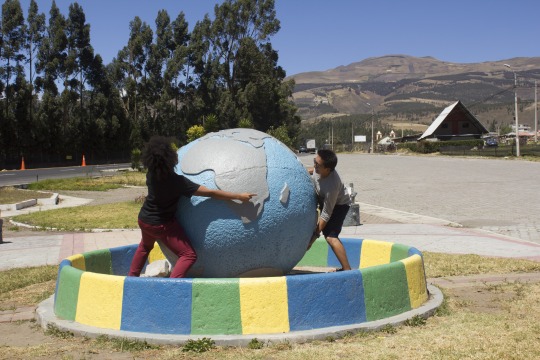

Suddenly it was our last night of the trip, and I was still on the hunt for my ultimate souvenir - a tattoo. I try to commemorate my experience in every country I visit with a tattoo, and if possible, I like to get them done in those places before I leave. Ivan had a friend who worked at Santería Tattoo Shop in Quito, so we headed there from La Foch to see if anyone was available. Leon, who was from Colombia and had been tattooing in Ecuador for years, gave me the most beautiful rose - the national flower of Ecuador - to keep with me as a reminder of my love for this magical place.
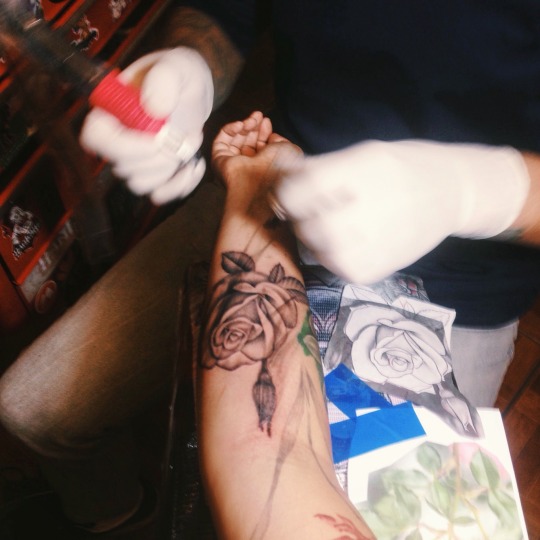
We spent our last night in Ecuador partying through the clubs Mariscal Sucre is known for, hopping from bar to clubs. It was during this evening that I began to talk to Iris more, and we realized how strongly connected we felt to each other, like we had been friends for years already. To this day, Irina is one of my closest friends, my soul sister, and my confidante. It is this feeling, of finding people who seem to be born from the same soul, that makes life so incredibly beautiful.
8/7, Sunday: DAY 17: QUITO
The next morning, we headed to the Mercado Artesanal La Mariscal for souvenir shopping/haggling before checking out of Hotel Cuba Vieja, where the receptionist called a taxi to take us to the airport. It was the end of our adventure in Ecuador, but somehow, I knew I would return soon..
0 notes
Text
How to Learn Japanese
Supposedly, there is no incorrect way to learn Japanese, (this could apply to any language), which is kind of true, but you can learn a language wrong. This often happens when self-studying. That is why almost anyone would recommend that you take a class versus buying textbooks and watching youtube videos.
Depending on your financial situation or what language classes your school offers, classes can be expensive or unavailable to some. In those cases, there are programs that are very helpful in learning languages. I’ve mostly heard of people using Rosetta Stone and Duolingo. Both have their downsides of course, but having known of people who used these programs and used one of them myself, they are very good programs I would highly recommend.
Because this post, and blog, is about learning Japanese, I want to talk about these programs for a second.
Rosetta Stone - Both my mom and best friend have used this to learn Spanish. They have told me that it is wonderful. The only downside to it is that is pretty expensive (roughly $80 for 3-months depending on which subscription you buy, but I believe you can but it in stores for $150), but there is a free app (available in both the Google Play Store and the Apple App Store). I personally would not recommend the app, at least for Japanese, because of how it teaches. I can’t compare the paid subscription to the app, but I can assume the subscription has much better lessons.
Duolingo - This program DOES NOT OFFER JAPANESE yet. From what I can see, they don’t offer languages that use a different writing system than the roman alphabet (excluding Russian, Greek, Hebrew, and Ukrainian). I was actually looking into if they were ever going to release a Japanese course and I found that people were applying to help create one. This was over a year ago so maybe within the next few years they will add it. Anyway, a few years back when I was in 5th grade I wanted to learn French (only because I had a huge crush on this girl who was learning French so she could move to Canada when she graduated, but that’s a story for another day). I used Duolingo for that really short-lived aspiration and was amazed at how great it was. Thinking about how they set up the lessons, it wouldn’t work all that well for Japanese. Granted, that was nearly 4 or 5 years ago so I’m sure that they’ve updated the site and app for the sake of languages with different sentence patterns and alphabets (back then they only really had French, Spanish, German, and I want to say English too). So just for this post, I have checked out the Russian course.
For the first 5 lessons, they teach you easy words to help you learn to read the letters in the Cyrillic alphabet. This is probably because it teaches you words while simultaneously teaching you the alphabet. It is also probably a good way to memorize the alphabet. Though, I hope that they do not teach Japanese in this format. It would be very hard to figure out which character sounds like what if it were taught in this way. Now, maybe they won’t teach it like this, because Japanese does have 3 writing systems and it would be pretty complicated. So, maybe they would have a lesson with just Hiragana and no basic vocabulary to avoid confusion.
Duolingo is a very great and interactive website/app per se; it does have the potential to be confusing and difficult once they release the Japanese course.
Memrise –This website/app I used when I wanted to study Polish because I had found out that I had Polish family. Like French, this aspiration was also quickly abandoned. The next year, though, I went back and found the Japanese course. Back then, before I knew anything about Japanese, I thought it was the best thing ever; it was basically my reason to live. Now that I know so much more about Japanese, I have found that it has some problems. Back when I first started to learn from this site, it was pretty accurate and even now I will admit that it was pretty spot on; though it had a few kinks. They have updated the course for Japanese since the February or March of 2016, which I have a few problems. Mostly with the way it teaches kanji. I would not recommend this site, but if you are desperate then go right ahead.
This is all I really want to explain but I do have some very helpful links that are very good and I highly recommend.
Websites -
http://www.tofugu.com/ - A blog about all things Japan including advice for travel and information about modern Japan and its culture.
https://learnjapanesepod.com/kana-invaders/ - A flash game that helps you read hiragana/katakana (note: it does not teach either hiragana nor katakana).
http://www.romajidesu.com/dictionary/ - A really good Japanese dictionary.
http://www.guidetojapanese.org/learn/ - The best guide about Japanese Grammar.
http://lang-8.com/ - A website that is good for language exchange where you post entries and native speakers correct it.
http://www.japan-guide.com/ - A travel guide to Japan that features forums for meeting language exchange partners.
https://hinative.com/ - THIS WEBSITE/APP IS LITERALLY THE BEST ON THIS ENTIRE LIST. BASICALLY, YOU CAN ASK QUESTIONS ABOUT A LANGUAGE OR COUNTRY AND NATIVE PEOPLE WILL ANSWER THEM. IT IS SO HELPFUL I RECOMMEND THIS TO EVERYONE.
https://www2.gwu.edu/~eall/vjg/vjghomepage/vjghome.htm - The 2009 blog site look is very off-putting I know, but the information on here is very useful and I highly recommend it.
http://www.sf.airnet.ne.jp/~ts/japanese/ - This one also looks very off-putting, but it is very accurate so I highly recommend it too.
https://www.erin.ne.jp/en/ - I’m sorry I keep giving you guys off-putting websites, but some are just very useful. I especially like this one because it shows videos of life in Japan. Also, it has a very attractive main character ;)
https://www.japanesepod101.com/index.php - This one is not my favorite, but I do recommend it to those who learn by listening. It does cost some money, but I believe most of the lessons are on their YouTube channel: https://www.youtube.com/user/japanesepod101
http://www.linguti.com/ - This website is okay. I would not really recommend it, but try it if you’d like.
http://www.fluentu.com/ - This one isn’t really my favorite either, but it has correct information. I personally just don’t like it.
Now I have a few YouTube channel and YouTube playlists I highly recommend.
Channels –
https://www.youtube.com/user/japanagos/videos - She makes videos about living in Japan.
https://www.youtube.com/channel/UCC1BNMUl5dnju1b9oKpkysg - I absolutely love her videos. She tells it like it is. No sugar-coating.
https://www.youtube.com/channel/UCf-4NeJ3ACc0e-md-dPgkbg - Really cute videos about Japanese grammar.
https://www.youtube.com/channel/UC4yqcgz49APdbgj0OMv7jpA - Okay they are some of my favorite YouTubers. They are everything to me and I absolutely love them. They make travel videos about Japan and even their everyday lives in Japan.
https://www.youtube.com/user/SakuraKisetsu/feed - I don’t believe she is still active, but she made some fantastic videos about foreign exchange to Japan.
https://www.youtube.com/channel/UCn7LyBvG5LEBXK9I4W5dGdA - Okay his channel has been the most helpful to me. He has and email list where he sends you videos for learning Japanese which has also been very, very helpful to me.
https://www.youtube.com/channel/UCAKZ2vtm_-hfqeCGTNNbZqA - She makes really nice and relaxing videos about her life in Japan.
Playlists –
https://www.youtube.com/watch?v=NMWtgWZW3xs&list=PLlVKLlsN46LjjaxOBew6RDqAClyts84qV – Useful Japanese vocab. She also makes videos about life in Japan.
https://www.youtube.com/watch?v=rGrBHiuPlT0&list=PL4071737C12790477 – I really enjoy this playlist because she has a very sweet and relaxing voice so I highly recommend this playlist.
https://www.youtube.com/watch?v=eSrpkd8X4MQ&list=PLF97A549D60C2EBA4 – same channel as mentioned above. Also really nice.
https://www.youtube.com/watch?v=RsrakMT1h2g&list=PLOcym2c7xnBwRNLWXOAtlN-9dbLkctxV- - I can recommend a few playlists from his channel. His videos are very helpful.
https://www.youtube.com/watch?v=DgxJGFrg81w&list=PLOcym2c7xnByT4AIn-YSx2ela7hqrcooA – The videos are only 5 minutes long so it is perfect for those of us with short attention spans.
https://www.youtube.com/watch?v=hbwm4y_-9i4&list=PLRBK-xsBhJkhXsxROfLODIABlhl5B37bg – Videos about foreign exchange made by a very cute German girl.
https://www.youtube.com/playlist?list=PLB3F2C5D8B5F81F34 – A pretty nice video series to help learn Japanese. It looks a bit outdated, but the language is still the same.
https://www.youtube.com/playlist?list=PLoQqjygELxS_D5w47MEQRA3DH5rV4qVJB – Video lessons about Japanese that textbooks normally wouldn’t teach. I also really recommend his channel if you like anime related content.
0 notes